#so this was already in the public consciousness in a bigger way before this episode aired
Explore tagged Tumblr posts
Text
I will say: it is a testament to Delainey Hayles, the show writers, the other actors, and even the original book itself, that Claudia's death was THIS gutwrenching for us all, despite having originally being written & published almost 50 years ago.

Like, I knew this was coming. I first the read the book twenty years ago. I've seen the film adaptation. Lots of people who watch the show have. And yet it feels like we're all still in collective mourning all the same, and that's powerful.
#interview with the vampire#iwtv#delainey hayles#claudia de pointe du lac#claudia de lioncourt#louis de pointe du lac#lestat de lioncourt#spoilers#i've seen red wedding comparisons#but even that doesn't feel like a close fit#I think more people have read IWTV than A Storm of Swords#or at least seen the film#so this was already in the public consciousness in a bigger way before this episode aired
290 notes
·
View notes
Text
Some initial thoughts on Moon Knight:
I will start off by saying that a lot of people are really loving the show and are excited to have positive DID representation, and I'm happy for those people. I haven't seen it and haven't decided if I ever will, but from everything I've heard so far the first episode was overall really good. A few elements were overly exaggerated or dramatized, but apparently it was fairly accurate representation, which is great. And for once the character with DID is a likeable, sympathetic hero instead of a serial killer, which is fantastic news.
But honestly I'm just dreading the fact that DID will become the New Thing that everyone wants to talk about and have an opinion on. Marvel is so huge and so it's going to become part of general culture in a much bigger way than it was with Split or other previous DID media. I'm already seeing it, and I'm not that happy about it.
Honestly, on a selfish, personal level, I don't want people without DID to be interested in it or learn about it. I don't want "representation." I want to go back to how it was a few years ago, before TikTok, when I had to personally explain DID to people I was telling about my diagnosis. Because there is so much misinformation out there, and it's so easy to find that when you're doing research, and honestly these days when someone knows about DID it immediately makes me worry that they have a very different idea of what DID is from what I actually experience.
And it's not just misinformation that's the problem. It's that even amongst different people with DID you'll find vastly different interpretations, but people are terrible at acknowledging that and tend to present their experiences as The One Way DID Is. A lot of people doing DID advocacy emphasize the idea that different alters are literal different people/consciousnesses sharing a body, an interpretation that doesn't connect for me and in fact makes me very uncomfortable. There are people out there who find the term "alter" to be dehumanizing and offensive, and prefer terms like "headmate," while other people find terms like "headmate" trivializing and prefer "alter." There are intense debates about these topics and many others within the DID community, and you'll never be able to find the actual answer for a lot of it, because it comes down to personal experience and personal preferences.
But in an attempt to explain DID to new audiences a lot of things that are actually very personal are being presented as factual, and I worry that that will only continue and increase as DID becomes more and more a part of public conversation. And I'm really not looking forward to that.
#my post#text post#you know what i've decided this is okay to reblog as long as people are civil#and i'm even going to put it in public tags#although not moon knight tags bc people in those tags are probably looking for positive content#actuallydid#actually did#dissociative identity disorder#likes are nice#replies are cool#reblogs are cool
195 notes
·
View notes
Photo

Chameleon.
For Japanuary, J-horror auteur Kiyoshi Kurosawa talks to Aaron Yap about upending genre expectations with his dreamy new travelogue To the Ends of the Earth, the unconscious connections between his films, and how it’s time for a proper evaluation of Robert Zemeckis.
Kiyoshi Kurosawa’s continued, uncontested position as a horror auteur isn’t unjustified. Emerging as a key voice in the J-horror boom of the late ’90s, Kurosawa hypnotized us with his chilly, haunting, atmospheric—and often apocalyptically tinged—visions of baffling serial killers, ghosts in machines, insidious doppelgangers and vengeful apparitions.
Bong Joon-ho once called Kurosawa’s 1997 mind-bender Cure one of the greatest films ever made. Pulse, his terrifyingly prophetic 2001 film, for my money—and many Letterboxd members’—might still be the creepiest of all contemporary horrors. “It is the only film I’ve ever seen in which every single shot feels genuinely haunted,” writes Connor.
Rarely behaving in a traditional scary-movie fashion, Kurosawa’s idiosyncratic horror films often test our expectations of genre, then deliver beyond those boundaries to probe his recurring themes: identity and isolation, humanity’s relationship to technology and nature, and deep-seated anxieties that nibble away at society’s crumbling fabric. Pulse, besides being an exercise in deftly crafted dread, is a great, telling, melancholy movie about the overwhelming loneliness of the digital age.

Yoko (Atsuko Maeda) and her travel show crew in ‘To the Ends of the Earth’.
However, the general focus on his horror “side” tends to eclipse a filmography that’s far richer and more versatile than he’s usually given credit for. Over the past two decades, we’ve seen him seem forge a thrillingly chameleonic, unpredictable path that’s included an ecological thriller (Charisma), an Ozu-esque family drama (Tokyo Sonata), a metaphysical romance (Journey to the Shore) and an alien invasion sci-fi (Before We Vanish). No one is really doing it like Kurosawa, and To the Ends of the Earth is arguably his most exciting and enigmatic left-turn yet.
To the Ends of the Earth is a commissioned piece to celebrate the diplomatic relations between Japan and the Central Asian republic of Uzbekistan, but that doesn’t diminish that it’s unmistakably a Kiyoshi Kurosawa film, not a tossed-off, exoticized, postcard-pretty travelogue. His signature languorous pacing, shrewdly slippery tonal calibration, and acute spatial sensitivity are at full bore, servicing a loosely plotted tale of TV travel show host Yoko (former J-pop singer Atsuko Maeda) and her crew attempting to complete shooting an episode in the Uzbekistan capital of Tashkent.
If anything, this movie should really confirm him as a filmmaker of bold, fictive playfulness in a comparable register to Jacques Rivette, Olivier Assayas and Christian Petzold—something that 2013’s hour-long, similarly fish-out-of-water head-rush Seventh Code, also starring Maeda, hinted at. In To the Ends of the Earth, gentleness, compassion and dream-like bursts of song and fantasy percolate through a disquieting maze of displacement—cultural, artistic, gendered—and the result is an adventurous, unpindownable, thoroughly humanistic work of curiosity and imagination.
Some years ago you did a “double feature”-themed interview with the Belfort Entrevues Film Festival where you revealed the sources of inspiration for some of your films. What film, if any, was a chief influence for To the Ends of the Earth, and can you tell us in what way? Kiyoshi Kurosawa: When I make my work, I often consciously refer to films from the past, but that’s usually the case with genre films. For example, Cure was greatly inspired by The Silence of the Lambs. However, To the Ends of the Earth is not a genre movie, so I wasn’t consciously thinking of any specific films. However, the composition of the story, that the main character appears in every scene, is based on films by the Dardenne brothers. Viewing their films The Child and Two Days, One Night, it’s clear to see how the depiction of just one person can turn trivial incidents into something serious and suspenseful.

Atsuko Maeda and Kiyoshi Kurosawa on the set of ‘To the Ends of the Earth’.
Watching Bright Future, To the Ends of the Earth and Creepy back-to-back recently, I noticed several parallels and motifs which may or may not be intentional. For example, a jellyfish makes an appearance in a scene on TV in Creepy, or there’s a TV report of a blaze in To the Ends of the Earth that momentarily hints at a bigger natural catastrophe that echoes the jellyfish swarm in Bright Future, or other apocalyptic moments in your films like Charisma and Before We Vanish. Do you find that some of these motifs work on a subconscious level for you, or were some of them intentionally threaded in? It’s a very interesting point. Some of them were intentional and some were not at all. It’s true about jellyfish, they appear in both Bright Future and Creepy. However, this is the first time I’ve noticed. The endings of Charisma and Before We Vanish were already written in the script by necessity, so of course, it’s intentional. The depiction of the blaze on TV in To the Ends of the Earth was introduced to show something happening in Japan while the main character is taking a small adventure in Uzbekistan. I wanted to show that her boyfriend was in some kind of crisis there. While the fire on the TV is merely an accident, it does appear apocalyptic. I may have overdone that a bit. Perhaps some kind of unconscious thinking was at work.
That amusement park ride scene in To the Ends of the Earth has stayed with me in the way it suggests terror out of something seemingly mundane. What are some scenes from other films that have stayed with you? The amusement park ride scene wasn’t introduced to express terror. What I wanted to show was how crazy the assignment is and Yuko’s professionalism. She takes on the assignment without fear. This may have been a bit overdone as well. However, I thought that Atsuko Maeda, who didn’t hesitate to actually ride it three times, was a real professional. Apart from that, if I think about the movies that force people to experience horror, what comes to me are Roger Corman’s Pit and the Pendulum. Tobe Hooper’s The Funhouse, George Miller’s Mad Max: Fury Road. I also remembered the episode in Freddie Francis’s Torture Garden, where a grand piano has a will to kill people, which was great.
Your films tend to be very location-based; environments and spaces appear to play a significant part. The pandemic has been the ultimate test of our relationship with spaces and each other. How has the pandemic impacted you as a filmmaker, and are there themes and ideas that you are interested in exploring further as a result of Covid? As you pointed out, when I make a movie, I pay great attention to the location. The moment I find a good location, I feel that the script will be transformed into a movie. It is the moment when fiction and reality are fused. It’s hard to say anything though, I haven’t made a movie since the pandemic started. What I can say, at least, is that sitting in front of the computer at home is not cinematic at all. So far, I don’t feel that something new will be born from it. What should I do? After all, I feel that a movie can only be made by going out in the city with a camera after utilizing the best epidemic prevention system possible.
If you had to pick a film that’s a personal favorite, which would you pick, and why? It's too difficult a question. Japanese movies and foreign movies have different viewpoints. Also, there are completely different categories of movies [that] greatly influence me when I make films and the movies I saw when I was young that make me nostalgic. It’s impossible to choose just one. But, well, the one that comes to mind is Sam Peckinpah’s The Ballad of Cable Hogue, which is both nostalgic and heavily influential for me.

You’ve spoken about your fondness for American filmmakers like Tobe Hooper, Robert Aldrich, Steven Spielberg et al. Are there new, or more recent American filmmakers and films that have caught your attention or that you’re particularly excited by? I don’t know much about young American directors, but what I always care about is Alfonso Cuarón. Of course he is not a new, young filmmaker, but an auteur. Also, since this is a good opportunity, I’d like to mention Robert Zemeckis. He made such masterpieces as Cast Away and What Lies Beneath around 2000. For some reason, he has never been properly evaluated at all. For a time he was devoted to animation. However, he made a spectacular return to live-action films with Flight and continues to shoot unique masterpieces like Allied and Welcome to Marwen. Of course, not many people appreciate these works. However, he does not seem to care about public opinion at all and continues to boldly shoot new works. Perhaps Zemeckis is the American film director who makes the most authentic films today.
What are your movie-watching habits like? Do you continue to watch movies on physical media or prefer streaming these days? What was the last movie you saw in a theater? Basically, I like to watch movies at an ordinary movie theater in the city the most. When I can’t go to the movie theater, or even though I know the film is going to be boring but I have to watch a movie for business, I have no choice but to watch it on DVD or Blu-ray. Of course, I also use VOD once in a while. The last movie I saw in the theater, as of today, was the Japanese film The Voice in the Crime. I saw that just yesterday. I saw it with my wife at a cinema complex in Shinjuku, Tokyo. It was the latest work by the director who made the previous masterpiece Flying Colors, and I expected much from it. It was speedy and quite well done until the middle of the film, but by the ending, it was too boring. Unfortunately, it wasn’t a good movie.
What’s a memorable film-related moment from your childhood, perhaps something you experienced with family or friends, or a film that scared you or made you cry? The movies that my generation often watched growing up were mainly monster movies. The most unforgettable one was Matango. Like Godzilla and Mothra, it was directed by Ishirō Honda. I went to see this movie with my friends. It had a rather cute touch in the promotional materials depicting a mushroom with a monstrous appearance. However, the content was completely different from a normal monster movie. Shipwrecked survivors on an uninhabited island encounter monstrous mushroom creatures washed up on the shore. These are not unknown creatures such as Godzilla or Mothra, but the horrifying ending of a human being. The characters are being infected, changing one another into mushroom humans. All of us children trembled from the bottom of our hearts. In retrospect, the work is an extreme horror aiming along the same line as [Howard Hawks and] Christian Nyby’s The Thing from Another World. It was probably the first time I encountered horror which was not “to escape from destruction” but “when a human being becomes something not human”.
Is there a filmmaker or film you think about a lot that you don’t get to talk about much and would like to show some appreciation? I haven’t talked much about the Battles Without Honor and Humanity series directed by Kinji Fukasaku. I don’t know how well this series of Japanese movies is known abroad, but when I was a high-school student I saw this and quickly became a big fan. I’ve watched a variety of yakuza movies since then, and it’s safe to say that nothing beats this series. As the title suggests, the films depict a yakuza world without “Jingi” (yakuza’s moral code), and it was really humorous and exciting to see the betrayals and the destruction. After I saw this, all those traditional yakuza movies dominated by the strange ideology of “Jingi” looked like a childish fantasy.
Related content
The Japanuary Challenge 2021
Explore more J-horror, ’80s J-horror and ’90s J-horror
Follow Aaron on Letterboxd
‘To the Ends of the Earth’ is available for rental in the US via distributor KimStim. From February 5-25, Japan Society’s virtual cinema hosts ‘21st Century Japan: Films from 2001-2020’, featuring films from Hirokazu Kore-eda, Naomi Kawase and Takashi Miike, the online US premieres of Sion Sono’s ‘Red Post on Escher Street’ and Yukiko Mishima’s ‘Shape of Red’, plus a special focus on Kiyoshi Kurosawa (‘Bright Future’, ‘Journey to the Shore’, ‘Real’).
#Kiyoshi kurosawa#to the ends of the earth#j-horror#j-horror films#japanese films#japanese cinema#japanese horror#japan society#japanuary#letterboxd#sion sono#tokyo sonata#robert zemeckis#aaron yap
5 notes
·
View notes
Text
props to the bh6 writers. What will happen next? a discussion on season 2 episodes 1-5, warning spoilers ahead
i gotta say we’re not even half way thru the second season and i can already tell that the bh6 writers have really outdone themselves. The story is much darker than the first season and the villains of the show have developed into more sinister versions of themselves.
but out of all the villains so far, the big MVP of this season is definitely Liv Amara. Not gonna lie, i didn't know how they would play liv out in the show, or if she would even be played off as an even bigger threat than Obake, but oh boy do they know how to write a good villain.
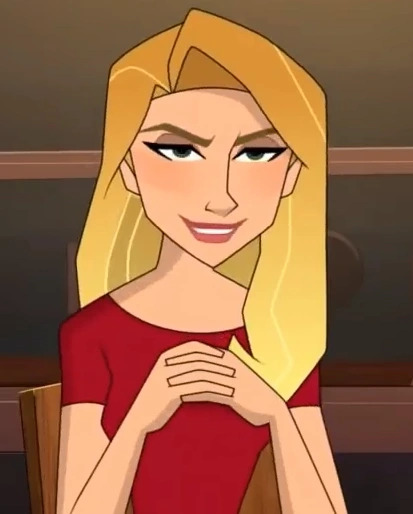
liv amara is more cynical compared to Obake, and unlike Obake who was originally good, but due to a deathly explosion that caused him brain damage, he was left with the inability to tell right from wrong, so he was not consciously aware of the fact that he was doing something he didn't want to do. Liv Amara on the other hand has no such brain damage and is fully aware of the fact that she is doing inhumane things and doesn't care who she brings down if it means she can accomplish her goals, but just what are her goals to begin with? thats the other thing that the writers are doing so well, keeping the mystery behind liv amaras plan a secret but still laying it out bit by bit to keep having us guessing
so far from what we have seen, Liv Amaras generous funds do not just come from investors seeking to support her work, rather they mostly come from shady villainous people who will have no issue supporting her insane experiments. In season 2 episode 2, Liv meets up with Momakase to talk about her “investing” funds for a specific top secret project she is currently working on at sycorax. We do not know what this secret project is but it is no doubt something that she cant just show to any investor with a good conscious
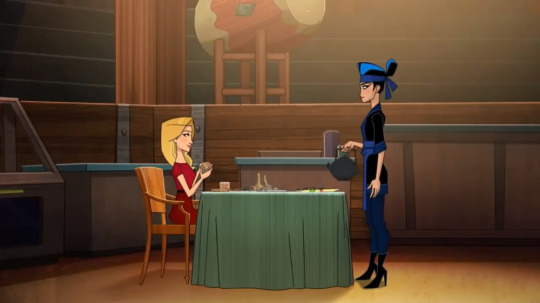
However, that doesn't matter to villains that have done equally horrid things and wouldn't mind giving Liv the cash she wants if it means that they could benefit from her skills as well. And, as we later learn near the end of the episode 2, (thanks to a mysterious chip liv inserted into her neck) momakase can now produce indestructible knives from the tips of her fingers
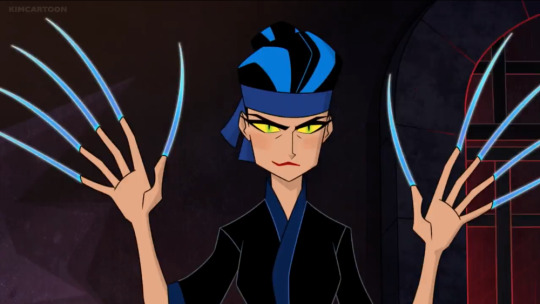
since it is clear that Liv is responsible for the mutations this season the only questions now is, what is Liv Amaras end game?, what is her “top secret project” and what do those chips mean for the people she is mutating.
first lets talk about the chips. Its clear that the chips reprogram a persons DNA and can cause specific mutations at the persons request. My only question is, are these mutations permanent ? orso knox in season 3 episode 3 was able to return back to normal thanks to karmi, but as liv amara states ( as she effortlessly blackmails him), she has the power to return him back to his monstrous form whenever she likes.
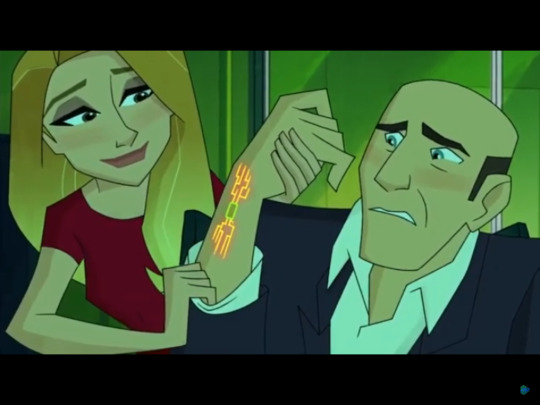
if these chips are removed will the persons abilities be removed along with them? or do they become inactive once the person has fully mutated, leaving their only chance to return to normal a series of treatments to splice their DNA back to normal. Regardless of who it is, once its embedded in a persons skin all it takes is for liv to activate it.
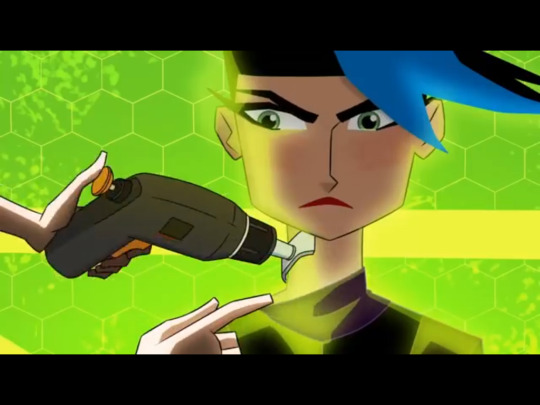
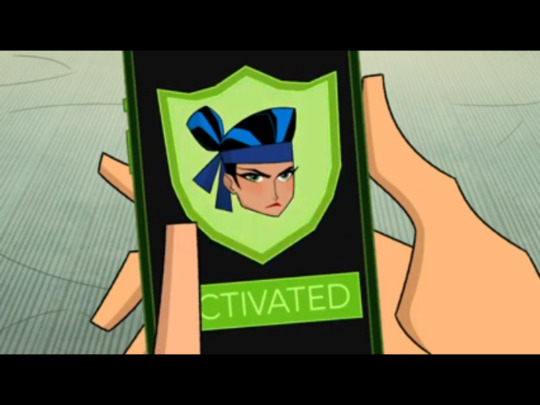
next, lets talk about this “top secret project”, in episode 2 liv shows the top secret project file to momakase. This project may be what gave momakase the idea to have liv turn her into a knife wielding super monster, so its clear that the plan involves some kind of human genetic mutation.
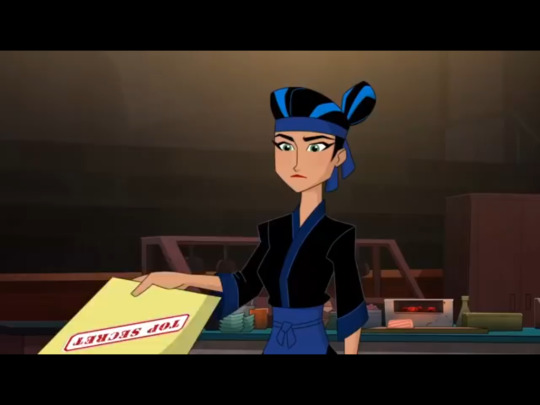

In episode 3 (out of hiros constant bickering to figure out livs actual progress on orso knox) karmi finds out that she cant access the knox file, then directly goes to livs office to ask about why she cant access the info related to orso knox.
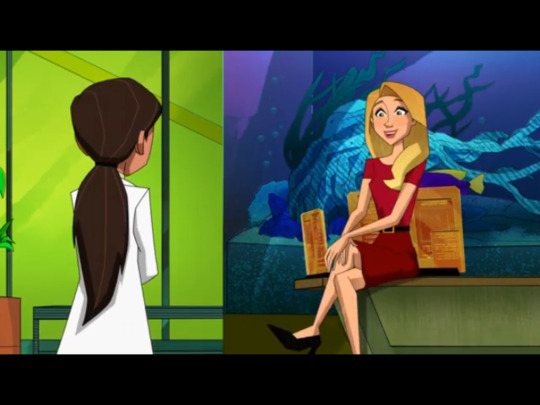
before karmi reaches livs office we get a clear shot at some of the files on her screen and what we see are base pairs for parts of someones DNA (maybe orso knox, momokase or someone we haven't seen yet) and what is clear in those pictures is that there are parts blackened out, as if to show that something is missing.
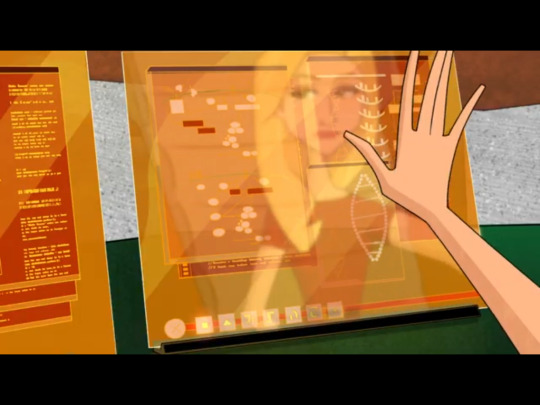
We see this same DNA in episode 4 when liv meets high voltage, the dna strand is visible as a hologram on her desk and is again missing certain pieces.

When karmi looks at the DNA sequence of mutated orso knox in episode 3, she notes that the base pairs in his DNA are not similar.
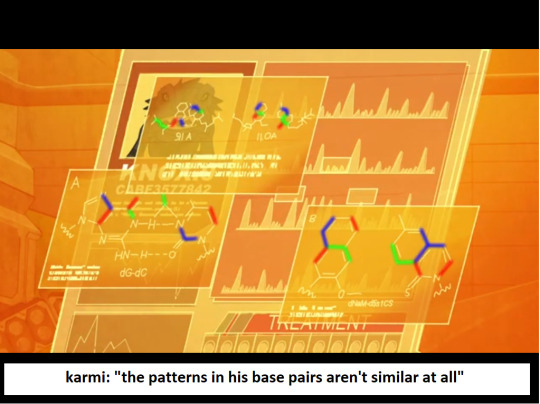
For those of you who have a hard time understanding this, basically imagine DNA as a ladder split down the middle, the steps that make up the middle part of the ladder and allow people to climb it normally are different shapes on both sides but when they come together they make a proper ladder,

in order for DNA to produce a functional human being the DNA base pairs need to match. Those regions of his mismatched DNA are being caused by a specific area somewhere else in his DNA, and so long as that specific region remains orso knox continues to lose more and more of his humanity as his DNA continues to produce that mismatched areas.
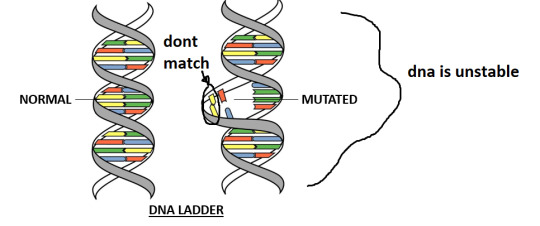
We can clearly see this occurring with Momokase as well. When momokase escapes the teams combined attacks near the end of episode 2 we see that she has now developed blue skin, sharp teeth and wild and unruly hair,
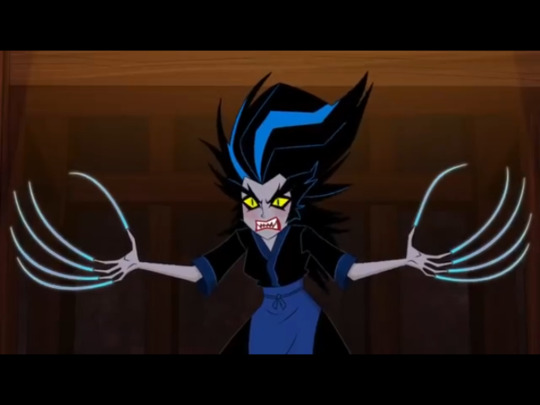
even more noticeably is when she runs in the direction of hiro. She doesn't try to attack hiro and granville now that they are vulnerable without baymax and the others there to help, instead she makes her way to the pillar behind them to escape and gives them an angry hiss/growl before leaving.
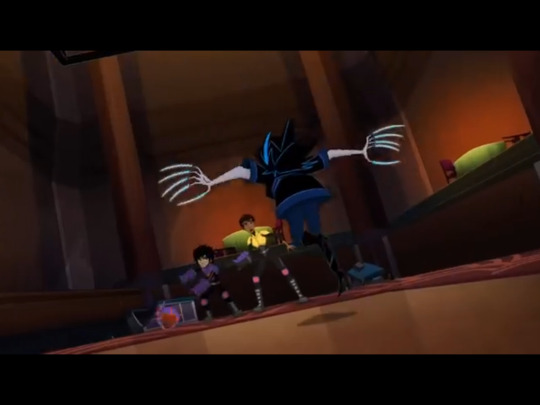
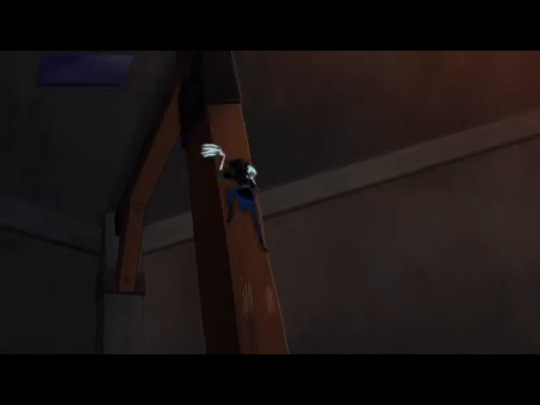
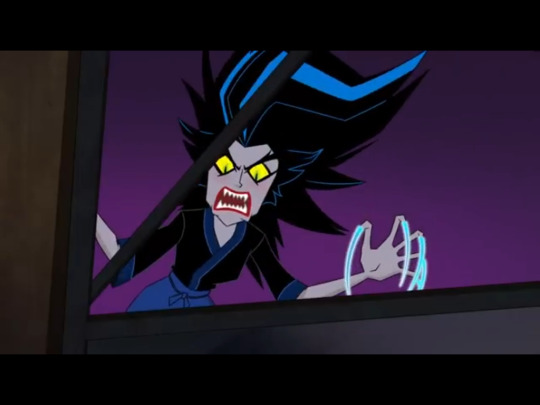
In episode 4, high voltage undergo the same procedure as momakase but transform at a slower rate. Later on when they crash a high school dance, they become fully mutated eel people
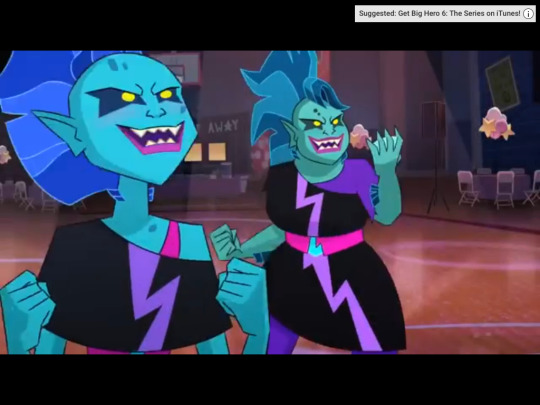
once high voltage gains the upper hand to make their escape, what do we see them do? they dont just escape, they escape and without a second thought they immediately go to liv amara, now fully mutated into eels and living in her office aquarium!!.
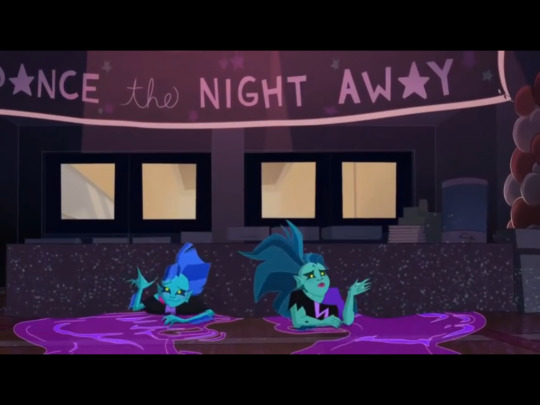
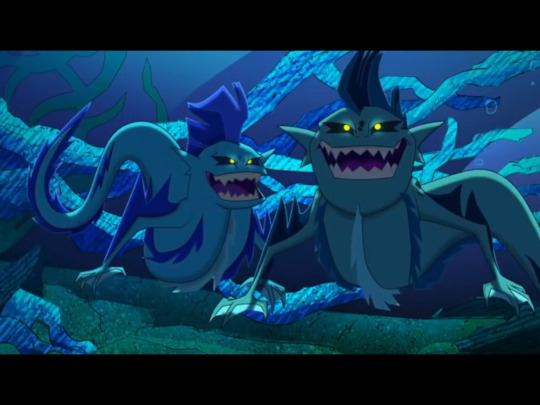
If high voltage returned to liv then odds are that momokase is somewhere in her building as well. But why are they going back to liv?, well, back in season 1 episode 18 knox didnt go directly to liv, he followed his schedule until he found his way back to her, only to attack her, and sadly now that we know liv is the second seasons main antagonist liv learned from her mistakes with knox and most likely implanted the idea in future mutated people to return to her without fighting back. But what does this all mean?, why is she collecting mutated villains, what was the point of mutating orso knox? and what does this have to do with her secret project?
well, what if Liv is trying to make mutants but is having a hard time figuring out a base pair that will allow the persons DNA to remain stable and thus creating a stable mutated human. But to do that she needs test subjects, and she knows that she cant just experiment on ordinary people without drawing suspicion, so instead shes using criminals that the public would prefer not seeing. The only exception was orso knox who may have realized what liv amaras secret project was and refused to give her the money to support it. Liv turning him into a monster was just one way of keeping her money and gaining a lab rat, however, now that he is back to normal all she has to do is threaten him with turning him back, if he doesn't keep quiet about what she is doing.
she may have always known how to turn mutants like orso back into regular humans but thats not what she wants, she wants these mutated and now animalistic humans to stay unstable so she can figure out the missing link in their DNA. In episode 3 when karmi sees orso and quickly figures out the right treatment to turn him back, liv comes in and looks at karmis work,
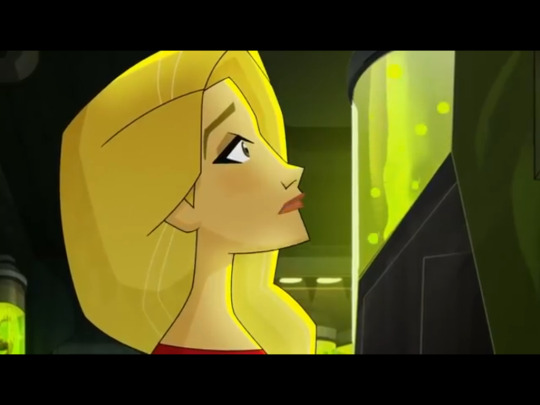
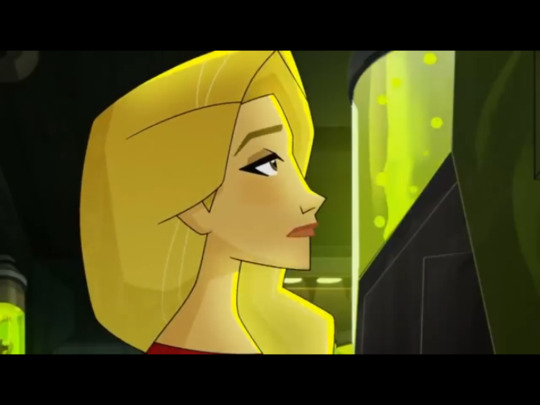
liv doesn't look happy or surprised, shes upset because now there is someone other than her that can successfully turn mutants like oros back to normal, liv knew karmi was smart, but now that she knows karmi is to smart, she identifies her as a threat. And what does she do once she realizes that karmi is capable of undoing her work? she pushes some buttons,
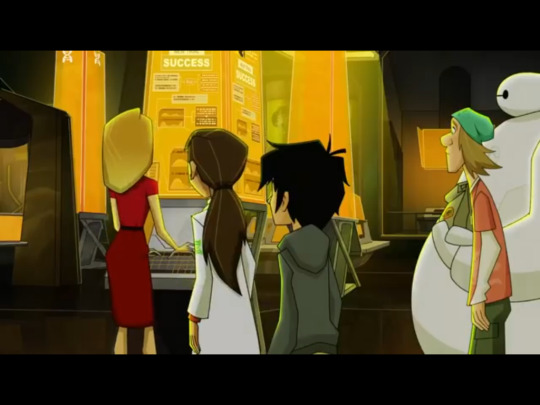
takes fred to the elevator and leaves karmi, hiro, and baymax seconds before orsos lock is disabled and the entire building is placed on lock down.
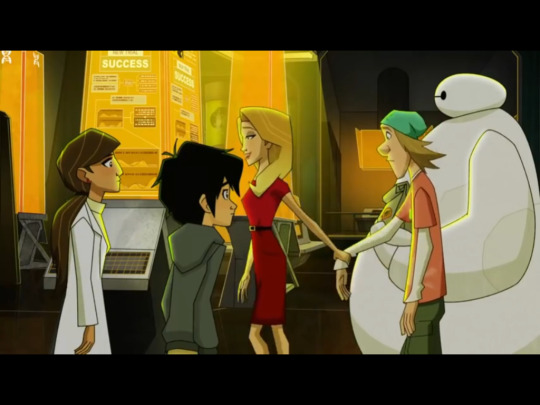
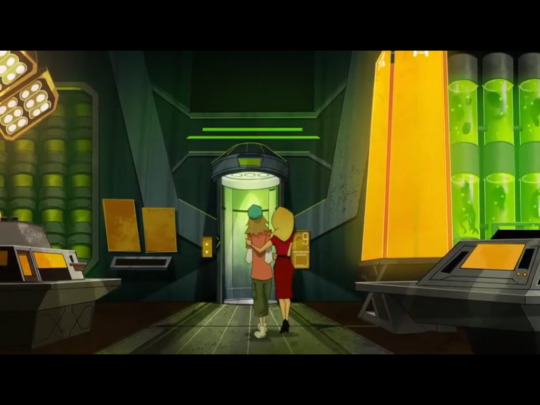
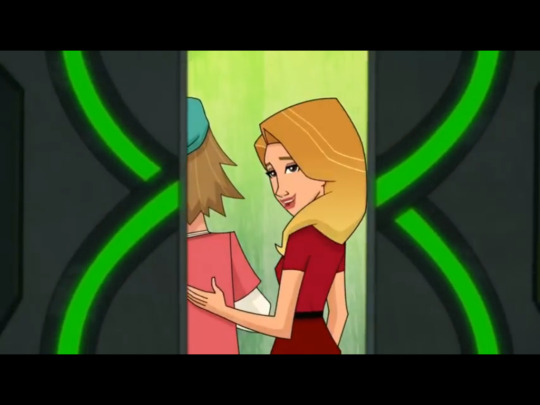
Liv was trying to murder hiro and karmi, then later pin the blame on orso to cover up her tracks!! and the only reason she took fred to safety is because she still needs to get her funds from his mother, and she cant do that if his mom is grieving for her dead son.
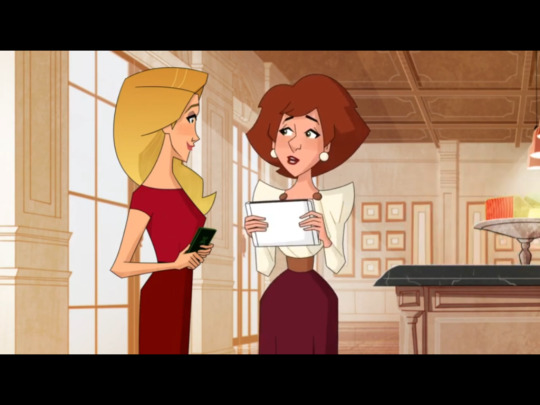
and now lets talk about the biggest question of the show, what is liv amaras end game? in episode 5, we see her experimenting with the cell regeneration capabilities of globby and claims that the way globbys cell regenerate may be a breakthrough to what she is working on. When nega globby begins to regenerate into a bigger size in front of liv we see that they are confined to a small room, this room/lab contains a series of pods and one more pod that chris looks over to on his right off screen.
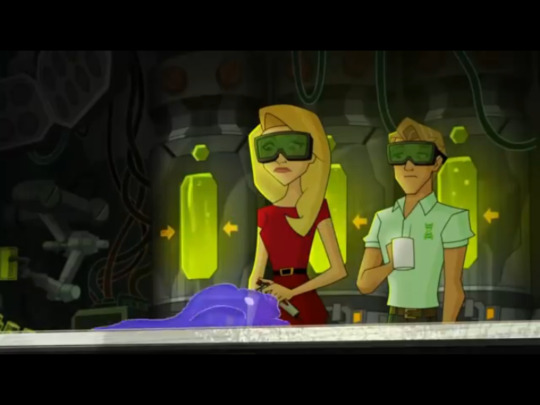
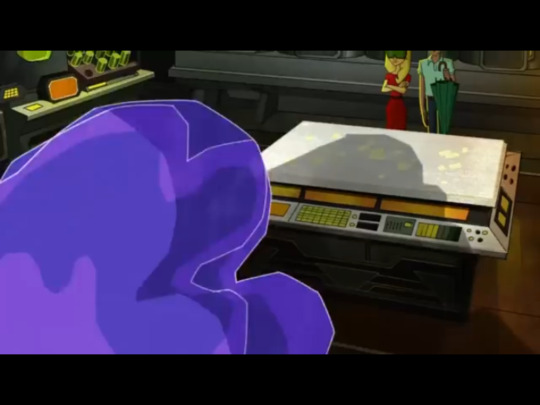
In episode 3 as hiro, karmi, and fred discover that orso is confined in sub level 9 fred says, “thats the most mysterious sub level there is, unless there’s a sub level 10, is there a sub level 10?”.
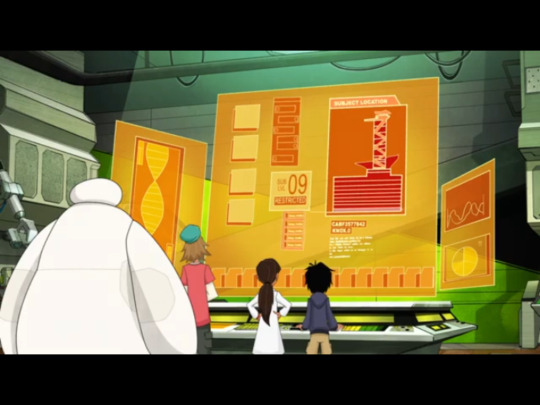
Odds are, freddy is right!, there may be a secret level that liv did not include into the buildings computer and that secret sub level is where she is currently conducting her “secret project”
later, when the nega globby escapes, Chris meets up with liv in that same suspicious room were liv is working on a single giant pod in front of her
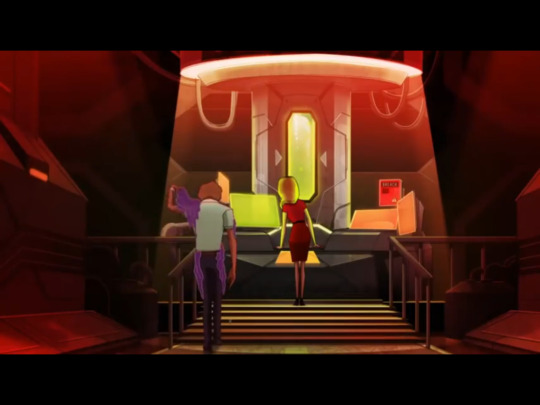
when chris states that the glob escaped liv deactivates the security shutdown (which she says in episode 3 that she has no control over, but clearly she does !!!)
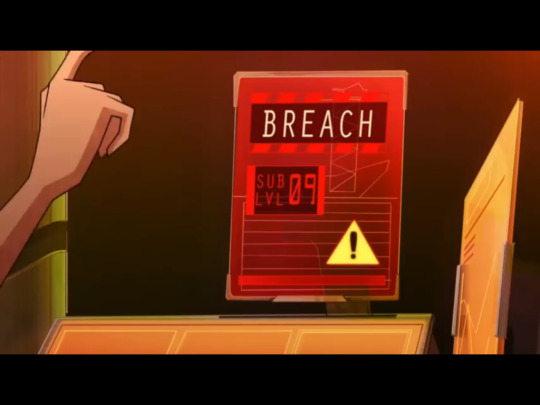

and lets it escape into the city. Chris then says, “dont we need it for..” then points to the giant pod next to him.
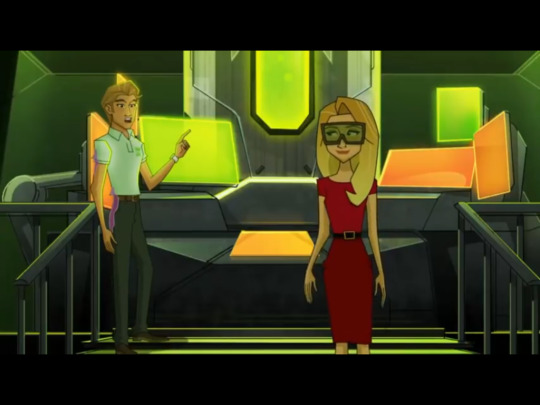
What if livs top secret project and ultimate end game has to do with whatever is in that giant pod. And what exactly is in that giant pod?, I have no idea!!, it could be anything at this point, and without enough evidence I am just gonna list out some ideas below and do a follow up later on when new info is revealed in future episodes:
1. in episode 1 liv says to grandville, hiro and the gang on their tour, “mother nature is an artist and I see myself as her protege, studying and... even improving on her work”. Liv believes it is her responsibility to do what nature is no longer capable of, improving human kind and is making a giant serum to transform the entire city into mutants, and later transform the entire world, making her the new mother of an entirely new world.
2. she is trying to create a new human race and what is in that giant tub in episode 5 is the first superhuman, however, because she hasnt figured out the right DNA sequence it is still incomplete and unstable.
3.she knew(possibly admired) or knows obake and found his body underwater after his base fell apart and currently holds him in that tub as she is trying to turn him into the first line of super mutants and thus saving his life but also using him to her advantage.
4. shes gonna turn the entire city into mindless animalistic mutants, have them all under her control, then later use her new army of mutants to take over the world, starting with san fransokyo.
5. again this is just a theory, so don’t bother complaining, I’m just making this up as i go until i get new info. Liv found Tadashi after the fire and is currently holding him in that giant tub as she is trying to figure out how to stabilize his mutated genes and fix his damaged body so he can use whatever abilities his body is developing. Then she will later use his DNA to create a new line of mutants to serve under her.
its just a theory, a big hero 6 theory!
#bh6#big hero 6#big hero 6 the series#BH6 the series#bh6 theories#big hero 6 theory#big hero 6 theories#Hiro Hamada#bh6 karmi#liv amara#Professor grandville#bh6 wasabi#fred frederickson iv#bh6 fred#gogo tomago#honey lemon#sycorax#globby#bh6 season 2#big hero 6 season 2#tadashi hamada#bh7#big hero 7#disney
192 notes
·
View notes
Text
OUAT 4X07 - The Snow Queen
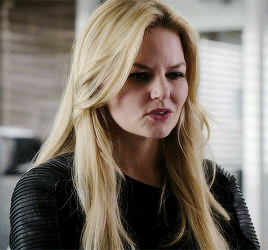
Looks like Emma’s facing a real cr-ICE-is in today’s episode!!! XD
As always, the review’s under the cut, so drop on by if you dare! BWHAHAHAH!!
Main Takeaways
Past
A big point in the segment is how Ingrid needs to give up the ribbons in order to get the gloves and urn. Rumple says that with enough emotional attachment, ordinary objects get magical values. When Gerda and Helga protest the exchange, Ingrid points out that the ribbons are a symbol of their love and that their actual love is stronger. The episode frames this as a poor decision, but that’s not a sentiment I agree with. While yes, the ribbons do indeed have a magical value, Ingrid’s right: Their real love is stronger. This is such a big element of other themes in other episodes (Basically EVERYTHING with Rumple dagger and the flashback in “White Out” come to mind), where symbols matter less than the power within and to see the raming reverse itself without any substantive self awareness is a weird choice. Ingrid’s fear of her powers and resolve to be a shut is indeed a problem, but the handling of this red herring solution stands out as an awkward choice. And then it reverses itself again with “we are your fail safe.” The idea of the value of objects over family goes back and forth like a tennis ball during a game of fetch.
And I can’t help but be on Ingrid’s side here. She’s not giving up her sisters. She’s giving up three ribbons so that she can have control over her magic and be able to go out in public with them, rule the kingdom, and just live her life. Their love is still there, but something that’s going to give Ingrid a tangible feeling of safety will be present too. And I feel like Gerda and Helga’s protests are nothing but platitudes.
Let’s also talk about the ending. Gerda, who shows so much love for her sister throughout the segment, grows terrified of her as Ingrid, the only other voice, testifies to her innocence to Helga’s death just before putting her in the urn. Like, had the Duke said something to Gerda either before the scene or during it, the fear would’ve worked better, but as it stands, it’s a weird shift for Gerda that works okay enough, but could’ve been better.
Present
There’s a lot to unpack here about Emma’s conflict. I can’t say that it’s improperly built up. This season and even the last finale have delicately pushed the idea of Emma’s magic still falling short in the face of a lack of a furthering of her education as well as her emotional issues. It’s usually a matter of her underperforming. This though is the first time we’ve ever seen it do the reverse. And I think it’s an interesting thing to explore. Not only is Emma new to magic, but she’s the only person in her family who has it. AND with the presence of a new brother and the Snow Queen manipulating her actions, things can get a little muddied from there. And while it is given a cursory look, there’s no focus to the why of the matter, choosing to try to be about all of these things while not diving into them. I feel horrible for Emma’s situation, so the tone of the episode is captured well and the framing does work perfectly, but the story itself is left kind of flabby.
I don’t do a worst dynamic on these reviews, but if I did, Snow and Emma would be it. Like, Jeez, Snow! Not even gonna hesitate pulling the baby back? Not gonna check on how your kid is feeling because I’m sure to some degree, you’re aware that magic is fueled by emotions? It’s a really shitty moment, but for me, a lot of what sucks about it is that while we’ve received hints about Snow’s apprehension towards Emma learning magic and the fandom has some pretty interesting theories about why Snow is so, we never hear it from the horse’s mouth. For that reason, Snow comes across as really cruel towards Emma for no reason.
On a lighter note in that regard, I used to really hate the outdoors scene with the light pole, finding Snow’s scolding of a terrified Emma to be disgusting, but upon watching it again, given the fact that Snow immediately changes her tone with Emma after scolding her shows very believable remorse. She knows this wasn’t Emma’s fault and that she needs support and love and she knows she failed to give her that. Granted, I’m not a fan of her telling David that the both of them fucked up when David didn’t react negatively to what happened and he even got into the situation to save Emma’s boyfriend (And also played a big role in trying to find her afterwards despite being injured when it really should’ve been the other way around). Like, Snow, that all was totally on you. But as for the initial outburst, I do find that it was handled better in hindsight.
That having been said, while I really dislike Snow’s reaction, I do like the pole scene by itself. It’s never wracking, has some great fast-paced editing, and is sympathetic to most everyone there. It’s as panicked as Emma feels and while I don’t like some of the buildup to that moment, I do like the moment itself and it feels earned enough. There’s a great element of tragedy to the scene too. Emma has tried so hard to overcome her walls and be a part of her family, but because her magic is out of control, she fears that she might not be able to.
As I watch this episode, I’m reminded of why I don’t really care for Robin. I swear I’m not trying to be anti-OQ or anything here, but it does infuriate me that Robin doesn’t even seem to TRY to fall back in love with Marian before getting turned down by Regina the second time. Feelings are valid and I understand that, but the fact of the matter is a person who Robin supposedly cares very much for (Even if the romantic feelings are lessened or gone, Robin would assumedly care about her as a former wife, a person, and the mother of his child) has a frozen heart and is in what is basically a coma and while the only foolproof solution to this lies with him, he’s putting in no effort to even TRY to save her by this point.
And I know what you’re thinking: He does try. At Granny’s, he and Will go over Robin and Marian’s story. And this did have me consider my stance. But the problem is that that’s all he does before just giving up and this isn’t framed as the complicated choice that it is. By all means, Robin, be happy that you love Regina, I’m not telling you not to. But acknowledge the fact that to be with Regina, you’re denying Marian what might be their best chance at saving her. (And the fact that Marian is Zelena of course isn’t a factor here as no one knew that at the time)
Because of all of this, I don’t feel all that sympathetic for his plight and I don’t find my belief that strong for the “code” he was so strongly speaking for in “A Tale of Two Sisters.” I’m with Regina -- that’s completely unfair to her as well as to Marian!
I also find myself a touch frustrated with Ingrid because a lot of the things that she comments on and acts like were her ideas are just random coincidences. I pointed this out, but the results of Emma and Elsa’s investigation haven’t been predetermined, but have resulted from spur-of-the-moment decisions that are usually made by third parties. Ingrid had no idea Emma even still had that video camera, let alone that she would play it and discover her and then investigate the ice cream truck. She had no idea that Belle would clue her into the mirror’s existence or even get that candle. And she had no idea that Emma was dealing with fear from Snow. And at some point OFF SCREEN, Emma apparently tells Ingrid about what happened at the Mommy and Me class or Ingrid brings up that she knows it. That especially irks me here. We see at the end that Ingrid did have a role to play in Emma’s bursts of magic, but because we don’t really see what it was that she did, it’s not effective.
“Sometimes even when you win, you lose.” I’m still annoyed that this is the most we ever got out Will as far as an explanation for his presence. Did Ana die? Did he get caught up in something Lily was doing, since A&E said that his story was related to Mal and Lily’s? At least now that the realms are merged, they can get back together, although their 15-ish years of separation sucks royally. :(
Stream of Consciousness
-Dude! That asshole just fucking KICKED Ingrid! Dude deserves to be BEHEADED!
-I wish the pacing was a smidge slower on this opening. Like, in just a flash, Ingrid discovers her powers, gets called a monster, panics, gets a fast speech, and then wham, things are mostly okay. Like, an additional second so that everyone could process even Ingrid’s powers or the fallen branch really would’ve helped for my money.
-It’s kind of weird how Elsa’s speech to Emma about how her family might look differently at her for her powers, however unintentional, is kind of the tipping point of this arc.
-Ingrid, I don’t want to tell you how to do your evil job, but if Emma hadn’t avoided that icicle, she’d be dead! You already have two dead sisters! A third won’t do you much good!
-Really! All three of them share a room? Granted, it’s a big room, but they’re royals! Not to mention, those beds are fulls at most! You telling me three royals, one of whom is the future queen, wouldn’t have bigger beds?
-Just saying, if I was Elsa, I would’ve followed in my little sister’s footsteps and decked her right in the schnoz.
-”...With your scary face on.” I love how Regina and Henry have that casualness to who they are! It shows how they’re grown!
-Ooh! I see some foreshadowing with Belle saving Killian from the secondary threat (The Shattered Sight Mirror)! Captain Book!
-I love that little flattered gesture Rumple makes when Ingrid calls him the most powerful magic collector in all the land. XD
-The Duke of Weasletown is a fucking creep and Helga is best character for putting him in his place!
-Ummm, I WANT A STORYBROOKE SNOW GLOBE, PLEASE!
-Loving that Rumple smile. Methinks something amazing is coming! XD Or rather, meknows something great is coming! *Rumple giggle*
Favorite Dynamic
Ingrid and Rumple. I love seeing villains interact and in this episode, Ingrid and Rumple do it really well. They act as overseeing deities playing with the chess pieces that they’ve made our heroes into through their manipulations and seeing them talk about circumstances so matter-of-factly is really interesting. I also love how they deal with each other. Watching their deal go through at the end of the episode is like watching a really interesting drug deal go down. Every action from Rumple securing the ribbons to holding onto one of them while waiting for his information to Ingrid whispering what he needs is so engaging! I always love scenes that despite the fact that I know what’s coming, I still get swept up in the action, and that is this episode in spades.
Writer
Adam and Eddy are today’s writers. I feel like this episode really needed more focus in its three main storylines. We’re given hints of character actions and through processes, but none of them ever go all the way. And I genuinely hope that I don’t sound like I’m incapable of putting these pieces together -- I promise you that I do get how these narrative points connect, but my issue is that they’re sometimes not tightly knit enough to support the big character moments and story points that they’re supposed to be able to support.
Rating
7/10. I’ve felt bad with some of these more recent reviews. Sometimes, it’s hard to communicate that despite the problems that I’m pointing out, I am enjoying myself. Like with “Family Business,” this isn’t a bad episode, but it just needs a bit more solidification. There’s a lot of cool ideas to work with here -- an examination of how Emma’s family views Emma’s magic, Robin trying and failing to recapture his love for Marian while in love with Regina, and Emma’s thoughts about her sibling come to mind. But while they dip their toes in that pool, little else is done.
-----
Thank you all for reading! I think I did a better job here than I did with my “Family Business” review, but let me know if there’s something you want more elaboration on!
Shout out to @watchingfairytales and @daensarah!!!! See you guys next time!
Season 3 Total (49/230)
Writer Scores: Adam and Eddy: (16/60) Jane Espenson: (10/40) David Goodman and Jerome Schwartz: (10/50) Andrew Chambliss: (14/50) Dana Horgan: (6/30) Kalinda Vazquez: (14/40) Scott Nimerfro: (6/30)
Tags: ouat, once upon a time, watching fairytales, ouat episode code, ouat rewatch, jenna watches ouat, ships mentioned, triggers mentioned
*Links to the rest of my rewatch will no longer be provided. They take posts with links outside of searches and I spend way too much time on these reviews to not give them that kind of exposure. Sorry for the inconvenience, but they still can be found on my page under Operation Rewatch.
23 notes
·
View notes
Text
What is the end game for Rey and Kylo Ren, and how does it connect to the ultimate fate of the Force in the sequel trilogy?
With ‘The Last Jedi’ only a month away (a month guys!), I thought I would dive into something which might be viewed as a little too far-fetched to be discussing right now, but I think it’s crucial to put this out there before we have all seen ‘The Last Jedi’. Mainly because this could very easily be torn to pieces by the end of episode VIII (which I will embrace wholeheartedly either way, as I am sure that a compelling story awaits us all). So if you think this is all just moot to be talking about at this stage, or you’d rather not think about what will be the conclusion to the sequel trilogy concerning Kylo and Rey, then by all means skip this post. For those still here, I hope you read on and let me know what you think. Oh, and be warned, this is going to be a long post.

What will happen ultimately to Rey and Kylo Ren? At this point, given what has happened these past few months, I think ‘Reylo’, in the broadest of terms, is going to happen. Heck, it’s already started in TFA.
For me the more important question now is not if ‘Reylo’ is going to happen but rather, what is to become of their futures? Will they be together or won’t they? Right now we don’t know, and I don’t presume to know either, but I would like to talk about what could happen on a hypothetical level, given what we know about what type of story this is, and the narrative line, both on a symbolic and spiritual level.
Because to answer the question of how this trilogy will end, we have to ask what it is indeed about. And in order to answer that question, we have to ask what the sequel trilogy has to do in order to further the story of ‘Star Wars’.
The sequel trilogy is, in the end, about the Force.
But you see, I think the Force is going to have a much bigger role to play now, because the lore surrounding Star Wars needs to be expanded upon. We know this is coming because Luke has been trying to find out more about this mysterious Force which the entire saga revolves around, and I think we will get a lot more backstory on it in TLJ, judging by Luke’s books and the Force Tree we saw in the trailer. Heck, he’s on Achto, the original temple of the Jedi; if that doesn’t scream history and hoards of information just waiting to be found, I don’t know what does.
There’s a reason why episode VII was called ‘The Force Awakens’.
But how exactly will they expand upon the Force and how does this connect to the fates of Kylo Ren and Rey?
“Without the Jedi, there can be no balance in the Force.”
A simple, single line, which appears in the first scene of TFA. An old saying, which finds it’s roots in the original trilogy.
‘The mission’ if you like, for this sequel trilogy, will be to deconstruct this notion, and by the end of episode IX we should be able to see that what Lor San Tekka states here is, in fact, incorrect.

‘Dust’ and ‘the Force’
The similarities between ‘His Dark Materials’ and the notions of ‘the Force’ are not surprising. Both are inspired by religious sources; for Pullman it was Paradise Lost, for George Lucas it was more general, taking inspiration from all forms of religion, but this greatly informs their ideas of their respective sources of power in their worlds. ‘Dust/the Force’, the idea of power, for both these creatives, resides primarily in the idea of faith and more importantly, ‘the consciousness‘. Why is this so?
The fantasy genre for me exists, first and foremost, because we want to tackle the morally problematic issue that is ‘power’. Magic, lightsabers, rings, wands, time travel, super powers, you name it, these are all simply vehicles used to represent the idea of power. However, what makes both George Lucas and Phillip Pullman so interesting, is that their philosophy surrounding power goes beyond that of the classic, cautionary tale about the misuse of power (Harry Potter - ‘horcruxes & Voldemort’, Lord of the Rings - ‘the One Ring’) or how one becomes ‘worthy’ of power.
The biggest similarity between ‘Dust’ and ‘the Force’ is their nebulousness and anonymity within their respective stories. The characters in both worlds have very different ideas about ‘Dust/the Force’, both on it’s purpose and what should be done about it. They are forms of power which ultimately do not belong to either the ‘good’ or ‘evil’. If I was to describe how ideas of ‘the Force’ are to change, I would say that Philip Pullman’s description of ‘Dust’ gives a pretty good idea of where I think this sequel trilogy is heading.

“Dust is a mysterious force of which the powerful people in the story seem to be afraid.”
This quote was taken directly from an interview with Philip Pullman, but what is so fascinating is that he might as well be talking about ‘the Force’ as we know it in Star Wars. In fact, this could be seen as the premise for the entire saga.
Here is the link to said video. From 1:26
https://www.youtube.com/watch?v=5N6vzZuPy1s
In the prequels, Palpatine’s main goal was to take over the Galactic Senate and ultimately rule over the galaxy. However, he did so in a very politically strategic way; by instilling fear in the public and, by extension, fear of the Jedi. He distanced the public from ‘the force’ and shrouded it in mystery, instilling ignorance in those he ruled over. He went so far as to hide his own identity as a force user in order to do this. By taking this power away from the people, he was able to easily manipulate those around him. This is why he was able to take over and create his Empire as smoothly as he did, “with thunderous applause”. His true power was his perceptiveness; he could see into people’s weaknesses and understood how ‘power’ could be both utilized and suppressed.
Palpatine was intelligent in the sense that he knew ‘the Force’ was a powerful thing, however, as Pullman says in his quote, he ultimately feared it. We know this because, quite simply, he tried to control it; first by extinguishing the Jedi, and second, by manipulating Anakin Skywalker, the greatest force user at that time, into becoming his puppet.
In His Dark Materials, ‘the Magistrate’ exerts its power through similar means; their basic goal is to remain in power by making sure the public never learn of ‘dust’ and its various capabilities. They are responsible for the public’s general ignorance over what ‘Dust’ actually is, they only know it as something corrupt and to be feared. The Magistrate successfully created in this way a distorted image of ‘Dust’, labeling it as something ‘evil’ and ‘corrupt’ (if you like ‘original sin’). This is exactly what Palpatine did to the Jedi; you might as well exchange the ‘Magisterium’ for the ‘Empire’ and you probably wouldn’t see much difference.
On the other side, the Jedi during the prequels had grown ignorant over the true purpose of ‘the force’ and what ‘balance in the force’ really meant. This is why they ultimately failed Anakin Skywalker during his training to become a Jedi. George Lucas highlights the flaws within the council and we are therefore able to understand why the Republic fell. The Jedi only used one side of the Force, and believed the ‘Dark Side’ to be completely corrupt and therefore not to be embraced. They speak of ‘fear being the path to the dark side’ but ironically, it is that very avoidance of it, that ends up instilling fear of the ‘Dark side’ in force users and therefore sends either themselves or those around them down that path, becoming the very thing they swore to destroy. Philip Pullman also shows this in his trilogy but more on that later.
“Dust is a mysterious force of which the powerful people in the story seem to be afraid.”
Once again, we return to his statement. At first it may not seem this way, but the Jedi too, in their own way, feared ‘the Force’ and it’s capabilities. Like ‘the Magistrate’, they created an order, a set of rules, a moral code, in order to restrain force users and stop them from being ‘corrupted’. Someone like Anakin Skywalker, who found extreme conflict regarding this concept, was exactly the sort of person who the Jedi feared most of all.
Like ‘the Magistrate’, they grew increasingly frustrated because of their growing lack of connection to ‘the Force’. This is shown most prominently when Yoda states “impossible to see, the future is.” And yet, Anakin sees, with painful clarity, the future and the fate of the one he loves, because unlike Yoda, he does not fully reject ‘the dark side’ and therefore it does not cloud his vision. His connection to ‘the Force’ is very much like Lyra’s ability to read the alethiometer; she sees nothing but the truth, something no one else seems to be able to do. Rey in the sequel trilogy also holds this ability; her version of this comes in the form of ‘visions’.
The Jedi do not fully trust ‘the chosen one’, which means that they do not in fact trust ‘the Force’. Like ‘the Force’, Anakin Skywalker was someone who could not be controlled and yet, this is precisely why he was ‘the chosen one’. TLJ continues these ideas, with Luke fearing not only ‘Kylo Ren’ but ‘Rey’ as well, and I would guess this is because he does not understand ‘what’ either of them truly are, whether they are ‘good’ or ‘bad’, symbols of ‘the Force’ or, if you like for the purposes of this post, ‘Dust’.
It is important to note that one speaks of ‘the Force’ or ‘Dust’, we are talking about it as a whole. The Jedi may have embraced the Force as they knew it, but they didn’t in fact do so fully. Like the Emperor, they feared what might happen if ‘the Force’ was free and unrestricted. This is why we have seen through the saga the fall of both the ‘light’ and ‘dark’ side.
In ‘His Dark Materials’, ‘intercision’ is for me the equivalent of what happens to every Force user in the saga, may they be on the ‘light’ side or ‘dark’ side.
In Philip Pullman’s books, this is of course much more extreme; essentially ‘intercision’ is a form of lobotomy. In literature, lobotomy is often used as a symbol for the loss of freedom and individual thought – just look at Tennessee Williams’ ‘Suddenly Last Summer’ as the most blatant example of this. ‘Intercision’ is essentially the Magistrate’s way of preventing children from embracing ‘Dust’ as they turn of age, stopping from maturing. Instead they transform into vegetative states, with no free will of their own. The separation of the soul and body can also be linked to the concept of dementors in the Harry Potter series.
Snoke’s manipulation of Kylo is reminiscent of this. He is trying to stomp out the very humanity out of Ben Solo – hence Lor San Tekka’s line “something far worse as happened to you”, alluding to Kylo’s almost Frankenstein-like appearance which harkens back to Darth Vader and his journey. For Kylo however, his ‘intercision’ is not yet complete.
Looking at it from a certain point of view, both the Sith and Jedi prevented their students from developing the complete use of the Force, by allowing them to only use one half of it and, one can argue, only one half of themselves. Although each respective faction states they do this because the other side is ‘corrupt’, it is clear something is incorrect about their analysis, because the Force is in constant flux throughout the saga, unable to settle, perhaps because of it’s misuse by both sides. In ‘His Dark Materials’, this is exactly what is happening with ‘Dust’. At the end of ‘The Northern Lights’ Lord Asriel is able to travel from one world to another, but only by killing Lyra’s best friend Rodger in the process. This causes Lyra to reevaluate both her image of her father, but also of Dust. Unlike Lucas, Pullman shows us from the very first book, that ‘Dust’ is not only being misunderstood by the ‘Magisterium’ but also by those we see as the ‘good guys’.
If the latest trailer for ‘The Last Jedi’ is any indication, Luke may have caught on a little, as it seems he has discovered the Jedi were ultimately wrong about their teachings and beliefs concerning ‘the Force’. Hence his line, “it is time for the Jedi to end.” In Pullman’s books, the adults have a clear misunderstanding when it comes to ‘Dust’, largely because they know so little about it, and more importantly, because they are unable to control it. This is essentially what I think Luke has discovered or will discover in ‘The Last Jedi’.
“Lyra, who has been told all her life that dust is bad, has seen the adults around her doing terrible things in the name of getting rid of Dust as they think. She undergoes a moral crisis, and thinks ‘if these people have been doing these wicked things and they say that Dust is bad, then maybe Dust is good’.
This is exactly what I think will happen to Rey in ‘The Last Jedi’.
It leads her to connect with Kylo Ren because she witnesses what she sees as the misuse of ‘the Force’. In the original trilogy, the Death Star is the ultimate symbol of misuse of power. George Lucas even rubs this in by making the source of it’s power kyber crystals, which are in themselves symbols of the Force itself. This is heavily implied in Rogue One. This is just speculation at this point, but I believe the Resistance have been mining for some form of kyber crystals on Crait, and were perhaps building a sort of Death Star of their own. I’m not sure though if Lucasfilm is gutsy enough for that, but it would make a heck of a storyline.
With Rey, she sees that the light side of the Force is not entirely what she expected, and finding herself even more lost, wonders that perhaps ‘the dark side’ is not as corrupt as she is being led to think.
Yes, these are two completely different materials, but essentially, they are tackling the same themes. In Rey’s mind at present, there is ‘the Force’, but she is not yet aware that previous force users saw different ways it could be misused. Like Anakin before her, she will discover that her use of ‘the Force’ would have been seen as ‘corrupt’ by the Jedi, firstly because, on a practical level, she has not been trained and has little control over it, and secondly, because she utilizes both the Dark and Light sides of the Force. The several examples of this during TFA (see links below for examples).
http://sakurau121.tumblr.com/post/147314934255/im-calling-it-rey-is-going-to-turn-to-the-dark
http://sakurau121.tumblr.com/post/152902112780/so-heres-yet-another-theory-of-mine-about-how
http://sakurau121.tumblr.com/post/154378487925/reys-introduction-to-the-force-in-tfa-and-the
My opinion remains open, but these just give you observations on Rey’s use of the force.
I think one of the reasons why she will struggle with Luke, is because she will find his teachings restrictive. Luke’s ‘fear’ of Rey is completely justified, because, as we have established, the ‘adults’ in the fantasy genre often fear the young because they represent what is to come – the future of power. They fear this ‘force’ because they do not understand it. This is why, as Pullman shows, power is not just abused by the ‘bad guys’ but by the majority of the characters in his stories because they seek to exert control over ‘power’ itself (in his case ‘Dust’). This is what ‘His Dark Materials’ has most in common with the philosophy of Star Wars because all the force users in Star Wars also seek to control ‘the Force’, one way or another (which turns out to be their biggest mistake).
“Everything that is consciousness – human thought, imagination, love, affection, kindness, good things, curiosity, intellectual curiosity.”
This is Pullman’s description of ‘Dust’ and interestingly, there are many elements there which refer to both the ‘light’ and ‘dark’ sides of the Force. ‘Curiosity’, for example, is something which Yoda in fact tries to suppress in Luke – “there is no why”. Luke’s natural curiosity in the world around him, the possibilities that he sees, is in fact his greatest quality and the reason why he was able to save his father and help him fulfill the prophecy of ‘The Chosen One’. So, what does that say about Yoda and what would have happened if Luke had suppressed his true self?
For Rey and Kylo Ren, they will discover, as Lyra did, that power is being misused by pretty much everybody (hence all the characters in the promotion in TLJ being soaked in red). This is unsurprising, as far as ‘His Dark Materials’ go, because most of the characters in Pullman’s books are not necessarily ‘good’ or ‘bad’. Mrs Coulter and Lord Asriel are very good examples of this. Lyra herself is wild and has an almost untameable sort of quality about her, similar, I think, to both Kylo and Rey.
The power struggle between the old and new ways of thinking is not necessarily something new. In the original trilogy, Luke defies his masters because he does not agree with them. Once again, I think this will be repeated in the sequel trilogy. After all, fairy-tales in the end are about parents and children, and how children ultimately must move on and evolve, separating from their parents. The future must prevail, and progress cannot be stopped. Change inevitably happens, and therefore, the freedom of independent thought is essential. In Pullman’s trilogy, he shows this in the most powerful way possible, and this is where we delve into what I think will be Rey and Kylo’s ultimate fate.
Their fate will depend greatly on what happens to ‘the Force’ at the end of this trilogy which is why I’ve been barking on and on about its evolution and meaning in this post. So far, the Force has remained unstable, despite the fact that Anakin Skywalker restored ‘balance’ when he destroyed the Emperor. This is actually a very important thing to remember because it indicates that perhaps ‘balance’ is not necessarily the answer.
The Force as we know it must change and take on a different form. The sequel trilogy in many ways is about wiping the slate clean. I believe this trilogy will bring an end to ‘force users’ as we currently recognize them. Like ‘Dust’, one could argue that if ‘the Force’ had been left alone to thrive naturally and was not manipulated by man, then perhaps none of the events of the saga would have happened at all.
This idea of ‘the Force’ being free, the end of both the Jedi and the Sith, can only be demonstrated effectively enough through our two ‘protagonists’. This has been done before of course, and yes, ‘His Dark Materials’ is one example. This is only a suggestion but I think it’s entirely possible that Rey and Kylo will, in essence, let ‘the Force’ be free and no longer let others control it. It returns to how it was before force users were about. And so, ‘the Force’ as we know it, disappears and yet remains. Like Lyra and Will, Rey and Kylo lose their powers, and therefore, so does Snoke. This is how they ultimately defeat him. Like Noah, they must start anew, letting go of the old world in order to create a new one. However, in order to truly demonstrate the relinquishing of power, they must do one other thing.
At the end of ‘His Dark Materials’, Lyra and Will are forced to part ways – they cannot stay together. By relinquishing power, they also realize that because ‘said power’ can no longer be controlled, they cannot control their fate either. It is often the case that characters must sacrifice so that they can restore peace and balance, returning ‘power’ back into the world, so that people can embrace it in it’s purest form.
If you want an example of this, look no further than that of Chirrut in ‘Rogue One’. He presents an alternative way of embracing ‘the Force’. Pullman has said that ‘Dust’ needs people as much as people need ‘Dust’. One cannot exist without the other. Which is why that famous line in ‘Rogue One’ makes so much sense…
“And the Force is with me”.
This idea of returning ‘power’ back to the ‘world’ is a very universal idea and can be seen in many different forms. The film ‘Princess Mononoke’ ends with Ashitaka and San returning to their respective worlds after releasing the power back to nature. The forest is no longer as it once was and each must respectively follow their own path but remain connected to one another, even when they are apart. Lyra and Will clearly embody this; they are from two separate parallel worlds but both sit on the same bench each year, aware that the other is close by but still so far away. ‘Spirited Away’ ends with Chihiro returning to the human world; Haku says that he is ‘free’ but they still must part because they have come to the end of their journey together. That film is very much about these ‘two protagonists’ regaining their sense of identity. Sound familiar?
But why must Kylo and Rey part? You may ask.
Aren’t they supposed to meet in the middle and connect to create a new group of force users?
Perhaps. But it would go against everything that I have just said up until now. We cannot forget that while they will connect to each other, they represent opposites sides of a coin, like Ashitaka and San (’man’ and ‘nature’), Haku and Chihiro (‘spirit’ and ‘consciousness’). Ying and Yang, and while both connect to both sides of the Force, they will, in the end, embrace one side a little more than the other. They are two separate beings, and by finding their true ‘identities’ at the conclusion of this trilogy, they remember the past and realize they must do better than those who have come before them.
I do not believe Kylo and Rey will begin creating a new group of force users because they will finally understand the true nature of the Force. It is not something which can be taught; it must be felt and developed naturally, like ‘consciousness’ itself, allowed to expand and mature overtime. We don’t grow up when we begin to listen and do what we are told to do; we grow up when we start to make conscious decisions for ourselves and understand the consequences that come with that. Only then do we begin to know ourselves and therefore become in touch with who we inherently are. This is something which no one can teach you; ultimately you discover this for yourself and in fact, that is the ‘true’ source of power, the true power of ‘the Force’.
Self-discovery, which is what the fantasy genre is all about.
Here’s another reason behind why I think Rey and Kylo will part at the end of Episode IX.
‘Casablanca’.
True, this is not a fantasy film, but it is a story about taking initiative and trying to make the world a better place (famously it was released during WW2 when America was already involved, and this film hailed the idea of ‘responsibility’ and ‘commitment’ during a time when the world was literally falling apart).
It is a story about ‘redemption’ and I believe that is what the sequel trilogy will be about. The return of ‘the Force’ in its purest form through the redemption of those who use it, and that applies to everyone, not just Kylo Ren.
There are, however, clear parallels between the character of ‘Rick’ and ‘Kylo Ren’, which is not surprising as Humphrey Bogart embodied many traits which harken back to the idea of the Byronic hero, or ‘anti-hero’. As Palminteri said about Bogart, “he was able to wear a white hat and a black hat. He was the killer you sort of sympathised with.” Han Solo IS Rick in Casablanca you could argue, at first passive towards the political climate, hypocritical in the sense that he says he doesn’t care, when really he does.
Naturally, his son embodies this attitude as well and by the end of Casablanca, Rick has transformed his world view after reuniting with the love of his life, who is aptly part of the ‘French Resistance’. Is it only when he pushes her away, that he becomes truly selfless and he finally recovers his true sense of agenda and identity.
This is the key when it comes to Kylo Ren. The only way I believe to truly complete his transformation is for him to do the noble thing and protect the one he loves in the most selfless way possible. This is important because it becomes an integral part of his story arc. This does not however mean that he will die. That would be easy, but the harder thing to do, would be to live with the decisions he has made. This is one of the primary reasons why JK Rowling did not kill Harry Potter at the end of her series. Of course, another reason is because it has been done before, and unlike Darth Vader, Kylo’s story is tightly interlocked with that of Rey, more so than Luke’s ever was with his father.
Ebert describes Bogart thus; “he can play that hurt, that vulnerability, that guy who will never be able to bounce back and at the same time, you see inside of him that idealism. He has this cynicism that says ‘I’ll stick my neck out for nobody’ but at the same time he sticks his neck way out and it was that transition that Bogart was so good at.”
I have a hunch that Adam Driver is good at this too, and this is precisely why Kennedy cast him as Kylo Ren. I don’t think it’s a mere coincidence that very specific expressionist cinematography was used during Kylo’s scenes in TFA; the use of film noirish side lighting to highlight his inner conflict and split-self, just as Rick is depicted in Casablanca.
Kylo and Rey will part ways but remain connected, coexisting. Ben’s love for Rey will echo the use of the Force by force-users, and therefore both must be relinquished in order to bring true peace to the galaxy. The bright side is it will leave the trilogy open-ended enough so that their story can continue and there is a possibility of them coming together once more, but I also think it makes for the most cohesive ending.
The Force does not need to be balanced, it needs to be set free.
‘Star-crossed lovers’, Rey and Kylo indeed literally will become I think.
But what do you think? Let me know in the comments and don’t forget to like and reblog so we can get a conversation going. Sorry for the extremely long post :D
183 notes
·
View notes
Text

1. The 9 seat table / logo
I would think less of nine instead of seven detail, if it wasn't for the fact that when you explored in League client Council Archives and got to the end of them, this was the message you received as the 'archivist':
The data you've collected will no doubt be of great use to the council. If circumstances were different, celebration would be in order! But alas, our ongoing efforts to protect Piltover must be kept secret. There are those that wish to destroy the very foundations that make our city of progress, well... progress!
Seems like a curious detail to add to a flavour marketing, or more like seems like everything in those archives was deemed as something to be too dangerous to be common knowledge to the public of Piltover.
Imo. This is how they're going to tie Arcane to proper LoL lore of all the super old, disjointed champions that were only one note - so nearly everyone of main cast in Arcane. Kind of have their cookie and eat it too sweet deal.
3. Was it before or after the bridge rebellion that Vander tried to drown Silco? And why? Wow, you may be right - humans and their pesky age, never payed attention to how they looked. lol For your questions: 1. What was Mel planning for Jayce? What was he not ready for yet, when she was talking to Elora about their friends from overseas? I thought it was obvious from context of her next scene with Jayce and Viktor, is was to make a Hextech weapons and use them as a leverage to quiet down the undercity, like a powerful deterrent weapon. She uses the term 'counter-measures' but all three of them in that scene know she is talking about weapons and she tries to make it seem as if it's too late for anything else because 'peace is already broken'. Mel is an excellent politician - she's not going to say it out right, it's very same strategy as Ambessa's with Jayce in the bath house.
And then they have mom and daughter fight in episode 9 because Mel is all angry with her mom 'Jayce wasn't ready, why did you not listen to me mom - u ruined my plan and he went used the weapons not like I wanted them to be used' and Ambessa is all 'hah, I showed you how it should be done'. Both of them told Jayce in act 3 nearly the same things - Ambessa didn't even get to the weapons part. God, these two bring me so much joy together.
And it was neither of them, it was Vi.
Piltover either pacifies the undercity in some way, or it'll continue to look vulnerable and someone from bigger countries will invade them. That's also why her mom shows up imo., her mom is scared the man that is after the Medarda family will have no problem infiltrating Piltover to kill Mel in his quest for revenge.
Have that leadership towards the future, not the past that she’s wanted for a while.
She's the leadership that looks towards the future in her mind imo. Jayce just by accident took out Heimerdinger from the council and got his position, I don't think she wanted him to do that. She said to him Heimerdinger looks towards the past, so he'd show off the next part of Hextech at the Progress Day. Thou imo. she's right in that assessment of Heimerdinger.
2. Were Mel’s plans for Jayce good or nefarious?
I assume the political part, not the romance part.
Imo. it's neither good or bad. It could be mutually beneficial or it could be not for them, depending what each of them wants and if their goals align. I don't think nefarious or good is a apt way to judge it. She has her goals, he has his - they can be comrades, they could turn to be on opposite sides of political goals.
Imo. the way she sees Jayce consciously or not is this:



This is how Mel would prefer to have power, be the power behind the throne. Doesn't help her mom in her flashback scared her shitless to be the symbol of the regime/ruler by cutting off that girls head.
Her mom would prefer if she sat on the throne herself - or took the throne herself - because it's not without risk to just give the throne/power away to someone else and hope they'll follow your guidance. Especially if one doesn't want to use force to threaten them like her mom would, just their wits, knowledge and cunning (so being a fox).
Seeing how less and less Mel can influence Jayce's decisions and do damage control towards her own goal the longer he's in the council because the plot just runs at too quick of a speed as you mentioned - too many factors - I think her mom was right. It's incredibly risky to just give power away. Like she definitely did not want Jayce to start lighting Pitover on fire even more, yet Jayce listens to the advice of other people too - like Marcus.
Imo. Jayce is one of the characters that could have a very good mutually beneficial working relationship of him being in power/face on the throne and having someone really be the power behind the throne since he's not interested in political power and making decisions stresses him out. But that is only, and only, if his goal and the person's behind the throne goal align. Anyway it wouldn't be that dissimilar to how his and Viktor's relationship works around hextech at the start of act2.
Imo. next season she will finally try to be the head of the council herself, that makes me very excited.
Ambessa never wanted Mel to swing the sword herself, she wanted her to be clever like the fox and ruthless like the wolf.
Probably, but Mel is just a fox imo. - she's not ruthless or uses force. Hasn't been shown to. If that's good for her, is another question. Wolf imo. is much more force and fear than ruthlessness here, so how Silco governs the chembarons.
Plus if Piltover is elevated to a higher status in the world. then her family couldn’t look down at her for being a leader and richest person in Piltover - even if she was the least wealthy Medarda. There’s also the added bonus of proving her mom wrong, that she was able to accomplish all of this with her own methods not her mother’s.
Yep, seems so. Only Elora is close enough to her to know but seems so. But I think she did want to become the richest Medarda, that'd show off to her mom.
Season 1 unfinished threads
So season1 left some threads unfinished, they may come back or they may not have answers. Multiple questions probably have one answer, we just don't know how they're connected.


Is there a historical revisioning or censorship present in Piltover? The city is 200 years old, the council seats seem for life and there are 9 seats around that table. I clearly see 9 seats. Do people know about it? How many generation could it be since there were 9 seats? .
Following from that, is Jayce's research being confiscated a Piltover version of dangerous knowledge 'book-burning'? May be likely. .
Was it before or after the bridge rebellion that Vander tried to drown Silco? And why? I think it's before since the opening starts from below the bridge perspective. No idea why thou, unless he was just angry. .
Why wasn't Silco on the bridge with Vander in the rebellion, why Vander was the only person to lead the people onto Piltover? re above or he just got cold feet and run away, one of them struck a deal with someone... eh complicated .
Where did Silco export shimmer to? Imo. Noxus or Ionia .
Did Benzo and Vander kept mafia like protection 'tax' on lanes? Def. seems so from their dialogue in Episode 1 in Benzo's shop. .
What is Amara exporting that she needs to revise her shipping manifestos? Is she harmless? My bet is that she's not harmless and it's chemtech. .
Does Mel think Amara is harmless or it's just something she says to Jayce? Imo. she thinks Amara is harmless, just another Salo and Hoskel. .
Who are Mel's friends oversee's she gets letters from? My initial idea was that it's her older brother Kino, it seemed they'd be close enough to go behind their mom's back and keep in touch. Other option it could be someone from Noxus like Swain or someone from the land we see in her flashback. .
Who is the man Kino crossed and how? Imo. Darius or Urgot, but it could be Swain - if it's someone from Lore. Aside that it's probably because Kino was playing the fox game of politics and tried to be just a bit too cute with being cunning and smart, imo. it's probably something connected to Piltover. But maybe not. .
After who from Medarda clan is the man Kino crossed now? Imo. after Mel, that's why momma wolf came, to ensure her precious baby girl safety. But of course Ambessa would never show her the soft side... eh. .
What is the outcome of Hexgates runes breaking down in the accelerator? Imo. just Viktor's vision, but it may come back. .
Is hexcore bonded to Viktor? Seems so, with his blood. Probably the reason it could work on organic matter, but plants are not compatible. .
Is mutated hexcore something that can posses someone? Not likely, but it can zap people - or at least Viktor. Wonder if it's going to become Blitzcrank, or Blitzcrank's form will be the way to contain it and help it interact with the world. But that's my skewed perception - I make bodies for my AIs so they can experience and interact with their environment. .
Why does hexcore created a weird field around itself after it bonded with Viktor's blood. Imo. it's the stretch of field of the arcane it can influence around itself. Arcane is said to be "field around" one can tap into. .
What was the particle that was created with shimmer and hextech when Viktor experimented on his leg? Imo. it's the magic cell or particle, people that use arcane have as innate ability they're born with - he wasn't born with it but maybe it can be manufactured. .
Is Rio's mutation how Singed got onto how to develop and distill shimmer? Def. seems so. .
Is Singed daughter Orianna? If she is - is she dead or an automaton? Imo. she's dead. .
If it's Orianna, Did she die before or after Singed met Viktor? No idea. .
Why did Singed leave Piltover and join Silco's cause. Imo. his daughter death or 'death'. .
Did Singed work on Warwick on his own accord or someone asked him? Imo if someone asked him - it'd be Silco, if not Vander did cross him before maybe? maybe not? .
Does Caitlyn's Grand Conspiracy have a solveable answer? Seems likely. .
What happened to children in the 'hospital' mentioned in Caitlyn's council archives? May not have an answer, but Imo. the ones that were w/o parents were let go. The one with the parent that went to the enforcers was killed with their family. This may just be flavour case about Renni thou. .
Was chemtech being developed in that hospital chemtech suit we see in the mines or a cure? Chemtech if the child with parents was killed, cure if police went there on Silco's or some chembaron's direction. .
Whose death does Jinx's diary reference on the last page and who killed those people? No idea. .
Who does Jayce refer to in his talk with Silco about being 'recently reminded of what brought them together, threats beyond their walls'? Imo. it's Noxus, Amara and Ambessa .
Why does the cut on Jayce's cheek seem fully healed by the time he meets with Silco? Did he just clean it up or does the chemtech used in the mine suits have regrowth/overheal abilities when mixed with blood/organic matter. .
What top positions in Piltover Heimerdinger holds? He was the head of the Council, and is the Dean of the Academy, but his uniform had colour scheme and elements that are eerily similar to enforcer uniform, especially Sheriffs. It could be a fun play that he actually is the head of: the legislative branch (The Academy), the judicial branch (The Council) and the executive branch (The Enforcers) of the law of Piltover. .
Who is Finn referencing when he wants to get Sevika on his side against Silco, saying there are bigger fishes than Silco? Maybe no one and he's just all talk, maybe Renata Glasc (if she exists in this universe) or maybe someone from Piltover. It shouldn't be another chembaron. .
What is in Sky's notebook? Either cure for Viktor's illness or... idk. it's def. in visual like unsealed spell-book rune. It's plants so it should be connected to their joint flashback place and maybe Singed developed same substance to revive Warwick. The orange-yellow substance - aka the last substance we're missing maybe from being named and that is the substance present in Viktor's armour and laser hand. .
Will Caitlyn ever learn that her mom was one of 7 people that sealed her and Vi's mentor fate in the council room, and by proxy put Vi for years in jain. That they were on opposite sides of the door of that fateful explosion? Imo. Very, very likely. Also these are the lyrics that play over Caitlyn and her mom shot in the ending song final. And I don't think, looking at lore, that Cassandra is dying: "I hope you know we had everything When you broke me and left these pieces"
So fun time, I love mystery books - only genre of fiction I read (250+ count!) - can't wait to see what was relevant in Season 1 and what will be hand waved. Other posts by me - Arcane meta analysis posts - mostly politics, tech and character parallels
68 notes
·
View notes
Photo

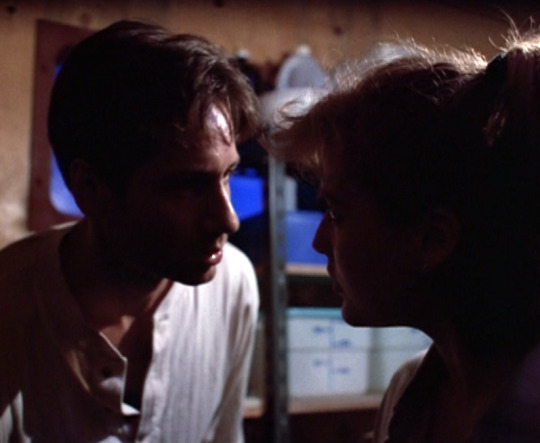

ROSE REVIEWS… THE X-FILES - S1.E8: ICE
<< 1.6 The Ghost in the Machine ————————— 1.9 Space >>
What a week it has been! What a month in fact (because that’s how long ago I started this recap). Ice is one of my favourite early episodes which explains why this is longer than the combined beards of ZZ Top. Someone teach me self control? Please?
Go under the cut at your own peril, here there be worms.
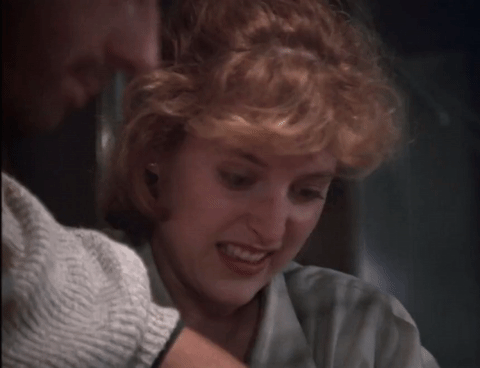
The Plot
Some dudes playing with ice have gone radio silent and left a creepy message, Mulder and Scully get sent up to investigate with a ragtag team of socially inept scientists and then cut off by bad weather with some seriously suspect wormlike organisms, and more sexual tension than you can shake an oversized drillbit at.
My Stream of Semi-Consciousness
YAY! ICE!
I’m glad they start out with the dog just nommin on something spilled instead of one of the dead people. It makes it easier to root for him later which is good coz it’s a cute dog. Apparently it’s also Blue’s dad!
Then there’s what appears to be a disembodied limb in a box. Why I have no idea. but I am soon distracted by the entry of this dude who appears to have been scorched, stripped and then attacked in an incredibly symmetrical fashion by a pair of clawed ketchup bottles.

Like c'mon prop monkeys! Blood is NOT that colour and when did you last see someone with matching pectoral wounds (given it’s not sex related… probably). Also now I’ve been looking at it for too long and I feel like he has one nipple that is significantly bigger than the other and I’m having trouble moving past it.
And WHY is he shirtless. At what point in the whole fighting to the death in the ARCTIC was he like… wait mate… I need to take off this shirt off because #aesthetic.
Though to be fair I probably would.
Aaaaanyway
His radio makes more noises than the tardis.
We’re not who we are. Okay. We get it. But on a serious note do they ever actually discuss why he says this. Because I feel like grammatically it’s questionable and the space worms seem more into murdering each other than making dramatic speeches.
His assailant looks very heeeeere’s jack" and is wearing a shirt. I’m rooting for him until they get into the worst duel ever. Don’t put your guns so close. This whole bit tbh. The worms seem to have very complicated motivations and choreography, Maybe they’re abstract prehistoric space worms. Am I making sense. I don’t think I’m making sense.
It’s okay though I can compose myself during the CREDITS.
This video from the dead science dudes is the dorkiest thing I have ever seen. There are quilted body warmers, pasted on smiles and overenthusiastic high fives. You can see why these guys are extras and not the series stars. But at least they were all having fun before they brutally killed one another.
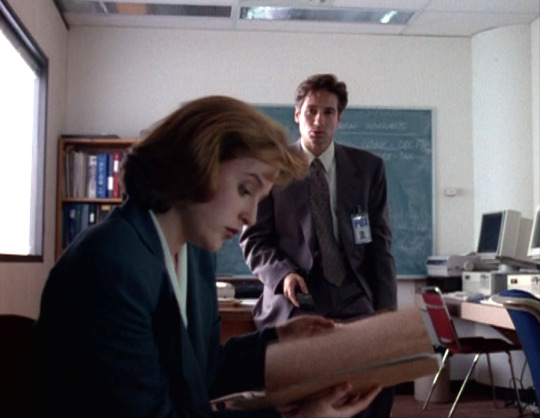
Mulder and Scully are watching this video in a room with both a blackboard and a window. Where are they? Is the basement being cleaned? Is this Scully’s office? If so why does she have so many damn tables!
Why do people insist on digging into old ice/trenches/under the sea. It always ends badly. EVERY DAMN TIME. Cthulu is down there people. Or godzilla or some shit. Just leave it alone and make nachos. Much better.
Not to be pedantic (okay who am I kidding) but pretty sure the background here doesn’t match what was behind him in the scene.

It’s only 1993 goddamn and Gillian Anderson is already learning how to ruin us all with her exquisite face. We were all screwed from the first time someone pointed a camera at her. All her tiny facial nuances remind me of the queens of old Hollywood and the things they could do with a quirk of the lip.

Then Mulder squats down and grins at her and though he’s basically implying they’re being sent as sacrificial lambs he doesn’t seem too sad about the concept of being trapped in an igloo full of corpses with his partner. He goes from amused to gleeful when he tells his teeny partner to bring her mittens and I’m thinking Scully seems excessively perturbed at this stage… is she having a moment of forboding? Or does she just really hate Alaska? I mean this is pre Palin so there’s no good reason to be quite so down on it…

And heeeeere’s Denny
Not content with really loving rocks (geologist) and being called Denny he also likes to do this in public places.

Denny is not getting any.
I do miss cassettes though.
Enter small winterwear troll AKA Dana Scully in a jacket so big she may be wider than she is tall. Mulder in contrast appears to be wearing jammies, jeans and a jacket, which are - incidentally - my three style essentials. Well those three and a resting bitch face.
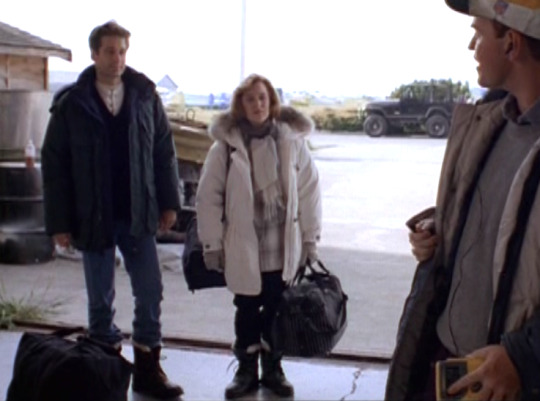
Mulder makes awkward chat about San Diego while Scully pulls a face like she didn’t used to live there and then the other scientists arrive and they engage in a charade worth of the Chuckle Brothers with IDs, “It’s me! It’s You!” Mulder even checks Scully in case, one assumes, somebody else was hiding in her coat and has leaped out to replace her since he introduced her to Denny less than 30 seconds ago. Possibly he just uses it as an opportunity to sniff her. He’s only human and I would… I also feel like at this point the writers were overly concerned with linking back to “we’re not who we are” from earlier. Every single combination of the words “we”, “who” and “are” is well and truly thrust in. And we’re only at 7.12.
Also hello Felicity Huffman.
“Two federal agents, a geologist, a medical doctor and a toxicologist” sounds like the beginning of the worst walked into a bar joke ever. It would have some incredibly scientific punchline probably involving the word ampule. I’d try and write it but… we I can’t be bothered!
Everyone is so weird and cagey. The script must have been full of side-eye instructions. A word to the wise - if you’re ever asked to go on a business trip where people are behaving like this, don’t go. It’s the start of a horror film and you will die.
Especially if someone else there is called Bear.
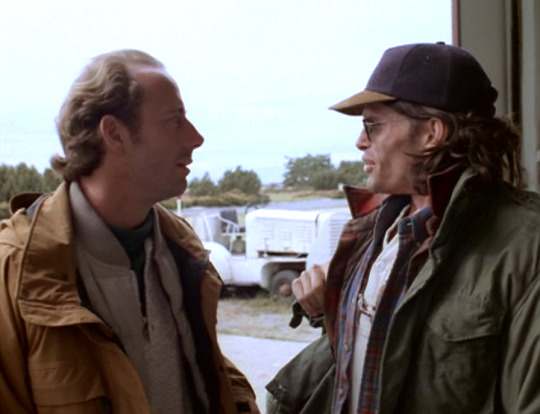
Bear could be Steven Tyler’s brother. Or maybe they just have the same surgeon. His car is the only car in the universe dirtier than mine.
And after Scully standing weirdly close to Huffman (I forget her character name) for way too long (like seriously? SO strange), Mulder trying to reassert his Scully monopoly with some unnecessary touching (DRINK!) we see some stock footage which can only mean we’re up, up and away.
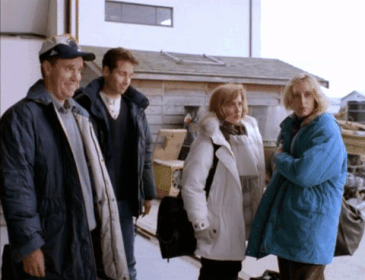
Icy Point and the power’s off. Of course. Do they ever investigate why the second they arrive anywhere the lights stop working? That’s a damn X-File.
For guys who blew their on brains out these dudes are artfully arranged. And pretty sure one of them is tensing. You’re dead man. Nobody cares about your abs anymore.
Scully says ‘flashing’. She means the camera. Epileptics on set can thank her but I can’t help being disappointed. Imagine if she meant her boobs…
Mulder comforts Felicity Huffman with his intimate knowledge of arctic research generator noises. Who knew Oxford university offered so many eclectic courses. Unfortunately they didn’t offer one in dog combat because Mulder goes down. Pretty sure Huffman falls over too but only out of shock or being knocked off balance by her coat.

Poor Bear is bleeding ketchup so we know he’s fucked. It’s fine though, Scully is a medical doctor and she finds some super gross disease beans in the doggo’s armpit which means she will also save the day. Standard.
Worm under skin, WORM UNDER SKIN! Ths grosses me out every time so drink every time we see unnecessary subdermal wriggling. *drinks*
Scully has completed five autopsies before anyone else has done more than get their coat off and get infected with a space worm, but ruins the effect by brandishing a used and uncovered needle with gusto whilst doing her jargon spiel. She may just be trying work out how to rescue her hair from it’s current anti-gravity state, her fringe is levitating at a sweet 120 degrees from her forehead which has got to be upsetting when you’re as put together as Scully is. Regardless,

Mulder seems unperturbed but may just be distracted by Bear wigging out about his own personal armpit beans.
There are some high quality knitwear/ winter neutrals going on in this episode. Maybe they were sponsored by fruits of the loom or some shit.

Mulder and Denny get all excited about satellite pics, apparently Mulder’s interpreting skills around some sort of bizarre geological scanning are rusty. TRY NON-EXISTENT MULDER. YOU DON’T KNOW SCHIST ABOUT GEOLOGY! Sorry. For the pun and the yelling. But seriously. If I made a list of all the things Mulder and Scully know that they shouldn’t…
DINOSPERM! Dinosperm. Does whatever a dinosperm does.

The second Mr Bodywarmer (I can never remember anyone’s names so tis is what I’m calling him) disses Scully’s autopsy skills you know that Mulder’s gonna disagree with him. Contagion be damned, suggesting Sculy has missed something is a no no - even in Season 1 - and especially when she’s pouting like this.

Oh no! Mulder says they have to stay (my favourite trope), Scully pulls the doctor card to seal the deal and now there is no way they’re not having arctic sex right? Everyone gets some… well except Denny who kills the mood by opening up way too easily about his bowel movements. Poor Denny. High school can’t have been easy for you.
But it’s fine because Bear flips his shit, or more specifically flips out about a shit, and everyone has other things to worry about. After some arctic democracy which really draws a solid line between Mulder/Scully and Huffman/MrBodywarmer (in case you’d missed all the other clues) and emphasises the disposability of poor Denny, they pull a gun and shit gets real.
Down goes Mulder!

Down goes Scully!
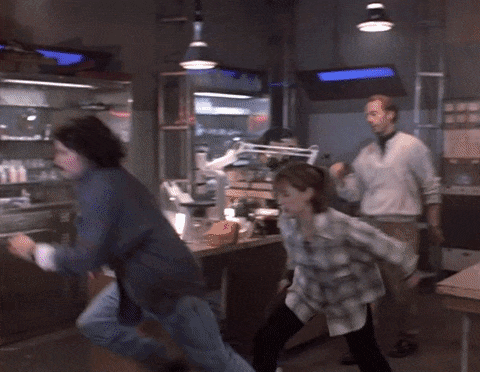
Turns out big man Bear is no match for Macho Moose and Flying Squirrel. The others prove once again to be utterly useless, standing about and watching. Honestly, given how much Mulds and Sculls know about other science they should absolutely not know, the the rest of the cast seem kinda superfluous other than as human coathangers for knitted beige monstrosities.
WORM UNDER FLESH, DRINK.
Impromptu surgery always makes me squeamish so lets not talk about this. Suffice to say its gory and ends poorly for Bear. RIP buddy, you were kinda a douche and your hat was stupid but nobody likes a neck worm.
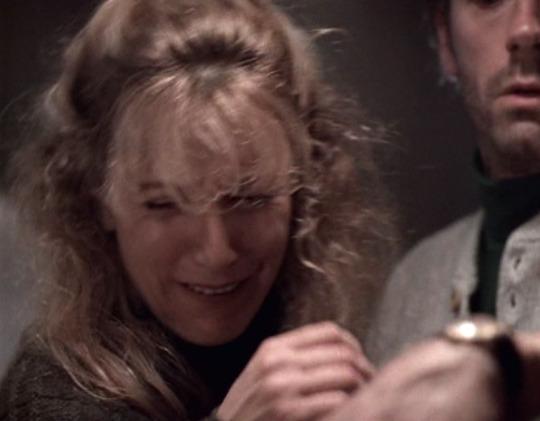
Just keep drinking till it’s over.
The woman on the radio is semi-peppy given she’s just told them they’re stuck. Maybe she’s drinking whatever Sarah Palin is on.
Sculy’s OCD hand washing is adorable and I want to pet her. And the others are all still just standing there though now with a corpse centrepiece. React people! Do something!

Top quality CGI right here! Wormeo is looking fine and definitely three dimensional.
The worm theory is all very plausible, except that the last bit makes no sense. The worm doesn’t want to kill it’s host, just the hosts with its pals in… so what is the worm’s end game? Last worm standing? Any thoughts?
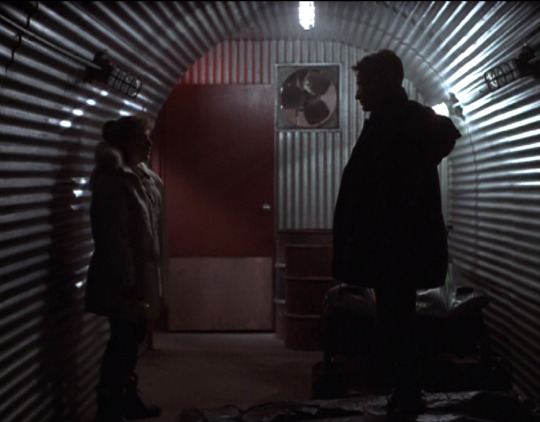
I am all about the aesthetic of this next scene The half light the corrugated metal with shadows and the height difference all in silhouette. It’s even added to by Mulder’s signature monotone rant. But the problem is, I’m so MSR thirsty that when this happens…

I just want them to throw down and get it on on the floor. KISS! NOW! Corpses be damned. See, This is what this show has done to me. I used to have standards.
Denny is not down with all the tension so he retreats to baseball while Huffman and Bodywarmer, who bicker like Mulder and Scully but lack ANY sort of chemistry (this is the show we might have gotten if the Gillian/David alchemy hadn’t happened) conspire like a pair of whiner babies. Bodywarmer is as paranoid as Muder, but he’s also an assclown.
Then Mulder and Scully take their coats off in a dramatic way and once again my mind is in the gutter. Which is actually appropriate as it’s naked spot check time and things are about to get a little homoerotic. Pretty sure Mulder lost some sort of bet when Scully was the one to suggest a naked group activity. Also pretty sure he was disappointed that it was just another spot check and that he wasn’t invited.

Leaving this here for science.
There are multiple documentations of the exceptionally sapphic encounter between Scully and Huffman, whoever decided to light them in red while the dudes got to strip off in a normally lit room was certainly only aided by the fact that Scully's jabby doctor hands from later series have not yet developed.
My main takeaway other than this being basically the only scene in which Huffman doesn't irritate me (and I think I quite liked her in DH though I can't remember a damn thing that happened on that show), is that Gillian Anderson has more chemistry in a fraction of her lower lip than most people have in their whole body. I mean seriously: authority, vulnerability, comfort and a little sex all in one move. This little thing?

She would probably have chemistry with a rock if she needed to. How is it so effective? How does one scene that lasts less than a minute have more relationship in it than all of Huffman and Bodywarmer's interactions combined? How is the entire world not worshipping at her tiny feet?
And the award for least comforting bedtime sendoff goes to Mulder, for both bringing up bugs biting (as if they're not already freaking over dinosperms getting all up in their spines) and then shooting down Scully's attempt to normalise things. "The spots on the dog went away". Really? She's lingering outside her room, and instead of being nice, or comforting, or taking her mind off things with some vigorous shagging you give her puppy eyes and a shortcut to nightmare town?

Go to bed and think about what you've done Mulder. Leave Scully alone with your comforting words, ominous lighting and a dead man's half naked lady posters.
Cue montage of nobody coping in different ways with Mark Snow blinky-blonkiness to up the tension.
As a an unapologetic Scully fangirl I do sometimes forget that at this stage, Duchovny was very much the star and focus. Scenes like this remind me, where we watch him get dressed (I am fine with lots of shirtless Mulder), wander about, do reacting, hang out a little with this cabinet that definitely looks like it has a face and could just have eaten Denny on it's own...

Anyway my point was that as much as Gillybean is growing as an actor and making herself felt in the episodes, studio intentions be damned, this is all DD, prowling about with drama and he does it well. Also you can see his nipples through his shirt. Clearly my priorities are straight. Well... mostly.
That said. Mulder is an idiot. When a cabinet is bleeding, what sensible person opens it while squatting in front of the spot where clearly a corpse is going to fall out. He didn't learn that brand of idiocy at the VCU.
Speaking of Scully asserting herself, Bodywarmer (I think his name is Hodge?) and Mulder get in to a sweaty macho shout off and teeny Sculls gets in the midde. Huffman just kinda floats about.
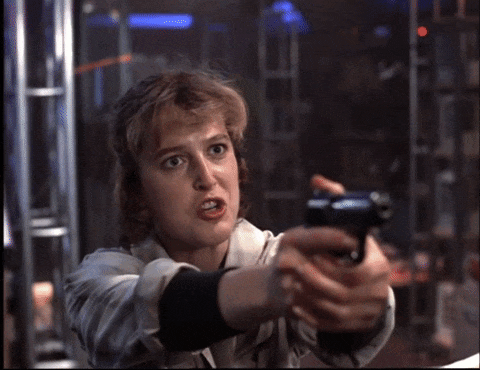
And we have a series first! Mulder and Scully hold each other at gunpoint! Loud noises! Angst! Betrayal! Delivery of the episodes motto which STILL makes no sense."You may not be who you are?"" Well no he is him, he just might have a worm in his brain But points for consistency. Shame it doesn't apply to the series overall plot arc!
Anyway, in the end it's fine because Mulder relents when it becomes exceptionally clear that for all that she's smol and mostly calm, Scully will shoot his ass, though she'll feel a bit bad about it. At this realisation Mulder goes full puppy and lets his owner put him in a pen. But he doesn't get shot. Yet. Little he knows...
So Mulder gets shut away. It's totes emosh. Like Celine Dion backing track emosh. Mark Snow step aside because this bish has spare time and windows moviemaker...
youtube
Moving on...
Pretty sure that fluffy!Scully striding in a plaid shirt with a gun is my spirit animal.
It's super convenient that both members of team non-MSR are sleeping in ridiculously uncomfortable positions, despite the recent excitement, so Scully can be forced to surrender her weapon. But hey - we only have 10 mins left and the plot must go on.
Bodywarmer decides the time has come for him to be alpha male but unfortunately, everyone still hates him, Scully doesn't want in on his shitty duet, especially when it's clear that he'd toss his partner in a second. Huffman finally grows enough balls to suggest Scully might have a point about not turning on each other and looking for treatment but his ego is out of control.

I really wish Bodywarmer had gotten eaten instead of Denny, Denny and Huffman could have been useless fuzzballs together and the only thing I ship Bodywarmer with is my booted foot making hard contact with his testicles after his misogynistic asshole moves in the lab. I'm starting to understand why Huffman has no personality. Scully starts to realise she got preeeety lucky that Mulder's just an alien obsessed puppy and not an utter fuckboy, before snapping back in to science mode for wormageddon.
I'm gonna take a moment here to shout out Lila (@startwreck for the following graphic). Theses two animated worms even have more tension than Bodywarmer and Huffman. So when we did the group rewatch we may have turned it into a fix that the worms were in love...

Me and the space worms have one thing in common. We do not like company.
WORM IN DOGGY EAR! DRINK!
Not sure how a stethoscope would prove the worms inside the dog were dead but I'm not a medical doctor. Either way, Mr Woofty is okay and lets be honest, aside from Mulder and Scully he's the only one I care about at this stage.
Tfw bae may have a brain worm but you wanna be sure and one of your companions is an asshole and the other one is actually the neck worm's host.

Poor Mulder isn't even allowed to accustom his poor little molerat eyes to the light before having to defend himself. Which got me thinking... the light switch is inside the room. We saw him turn it on earlier. So he's sitting in the dark of his own choice, just to make himself more tragic. Precious baby.
This face could have been avoided.

This scene though, this could not, There is now a section in the FBI handbook called, "Protocol for the investigation of possible parasitic space worms", this inspection is the example of how not to do it. Ably assisted by D'Angelo and my amazing video skills once again I give you - "this would be sexual harassment if they weren't both so into it - so don't try this in the workplace kids"
youtube
Scully comes out with Mulder in tow like the kid who came home from school with a friend who wasn't invited. "Mom I know you said no but look at him". After a quick round of, my partner is less infected than your partner, they get ambushed, Scully makes the squeakiest squeak of a no that is still audible to the human ear and finds herself in the sex cupboard.
Commence a struggle scene worthy of You've Been Framed, drink for Huffman's neck worms and also for this face.

In her struggle to escape a worming, Huffman pauses long enough to through some vials off a freezer shelf, that she has to open. Before she goes for the gun. Logical. And then they all have sex on the floor. I mean seriously.

But it's all good coz she gets to gnaw on Mulder's pec while the worms do battle royale in her pituitary gland and everyone makes it. Well except Bear and Denny. Huzzah! Scully gives Huffman (whose name I have just discovered is Silver or Da Silva which I'm sure I knew when I started this but honestly that was weeks ago so...) a celebratory belly rub.
I'd take it.
They finally escape, and Mulder of course wants another round trip to hell but hell has been torched. Scully does a good job of looking sympathetic in front of Bodywarmer, but as soon as they're alone she tells Mulder how she really feels. To paraphrase, no, she doesn't want to play with ice worms of death any more and yes she would rather be in Aruba. But she does wait for him. Maybe so they can finish what they started in the sex cupboard in the SUV.
I hope,
And so it ends..
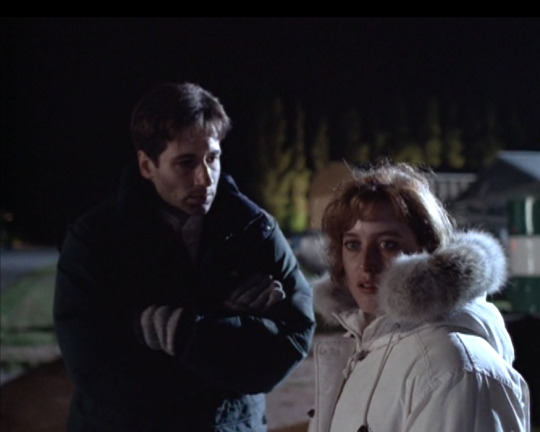
Quick Score (Full Deets in the top pic)
Story: Original, bold and pacy - 9/10
Mulder: Broody, ballsy, sexy - 8/10
Scully: Smart, sceptic foil to the crazy - 8/10
UST: The first suspense episode, creepy original goodness 5/5
Other Cast: Solid ensemble of misfits delivers - 8/10
Bonus Points: Hot damn sexy moments, extra gazing, partner doubting, memorable, my fave 5/5
TOTAL - 42/50 - Grade A and new topspot sitter!
Join us next time for more ridiculously overthought brain farts
<< Previous Episode || Next Episode >>
118 notes
·
View notes
Text
Real Lawyers Have Blogs with Tanya Forsheit
youtube
Kevin: This is Kevin O’Keefe for real lawyers have blogs of all things and who am I talking with?
Tanya: Tanya Forsheit the chair of the Frankfurt Kurnit Klein & Selz privacy and data security group.
Kevin: I first talked to you when you called one evening and said, this is Tanya Forsheit from Proskauer and I’m going to do a privacy blog. How did that come about in your mind?
Tanya: It was a really long time ago, I think that was in 2006 or Like that and I was a like a senior associate and I was trying to develop privacy practices at a time when privacy was really not so well-known. As a legal practice, we had breach notification laws and in California, we had some other laws, you know, Cal APA and things like that, but wasn’t that well known. I had an idea, as a senior associate at a large law firm. The idea was, how do I make people aware of my expertise and my knowledge and that I’m doing this and blogging was around already for sure.
There were some large law firms that already had blogs, they were many, there are few and I had threw that doing some research had discovered your company that was helping law firms, new blog specifically. The idea had first come from even like a business development class, I was doing that maybe blogging was a good idea. I thought well, let’s give it a shot, let me get some information. The Firm was open to me finding out what would be involved and then we had to make the case for it, but yes, that was how it happened.
Kevin: When you saw the privacy isn’t, you saw it as an opportunity?
Tanya: I did, I mean certainly no one could have predicted what has happened because at that time remember there wasn’t even really Facebook. Facebook was still like a Harvard thing, and social media hadn’t exploded the way that it eventually did and we hadn’t had many of the large breaches that have attracted attention from the c-suite, boards and created the I mean the public consciousness of this has changed completely. Then over the last few years with things like the Edward Snowden revelations and Facebook Cambridge analytical, everything has changed.
I picked well, but it wasn’t known and there was a lot of skepticism. There was a lot of skepticism in the legal community about privacy as an illegal practice for sure. So this was a way to get more visibility.
Kevin: One of the things I tell lawyers now is rather than just say, okay I’m in this practice group, we’re struggling and I’ve got huge competition so I’ll start a blog and everything will be better in my life, but it doesn’t really work out that way. You better off to sit back and say where might the opportunity to be in certain niches.
Tanya: To be honest with you the big thing that was even more important came not long after I started the process our blog I decided to go out on my own and start my own firm called info log, which is still around as well. Blogging that started in 2009, blogging was at the absolute core and heart of what we were doing in launching that firm because that was how we were putting out our knowledge base about lots of things, privacy issues, data security, cloud computing which was really big and growing at the time, we did a whole series of blog posts on cloud computing that got huge response. I mean even to this day, I think some of those 10-year-old blog posts are still around.
Kevin: Who is the driving force and saying, okay we’re going to blog, and we’re going to build notoriety through blogging.
Tanya: In that situation and it was both myself and Dave Nevada who was one of my co-founding partners who’s now it Coolie, he was blogger even before we started the firm he had his own blog and was doing a lot better.
Kevin: What I remember about that site was it led with the content. So it wasn’t like, okay here’s everything our firm does, here’s your pictures of who we are, usually went to school you led your insight and commentary.
Tanya: At that time we wanted the blog to be the website and obviously over time they’re different philosophies about how that works. Doesn’t work I think today things are different to some extent but at the time it worked well because that was how people got to know us and I still run into lawyers and other people these days who will know me through that and its need that we were able to develop a brand. I mean really a brand in a reputation through that.
Kevin: What have you learned from blogging and maybe even better question, what has it done for you? I mean you just said brand, if you look back on it over the years, going back a while.
Tanya: I’ve done it each law firm I’ve been, I did it Proskauer, it info Law Group did a bigger Hostetler when I was there and we’re doing it here now, although and I’ve already said big caveat for those are going to go to our blog which is focused on the data, we don’t blog as often as we like to but that’s because we’re so busy.
Kevin: You’re not the only one it has happened to, you are at work.
Tanya: With the California consumer privacy act. The biggest thing it’s done for me is you build your brand and my brand is built not just associated with the firm’s I’ve been with but for me, which is surprising and interesting, but I’ve become known individually through it as well because I’ve been willing to go out and write things that are not necessarily always the like lawyer Lee, like I’m writing a sort of a scholarly article or I’m just writing like a little blurb. It’s something in between where I really am sharing some knowledge, I’m not giving legal advice but I’m sharing some knowledge that is unique to my perspective and based on my experience within the industry et cetera.
That’s had huge returns over time. It’s not just individual it, it’s rarely just like I wrote this article and then somebody thought and called up, that happens sometimes but more often it’s the collective of somebody is looking for personally. particular expertise, goes online does they’re searching and all of that comes up all those old blog posts, word of mouth et cetera it’s just adds to that reputational and so one of the reasons why I’m so busy today, fast forward from 2006 to 2019.
Kevin: Jeff Noah is now at littler blogs on FMLA said the same thing elevated him to a trusted advisor status and it took time, it wasn’t like it happened, somebody clicked a button and said I saw your posting I’m calling you up and he also said what you said to he used the term helping people you shared some knowledge that people could find of help. When you were blogging, Proskauer and then coming on with your for Law Group, when you were hitting your stride logging how much time we were spending on it?
Tanya: It really varied, I’m sure there were Point in time when I was spending a tremendous amount time, but usually what would happen because think back to the times when there was a really good post and usually what would happen was you just sort of get inspired by something like you would with any writing like and I like to write I mean that’s another thing is like if you don’t like to write, you’re probably not going to like blogging but if you like to write that will happen to me, I’ll get inspired by something and want to write about it and so it’s just sitting down and putting pen to paper and then those would just flow so sometimes it would take couple of hours sometimes it might take longer.
There wasn’t just me, that was my colleagues and I’ve had that experience even here where something has happened, a good example I can give you here my partner Jeremy Goldman who’s a litigator here, but he does some privacy stuff as well and he does kids privacy Cava. I don’t know two years ago the show Silicon Valley had an episode about Kapa and it was actually much more legal focus than in it’s hilarious. It’s a hilarious episode of the show so Jeremy was inspired by that and he sat down that night, I think he did it overnight and wrote a post about the Silicon Valley episode of about Kapa and what was accurate what was it?
That happened so you spent a couple of hours and you crank out something really good, I don’t think that good blogging should take more than a couple of hours at most to have something solid. You don’t want it to be super long and crazy, I mean occasionally, it’s nice to have a really meaty post and we used to talk about that info Law Group. We would do short ones and then we do something really longer but no, I mean you could do something in an hour if you really wanted to so an hour or two a week is probably something ideal, I think for maybe more for people who are really confident.
Kevin: Think about what that accomplishes of building a brand. I was talking with Amy, SCOTUS blog on Monday when you realize hundred people have contributed to that blog this year. She’s gone at the Supreme Court in the morning before we met, that’s a totally different deal.
Tanya: That’s actually one of the ones that were like, I mean, I still think of that like one of the very best right, there’s the SCOTUS blog. There’s like air Goldman’s technology marketing Loblaws and those people I mean those are the ones who are really at the top of their game and I’ve done like guest post for Eric also like they did that’s the other nice thing now, although I should do more of my own blog but yes.
Kevin: Eric moves from Marquette to Santa Clara on the back of that blog because I met him that way.
Tanya: He has one of the very best I mean, there’s no question and people use it as a resource, I mean lots of lawyers.
Kevin: You’ve mentioned some things already, but if you were talking to a lawyer that was on the fence about starting a blog with now starting a blog you’re talking about the time, you’re talking about writing. Although I started a blog because I was in a non-compete and I wanted to learn to write better. After having practiced law for 20 years, I thought I could write like a person and this would be a good way to practice that we can even put that under here. So I concluded that you can you can write bad but for only so long after your blog, but what other advice would you give somebody that they were on the fence about thinking about doing it?
Tanya: You do need to be committed to it. It’s problematic if you’re going to do blog and you’re never going to do it and I continued to struggle without to this day. You have to be committed they’re going to keep doing it and keep blogging but if you’re on the fence, if you feel like you have something to say and to add to a conversation about a particular legal topic that’s unique, especially you’re trying to establish yourself in a niche space, it’s a really good way to do that because it does raise that visibility through not a whole lot of effort especially if you like to write and you can write about things that you’re already working on not obviously they were privileged that you can’t get the cleanser.
You can write about topics that you’re working on or something that you might otherwise need to do. There is such a thing as repurposing which doesn’t mean that you should write something and then post it everywhere it means, maybe you’re doing a presentation and that something goes hand-in-hand with that and it all comes together. Then once you have all this content you really can use that in other context you can do presentations, you can use it in your own client work.
Kevin: What about the importance of a niche?
Tanya: Is important, because if you’re just writing about the same things that everybody is writing about then it doesn’t matter and so was one of the reasons why ours was successful early on both prosperity of the letter-writing about stuff that wasn’t being covered as much at the time. I mean now I don’t know how many privacy blogs security are out there, here are many.
Kevin: Proskauer got busy. Everybody else got busy blogging.
Tanya: Everybody has a privacy blog. If you’re writing not just topics that are unique, but if you’re bringing a different perspective to it, especially if you’re willing to be not so weirdly and by that I don’t mean like say things that wouldn’t be appropriate for a lawyer to say what I mean is don’t talk about it the way any other lawyer would talk about it, be yourself, have your own voice. When people talk about both blogging and social media. This is true not just in legal if you don’t have your own unique voice, you’re going to be boring and it comes off as advertising or comes off as just a news flash that everyone’s already seen before or headline. You have to have a sense of humor, you have to bring something unique to it that’s going to draw people.
Kevin: How did you figure this all out? Maybe it was just over the years by the seat of your pasts because you could go out and teach a course now?
Tanya: I figured it out because I had too, I really wanted to have a successful practice and I had come out of being a general commercial litigator which I enjoyed I really but I didn’t see an ability to turn that into the tice of my own that was unique to me and I was lucky to be in a place where privacy was an option and there were other people I was practicing with, I was lucky that the blog had also come out I should say. Proskauer had come out of a book, a treatise there we had done a Proskauer on privacy treatise through PLI that Chris Wolfe who at the time was Proskauer then went on to Hogan had done and so the blog was sort of a jumping-off point from that.
It could be a continuation because you can only update so often and then you’ve got this book that paper has to be inserted. Blog you can keep much more current and you can have topics that are much more timely.
Kevin: Not pocket parts anymore.
Tanya: There still are.
Kevin: How’d you get the other people in Proskauer? It sounds you had this idea, the firm says, okay you can explore it but other people jumped in that Proskauer, how did that all come about because usually you’re not going to have the associate give the free range to do that and then bring everybody else in?
Tanya: For one thing I was pretty senior even though I was an associate and I was to the firm’s credit. I was somebody who they treated very well and they had a lot of regard for and so they gave me– I certainly had to prove that this was something worthwhile but then once we did that there were a group of Associates and we didn’t really– I mean we had a privacy group of there weren’t that many people who were really technically privacy there were litigators, they were corporate people and so all of us we’re just wanting to be involved because you get your name out there at that time that was very appealing. As a way for a more junior person to become known as associated with something and Google yourself and your name show up.
Kevin: It’s amazing.
Tanya: You get news alerts about stuff that in especially the other thing that happens is that journalists, as you know, pick up on the stuff. You get journalists who will want to take your content and do something with you. You also get people who call you for interviews about you become sort of a quoted expert, so if you’re an associate that’s an opportunity that it’s different from, I’m just going to write this brief and someone else going to take credit for it and have their name on it. One of the very deliberate decisions we made at Proskauer and then also at the other firms I’ve been at is the blog posts are in the name of the person. Some firms have decided to just say, by Proskauer or by Frank Ricard whatever which is fine is another way to do it.
Kevin: Doesn’t work very well.
Tanya: I’m not going to judge but when we started each of these we were blogging in our own name and as I’ve left some firms in the interest full disclosure sometimes and this is not surprising. I don’t blame anybody because those are from blogs so sometimes my name has become a firm name, which is fine. I’m still very proud of that content, I still consider it very much at that I created and I am very happy about that but that’s how you got people involved. I mean, of course when people are busy it’s very hard to get people to continue that momentum. I have found even here today even when were super busy if there’s an associated really wants to write about a particular topic. You cannot stop that person, it doesn’t matter how much they have to do billable work. They will find a way to find way to do the middle of the night because they want to get that out and they want to make that statement.
Kevin: I mean it’s still, after all these years it still works.
Tanya: It does, it’s fascinating.
Kevin: Publishing always worked, if we probably look back long before we were lawyers, 150 years before what did lawyers do, they probably spoke, they were interviewed they wrote absolutely and we’re just doing it digitally today.
Tanya: Well, the thing that both I love it and it drives me crazy is when I’m sitting in a meeting it could be here. It could be out in the bar association world or something and somebody goes he are going to blog, like no one has ever thought of this before, blogging and it’s like yes blogging of course but you’re it’s just as effective in just as compelling now, and that’s why people are still like you know light bulb.
Kevin: You need to have an individual that becomes the driving force for a little bit of energy because sometimes firms will say we have to have a blog and if I ask them what the goal is the goal is to have a blog that’s really not a good enough goal, what’s going to measure success? Well, we’ll have a blog and then it tends to die out because nobody’s passionate about it. I still think passion is real important, there must have been some passion that you had for privacy law back then and I still do.
Tanya: For sure still do, I think then I was intrigued by it and I wondered what the possibilities were. It had some interesting relationships to other things I’d done and enjoyed on the intellectual-property side, even on the traditional property side and so I wouldn’t have imagined that it would have been as high profile of a practice as it turned out to be which is a surprising thing.
Kevin: You must have some moments when all of sudden this stuff started breaking you go holy cow.
Tanya: Absolutely, it’s and it’s been fun to watch the rest of the world catch up and then to also have people who consider themselves to be Old Timers in the Privacy world who have only been doing it for say five years there. Our people believe it or not and I’m not even the most senior of them by a long shot. There are people who’ve been doing privacy now for maybe even 20 years, meaningfully. A lot of them in DC where it was something that started a little earlier and those are the real pioneers but I mean blogging is something that allowed me and many others to have a voice.
Kevin: Well you mean I think at this point I’m your looked at this one, but one of the leading lawyers yet in the country.
Tanya: Shockingly, but apparently, yes, and since California has decided to stick it’s neck out there and wave the charge, it’s been an even more strange journey and experience. Yes. This is all one of those reasons. Certainly, my name would not have been known without blogging.
Kevin: Yes, because I’m seeing here today, we’re sitting in Century City, California, and I’m assuming you have a lot of clients. You built a book of business.
Tanya: Yes, yes. Over many years, yes.
Kevin: Well faster than you probably think.
Tanya: Yes. Actually, I mean in the grand scheme of things, I think it has been faster also because things move much more quickly these days than they used to. It’s still early I mean, I think your point earlier that it takes time, right? People can’t expect that these things are going to happen overnight but that’s what’s rewarding about it, is when they do happen. So I’ve had people that I’ve known in my legal world for 20 years who, maybe I knew them in some capacity when I was a mid-level associate somewhere, and now today, those people are my clients, and just coming to me because they think of me as a leading expert in privacy, and could I have ever seen that evolution happening? No, not at all. There’s just no way that that would-
Kevin: At the speed.
Tanya: The speed of- right, 10 to 15 years to go from nobody.
Kevin: Talk, yes, that’s why we talk- I talk to people, I said I haven’t joined the other State Trial Lawyers Association then nationally get on the board of these things and I still wasn’t there, and now people are doing it with publishing, and people might say, “Well, two years is a long time,” and I’m thinking, “That’s really relative.”
Tanya: Right. That’s very fast, yes.
Kevin: One question, we don’t have to connect it to everything else but if I don’t ask you the question my [unintelligible 00:21:45] will get upset, what was the problem that LexBlog solved for you as to why you have reached out and called me? [laughs] Because you could’ve done a blogger blog.
[laughter]
Tanya: Yes. Okay, so I was a very typical big firm lawyer in many ways, right, and it was like, “I wanna start a blog, I’m a lawyer, what do I do?” I probably google and remember- Actually, you know what, I probably had seen an article or something, because I think you are already getting press and “LexBlog” was getting a lot of press at the time, because it was catering to-
Kevin: Lawyers
Tanya: Lawyers and law firms and there were some big firms who are using you guys, so I think that’s where- because I knew that If I went to management and said, “Look, they are these other big firms who are using this as a platform,” right? It wasn’t just some random thing where I was going to spin up my own WordPress or something. That was why. It was designed, it was customized for lawyers and especially people who weren’t necessarily that savvy about how to do it.
Kevin: Yes, because when I started it, I think it was Rob Kahn and he was at Fenwick and may still be, invites me to speak at a conference, all these people are asking me questions about blogs and [unintelligible 00:22:55] announce me as the National Leader in Blog for Lawyers and I would type that blog, cost me four dollars for about 60 days. I thought it was all very funny, so then I go down to Tim Stanley’s place and Tim and his wife, Stacey had started fine law and I said, “Can you do blogs for lawyers because they’re free. I said, I’m a lawyer and I had a firm, I would be scared to death to do this, in fact, I’m really scared that they’re already finding my silly blog. It looks bad and I don’t know what to do.
[laughter]
Tanya: Right.
Kevin: Truth be told, that’s how the company started. I thought that lawyers are professionals, they didn’t want to look lame, they didn’t want to do anything stupid and they need to just relax about the process.
Tanya: Absolutely, no, I think you did, even if some of the things that were being done were relatively straight forward, having that as a platform to work off of, right, where you basically are logging in or you’re not even necessarily logging in. If you’re in a law firm and you’re a partner and you’re drafting something in word document and then either your assistant or an associate or somebody is going into this-
Kevin: Logs and publishes it.
Tanya: And it’s so user-friendly, etcetera, and it’s gotten obviously even more so over the years. It’s great, everyone here these days now, the lawyers themselves, they know exactly what to do, right? You don’t have to explain to them great detail.
Kevin: I was like, when word-processing came to me, I practiced law before there was Word Press.
Tanya: Right, no, now it’s very intuitive for them.
Kevin: Yes, I can tell somebody, “It’s just a Word Press Platform, oh that’s easy.”
Tanya: Exactly, yes.
Kevin: Well thank you very much, it is delightful.
Tanya: Yes, of course. Thank you, appreciate it.
0 notes
Text
Making a Murderer: Pamela Sturm, 'The Chosen One'
Part 1, Episode 5. Approximately 47 minutes into the episode, or 12 minutes in from the end.
Pamela Sturm with her daughter Nikole found Teresa Halbach’s vehicle on Steven Avery’s property. Sturm takes to the stand and gives her account of what happened. An initial once-over of Sturm’s nonverbal behavioural cues doesn’t bring to light any red flags that point towards deception, unlike many of the witnesses from the prosecution. However, since the public often portrays Sturm as a liar, I decided to look closer and scrutinise her body language and expression to make sure I wasn’t missing anything. I have indeed found a couple of red flags.
Pam Sturm–Body Language Analysis
Kratz
“Ms Sturm were you familiar with the Avery salvage property?”
Sturm shows a microexpression of anger, as soon as Kratz starts, on the word “Ms”. It’s a tough one to see, even to a trained eye. It’s mostly in her right eye. A slight narrowing as the lids tighten and her eyebrows pull together. Is this down to the situation of her as a witness, or is it aimed at Kratz?
As Sturm expresses anger she inhales deeply–she’s stressed, but wouldn’t we all be in those circumstances? Her head is fairly low into her shoulders. We call this ‘turtling’, it’s like hiding in the open, we do this when we want to avoid attention. Mid-question, she switches her pose to one of confidence, as if to say to herself, “I’ve got this”. Her neck and head stretch upwards and her chin juts out–we feel she has an air of superiority.
In just seconds, our subconscious brain has seen these behaviours and we’ve formed our opinion about her. Anger, hiding, superiority–the impression is a negative one. From that moment onwards confirmation bias kicks in and we start to inadvertently filter what we see and hear, altering our interpretation and perceptions of Sturm. I’m not immune to this, I find it hard to like her. So I go out of my way to remove the emotion and scrutinise the cues, looking for both positive and negative behaviours, to objectively understand what’s going on.
There are several behaviours throughout Sturm’s interview which suggest her feelings towards Avery are negative. Right from the start, as soon as Kratz mentions Avery, Sturm glares. Followed by a microexpression of contempt (hatred/disdain), a momentary tension of one side of the lips (her left/our right), on the word “property”.
It makes sense that her feelings towards Avery would be negative given that she found Teresa’s car there. However, if we consider whether this dislike of Avery was in existence from the outset (years, days, hours before), then it would make sense as to why she would want to believe Avery was involved, and therefore volunteer to search his property.
Sturm
“No, I'm not at… I wasn't at all."
Sturm shakes her head congruently as she speaks. But, by the end of her statement, she shrugs one shoulder, very slightly, showing a lack of confidence in her words.
If you’re already familiar with my posts, or with body language analysis, then you’ll know this can be a red flag when it comes to deception. However, before we jump to conclusions, let me emphasise it means; not confident in words. And let’s look at the context; she corrects her use of tense, from “I’m not” to “I wasn’t”. If she needs to correct herself, she obviously isn’t confident in her words.
A one-sided shrug is a common behaviour. Often, we do it with something as simple as not being able to find the right words to describe what we’re trying to say. There would be a lie there had she said, “I’m not familiar…”, as now, she does have some familiarity with the property. Though we can’t rule out a bigger lie (e.g. what if she knew more about the property from the outset), we can say with certainty that the simple correction of her words is enough to warrant a one-sided shoulder shrug.
Sturm
“All I knew it was a 40 acre plot, salvage yard for… vehicles.”
Again, Sturm nods in congruence with her words. As she reaches the end of her statement, she hesitates with a prolonged “for”, then pauses as she tries to find the right word–“vehicles”. During this hesitation, she shakes her head, flashes a microexpression of contempt, and her hands enter the screen with open palms. The raised open palms in combination with a shoulder shrug nonverbally say, "I can't do this". I suspect this is about trying to articulate the right word (vehicles). Most likely the contempt would be towards herself in her attempt to find the right word.
Kratz
“Ms Sturm, prior to your arrival at that location, had you had any contact or direction from any law enforcement persons?”
What’s interesting here is Kratz's body language and expression. He shakes his head and narrows his eyes at Sturm as he asks the question. Is this his attempt to manipulate her answer–a signal suggesting she say “no”? I doubt Sturm would pick this up consciously (did you notice it?). However, her subconscious would have picked it up, and therefore it could have swayed her response.
Sturm
“No sir we didn’t.”
Sturm shrugs both shoulders, showing confidence in what she’s saying. You have to be quick to spot this due to the camera work–we miss the raising, but see the dropping of the shoulders. So she is confident in her answer! I think it’s important at this point to remember that the question was specifically relating to “direction from law enforcement persons”. Had she instead been asked “Ms Sturm, prior to your arrival at that location, had you had any contact or direction from anybody?”, I wonder if her response would have differed. Perhaps this is why Kratz felt the need to reinforce what he wanted to hear by nonverbally leading her response.
Kratz
“Why don’t you show us then, where did you and Nikole start looking?”
Sturm isn’t visible at this point, so let’s jump to the next question.
Kratz
“Let me stop you right there Pam. Can you tell the jury what you were looking for?”
Sturm
“We were looking for any trace of Teresa. Be it the car, er, or herself”
Sturm hesitates before saying “herself”. As she says it, she eye blocks (with her eyelids), showing dislike. Then she looks to the left to gauge someone’s reaction. Who is she looking at? Is it the jury, her daughter Nikole, or someone else?
The other interesting behaviour here is in her thumbs. When our thumbs are elevated, the more positive our mental state or confidence. Thumbs pointing directly upwards is high confidence (in self or topic), disappearing thumbs shows a lack of commitment or insecurity. Just after saying, “herself”, and gauging the mystery person's reaction, Sturm’s thumb suddenly disappears into her hand. This is a negative gesture and either signals discomfort at the thought of finding Teresa herself (her body) or a signal that they were not looking for the body, only for the car, suggesting they may have been expecting to find it.
As Kratz starts to ask his next question, again Sturm turtles and inhales deeply, showing discomfort. Is this relating to her answer, or in anticipation of the next question? Either way, this behaviour doesn’t seem to suggest complete honesty. If she was confident in her evidence and open to sharing it in its entirety, I doubt she would be displaying this behaviour.
Kratz
“And after looking at those rows of cars, where did you then look?”
Sturm
“I continued up here and I saw these vehicles up here, and this is like a ridge up here. So up on the top there’s a little car path, and you can see there’s some vehicles here. And I thought I have to search up there. I have to search each and every one.”
Again, Sturm isn’t visible at this point, though the delivery of her speech sounds fluid and authentic.
Kratz interrupts
"And did you do that?"
The camera clips back to Sturm as she shrugs just one shoulder. Remember a single shoulder shrug shows a lack of confidence in words. It’s seen at the time of the words it relates to–in this case, Kratz’s words. We can assume that she didn’t “do that”. She didn’t “search each and every one”. Sturm avoids giving a direct response…
Sturm
“So I went up there and I went through, like, three cars.”
Sturm’s thumbs, once again disappear as she says, “three cars”. This is the third behaviour which suggests something is amiss with her account of the number of cars searched. The first being the shoulder shrug and the second being the avoidance of a direct answer.
Sturm looks away from the exhibit/image, as she starts to recall the chain of events:
“And I came upon this car–
Sturm’s eyelids flutter, a sign of emotional turmoil or high cognitive load, as she recounts this part of the event.
“that had all these branches on the top of it and leaning against it and there was an old hood of a car, leaned up against it. And it was kind of blueish-green–
Sturm exhales to release stress.
“and–
Another exhale.
“I thought this is really strange. This is really strange. And it looked like a little SUV like I was looking for, a RAV 4 Toyota SUV.
She nods in congruence with her words, then touches her forehead–a ‘self-soothing’ or pacifying behaviour to bring comfort when we feel insecure or stressed.
“And I went around to the back of the vehicle, and again there were branches leaning up against it, and I noticed that it said RAV 4. Well my heart started going, you know, oh my goodness maybe this is it.”
Sturm taps her heart with her fingers, mimicking the beat of her heart, then inhales deeply.
As she speaks, she uses her hands to illustrate her words. Her gestures, expressions and vocal delivery all seem aligned with her words, flowing fluently, both verbally and nonverbally.
As if lost in her own words, Sturm pauses with her hand on her heart–her cue to Kratz that she has completed her response.
“Let me stop you right there Pam…”
Her attention diverts to Kratz and her behaviour suddenly becomes odd. This does not confirm deception, though it could add to people’s dislike.
Composing herself, momentarily, with a false smile (see screenshot below), Sturm apologises. Her head drops and she pulls down the outer corner of her eye. This could be one of several things, either, a blocking behaviour, an attempt to catch a run of tears or suggest tears are present. It looks like an emotional display, genuine or fake, so I search for a genuine expression of sadness to back it up.
Only one in ten people can fake genuine sadness, so if I see it, I nudge closer to believing she genuinely feels emotional. The facial expression of sadness is observed in the inward and upward movement of the eyebrows and a downward turned mouth. It’s difficult to see in Sturm. Her eyebrows are not clearly visible and her hand conceals her mouth.
Sturm goes on to describe her worry for the safety of her and her daughter, with no mention or concern for Teresa. This seems to me very odd. Even if she wasn’t close to Teresa, surely there should still be some concern and sadness expressed. Is this self-centred approach another factor that leads to dislike?
Kratz
“When you saw this Ms Sturm, what did you do?”
Sturm
“I became very, very worried for our safety,
Sturm’s palm-down, definitive hand gestures are congruent with her words, as is her facial expression of fear and her eyelid flutter which again shows her inner emotional turmoil.
“because 90% this is probably Teresa’s car–
Sturm’s hands are now palm-up, but still congruent with her words. We generally show palms-up when we ask or question.
“and we’re in danger. So I called Nikole’s name.
Sturm’s emotional expression is one of fear, she’s feeling and showing the emotions of her experience. She touches her nose, indicating stress. Face and body touch increases during stress. Many people believe a nose touch is indicative of deception. However, this is a common body language myth. Generally, all we can decipher from a nose touch is stress. We can touch our nose when deception is or isn’t present, so we can never assume it to mean deception.
“I think I maybe even screamed. I shouldn’t have, but I did.
Sturm’s lips tense and stretch, one of the hallmarks of fear. Her expression and speech are aligned, as are her palm-up gestures, as she goes on to describe…
“And then went running to the area where she was. I said Nikole, Nikole, you have to come and see this car. It must be her car”
Once again, Sturm’s behaviour is in alignment with her words, she shows both fear and stress, through voluntary and involuntary gestures. It's worth mentioning here that we don't always cry to express sadness. Crying is a response to overwhelming emotion. Usually, but not always, sadness. Is that why I couldn't confirm genuine sadness? Was it because the emotion expressed was fear?
Kratz
“Did you attempt to verify the identification of this car?”
Sturm
“Yes”
Kratz
“And how was that done?”
Sturm
“My daughter Nikole, brought her cell phone along and we–I should back up–Ryan gave us a direct line to Sheriff Pagel in case we found something.”
Sturm nods, nonverbally confirming her words.
The camera clips to Strang, Buting and Avery. While Strang holds onto the table, compressing his lips, Buting’s expression says it all. He takes a second look in disbelief at what he just heard, a nonverbal “I’m sorry, what?”.
Sturm
“So I called Sheriff Pagel–”
Shocked by what he heard, Buting looks down. And with lips still tightly compressed, Strang turns towards Buting to gauge his reaction.
These emotional reactions from Buting and Strang were, I’m sure, very similar to yours on hearing this revelation. Though I’m guessing, if you were in the safety of your own home, yours would have been a little more pronounced!
This revelation and the manner in which it was delivered, suggests Sturm is open and honest in her account. If she believed there was anything iffy about the chain of events, she probably wouldn’t have volunteered this information, and certainly not in such a blasé manner.
Most significant here is Sturm’s statement–the fact that Hillegas gave them a direct line to Pagel in case they found something. This is very telling. Was he expecting them to find something, or did he give this direct line to everybody involved in the search?
Sturm
“…and I said I think I found the vehicle”
Kratz
“How long from when you entered that property did it take you to find Teresa’s vehicle?”
Sturm wrings her hands as Kratz starts his question. This is a pacifying gesture, a stress indicator.
Sturm
“I believe we entered at 10 to 10 and by 10:20 - 10:25 we had found the vehicle”
Sturm nods to confirm her words. It’s here I can finally confirm an expression of sadness–sadness combined with fear.
Kratz
“Ms Sturm, do you know how many vehicles are on this property?”
Sturm
“I didn’t at the time, I had no idea”
Sturm looks at the image of the salvage yard, nodding as she speaks. She is upset, we can hear the emotion through her voice and breath.
Kratz
“Looking at it now, do you think you got lucky?”
Sturm
“Yeah, well not lucky, God showed us the way, I do believe that”
Sturm nods affirmatively, finishing her statement with a lift of the head, another show of superiority.
Kratz
“And do you think that looking at this exhibit now, that you and your daughter Nikki could have searched that entire salvage yard?”
Sturm looks at the image, smiles and shakes her head in response to Kratz. At the same time, she places her index finger on her nose.
As previously mentioned, contrary to common belief, nose touching is not an indicator of deception. Instead, we class it as a stress indicator. This gesture is a little different in that it’s prolonged, so has a different meaning, generally indicating pensiveness; engaged in, or reflecting deep or serious thought. The positioning is also a little unusual in that it’s on the tip of her nose, a pointing gesture. In context, it’s likely that this is indicating self-reflection regarding what has been said, let’s pull a few points together:
Sturm believes God showed them the way
Sturm exhibited superiority
Kratz suggests that searching the entire salvage yard would be a difficult task
Sturm nonverbally says she couldn’t do it
Sturm smiles
Sturm reflects, deep or serious thoughts relating to herself
This suggests that Sturm takes delight in believing that she is the chosen one, and with God’s help achieved something close to impossible.
Sturm
“We would have tried, we would have come back the next day if we had to”
Sturm, overwhelmed with emotion, wipes the tears from the outer corner of her eye and again we see an expression of sadness.
Summary
I deliberately ploughed through Sturm’s nonverbal behaviour with a fine-toothed comb, for a couple of reasons:
I wanted to make sure my own confirmation bias wasn’t kicking in. We all have confirmation bias, positive or negative, with everyone we encounter. I find it hard to like Sturm and although I know this is due to her nonverbal behaviour, I’m still not immune to it. Therefore, I had to ensure I wasn’t filtering or interpreting my observations with bias. Let me add here that many people were against Steven Avery from the outset. Their preconceived ideas, or the impression they had of him, were enough to believe he would be guilty, and enough to assist in getting him convicted. This is wrong, but it’s also reality.
I know that many people believe Sturm is lying and I also know how dangerous that is in terms of false accusations. Again, I can refer to Steven Avery’s situation. It was important that I cover all bases to find evidence, for or against, this perception.
It appears that Sturm is generally truthful. However, there are a couple of red flags that point towards deception. Remember, we can't say for sure that Sturm is lying, only she knows this. Further questioning or evidence based around these points could reveal more.
Disappearing thumb, showing insecurity/lack of confidence when she said “We were looking for any trace of Teresa. Be it the car, er, or herself”. Suggesting Sturm and her daughter were only looking for the car. Were they expecting to find it?
The anticipation of questions. Was there a question that Sturm was hoping wouldn't come up?
A cluster of negative gestures (shoulder shrug, avoiding the question and disappearing thumb) based around how many cars/which cars were checked.
Perhaps the most revealing part of the interview was Sturm’s statement about receiving a direct line to Sheriff Pagel from Hillegas–should they happen to find something. I feel that we should look to Hillegas for further explanation of this.
Interestingly, Hillegas flashes a microexpression of contempt, during his interview, as he explains that Sturm and her daughter turned up for the search late! Is this a hint towards the truth? Was he expecting them earlier to fulfil this role? Had something been set up? Had he (or someone else) in some way suggested to Sturm that the vehicle could be found there? If that was the case, Sturm might not have been consciously aware of that. After all, she truly believes that God led her there. Could Sturm be just another pawn in the charade?
Final Thoughts
Using Pam Sturm’s analysis to improve the way you communicate?
I'll leave you with one last thought to consider–the importance of what you communicate via your behaviour, and the impact it has on others in forming impressions and perceptions relating to you.
Negative signals can do a lot of damage to how we are perceived by others, therefore impacting our relationships. Positive signals, on the other hand, can have a halo effect, where everything we do is seen in a positive light.
If you’re aware of nonverbal communication cues and their meaning, you can break existing habits and create positive habits, altering behaviour to create a better impression. Just as we can adapt our words, we can also adapt some nonverbal cues. For example, some nervous gestures like self-soothing behaviours (face/body touching) can be reduced. Though, it’s important to note; nobody can control all nonverbal cues in unison, or involuntary cues, such as blink rate, eyelid flutter, shoulder shrugs and autonomic nervous system.
Part of my purpose for writing these reviews is to teach you about nonverbal behaviour so that you can use your knowledge within your interactions. In this review, I’ve touched on the importance of the first impression on how people form their opinions of us. You can alter your behaviour to improve the way people perceive and interact with you. If nothing else, evaluate your behaviour–and notice the difference in how you are positively perceived.
0 notes
Text
How do you become a prolific artist? 8 secrets no one says outloud
Last month I attempted my first plein air painting in Montrose Park in Washington, DC. I was very nervous and had a lot of doubt: “I’m supposed to be an artist! I have a degree in art! I work as an art director and I’m a good painter. Why is this scary?!”
Whenever we’re doing something new, it’s still a test of wills. The same lessons come back to us every time. No one tells you it’ll be easy, yet they don’t exactly proclaim to you how hard being an artist can be. Here’s the final painting which is no masterpiece and at the same time I learned a ton and felt proud about it:
First time trying plein air! Learned a ton while doing it!
A photo posted by – Brian E. Young (@sketcheeguy) on Apr 12, 2015 at 6:53pm PDT
1. It’s okay to procrastinate
Prolific artists procrastinate. Procrastinating is a form of thinking. You’re doing one thing like watching tv or playing video games, and you’re distracted thinking you could be painting or drawing. It is okay to procrastinate. You’re still thinking about your art. Use whatever you’re doing to find inspiration. Write down any thoughts you might have.
I thought about plein air painting for years. Even had planned to last fall at a plein air painting event. It started to become a big deal in my head. I thought I needed the right supplies, the absolutely right event, the right motivation, and the right place. It turns out all I needed to do was go outside.
Try this: Write down your goals and ideas. While you’re procrastinating, while you’re in the super market, while you’re at work just stop for a split second and jot down the note such as “I want to paint trees.” “I want to sketch people.” You can use a cellphone app or tweet it or text it to all of your friends. Next time you’re finding yourself free and tempted to reach for your television remote, you’ll be more likely to know that you really would rather sketch and paint.
Read this: Awesome Secrets to Super Inspired Procrastination
“You can’t just turn on creativity like a faucet. You have to be in the right mood. What mood is that? Last-minute panic.” Bill Watterson
2. It’s okay to be be messy
Prolific artists make messy sketches and thumbnails. I use stick figures in my thumbnails to quickly get ideas down. Stick figures are a cute and fun way to draw out an idea and not care if it’s a masterpiece. Even though I’m a trained artist with a degree in art and a job in art, I still use stick figures. These poses can be further developed into bigger and better drawings later. Once I see an idea as a concrete thumbnail, it really helps me to get excited about it.
When I worked on my first plein air painting, I quickly was disheartened by the composition I chose. I didn’t really think about it much. I didn’t do any planning. I just looked in a direction and started making marks with paint. That’s okay! I learned something from that! Next time, it would have been smart to take 60-seconds to scribble down a few different compositions. There is no mistake if we can’t learn from it.
Try this: Take 60 seconds to create 3 thumbnails before making anything “real”. You’ve heard this and yet you still don’t do it. I preach this for years and I still didn’t do it. Practice it, make it routine. It’s just a fun way to break the ice. Don’t look at it as a must, an obligation, or as pressure. This is the fun part where you get to be a child and not care about the result. Make them and ignore them. Make them and learn from them.
Read this: Acrylic Painting Tutorial: How to use thumbnails for inspiration
“We all have 10,000 bad drawings in us. The sooner we get them out the better.” Walt Stanchfield
3. It’s okay to fail
Prolific artists are persistent when facing failure. It’s only a failure if you give up without learning anything. Don’t give into your fear and doubt. Be persistent and decide on the next step. Be nicer to yourself.
After a night of painting, I often will feel discouraged. The painting didn’t look exactly how I imagined it could. The next morning, in the light of day I will look at it and say wow that actually looks pretty cool. It’s different yet something about it works. I’m ready to take last nights failure and make the adjustments needed to get the painting finished.
There is a lot I didn’t like about my first plein air painting. The composition is centered and uninteresting, the colors are brighter than I wanted, and I wish it had more depth. How do I know this? I know it because I tried. I tried and now have something physical to look at. Through those experiences, I’ll have a better idea when I try this again. And I will try it again.
Try this: Fail at something you’re afraid of. If you’re afraid to paint, then paint. I used to be afraid of asking for help at the grocery store. I know it’s silly, there are people there to help you and they’re friendly. Still I was afraid of it. Then I just learned to ask anyway. Whenever you’re afraid and you have all of the reasons that failure is possible, just do it anyway.
Listen to this: Face The Fear of Failure in 6 Steps: The Uncanny Creativity Podcast, Episode 31
“First forget inspiration. Habit is more dependable. Habit will sustain you whether you’re inspired or not. Habit will help you finish and polish your stories. Inspiration won’t. Habit is persistence in practice.” Octavia E. Butler
4. It’s okay to take breaks
Prolific artists take breaks and then just pick up where they left off. We retain information better when we have space away from it. Ever have trouble remembering something? The best thing to do is to stop focusing on that thought and return to it. What happens is that we focus on the idea that we can’t remember so much that we can’t actually process the memory. We often find things when we aren’t looking for them.
When we’re focused on the thought “I forgot”, “I feel guilty for forgetting”, or some variation, it just makes it that much harder to remember and reinforces our “I have a bad memory” persona. Let go of that! You walk away from that guy at the gym who’s name you forgot, then remember it that night while doing dishes. Yes, this has happened to me.
When I was painting outside in the beautiful park in Washington, DC, it turned out to be insanely helpful to just say to myself “Wow, this is a beautiful day and I’m lucky to be here.” See all that was around me and know that I’m inspired by it all. The memory of that is a good one. Practicing a bit of gratitude can help fix any situation or problem. There’s always a lot to be thankful for, don’t miss it!
Try this: Focus on one task for a block of time. Then take a break. One study shows the best in their field only practice for 90-minute blocks (PDF link). If you are going to return to the task after the break, try to take at least 20 minutes focused on anything else. Do your best to focus on your new task. If your mind wanders back to work, be nice to yourself and bring your attention back to what you’re doing now. If you’re taking your lunch break, you might just focus on the taste, sound, and look of your meal. If your break is another type of work, try to give it your full attention.
Listen to this: Picking Up Where You Left Off: The Uncanny Creativity Podcast, Episode 30
“Every person needs to take one day away. A day in which one consciously separates the past from the future. Jobs, family, employers, and friends can exist one day without any one of us, and if our egos permit us to confess, they could exist eternally in our absence. Each person deserves a day away in which no problems are confronted, no solutions searched for. Each of us needs to withdraw from the cares which will not withdraw from us.” Maya Angelou
5. It’s okay to have hope
Prolific artists are positive. Optimism boosts creativity. One of the easiest ways to find a silver lining is to understand what we are grateful for. Yeah somethings in life suck and you’re okay for feeling that way. At the same time, those bad things don’t have to outweigh the good things. A realistic approach is ultimately healthy and positive. Reaching an understanding on how to balance the good and bad thoughts you might have will put you into a better place to make decisions and not cave under pressure.
Now I have a better understanding of how my thoughts and feelings play out when I’m painting in a more public situation. I’m used to painting at home, by myself. The only critic I deal with there is me. Now I understand that the critic even when there are others in the park asking about my work is still just me. Only I give their words any meaning. Most onlookers in a park are probably wishing they were bold enough to be there. By painting, I’m already brave enough to do something that many people never tried. By even reading this article, you’re contemplating ideas that many people would be too afraid to even consider.
Try this: Learn something new. Look at a situation or experience you found challenging and use this as a chance to learn something new. Next time you’re in a similar situation, what will you do differently? The past can’t be changed and the future can.
Read this: You’re not an innovator and you never will be: 7 Reasons
“Only those who attempt the absurd can achieve the impossible.” – Albert Einstein
6. It’s okay to have bad ideas
Prolific artists create first and judge second. Put an idea down, try it out, see what happens. It’s okay to be average. Your first idea is rarely your best. This is why we sketch (see number 2) so that we can work out the best idea. Even if your best idea was your first one, creating a few bad concepts can solidify your choice and help you feel stronger about your final drawing.
Try this: Brainstorm without judgement. Write down all of your thoughts as a quick list before starting on an intimidating or time-consuming task. The thoughts might be completely related or really stupid. Make a point to include the ones that usually feel very uncomfortable. Facing that discomfort and writing it down is part of the fun. It’s now just words on paper without any meaning.
Read this: 5 Steps to Having More Creative Ideas
“The way to get good ideas is to get lots of ideas and throw the bad ones away.” Linus Pauling (Nobel Peace Prize winner)
7. It’s okay to improvise
Prolific artists make it up as they go along. We give up the idea of how we once thought it “should” be and move on to how to make things work. Every brush stroke is a fresh start.
I painted my trees, even as I realized the composition didn’t work. I could have left or just started over. Those would have been great ways to improvise too. I just chose to continue and that made all the difference.
Try this: Finish what you start. No matter how you are feeling about a project, rather than give up find a way to complete it. It might be as simple as signing your name and calling it done. Your usual next step doesn’t have to be the next step you take. Do something that isn’t obvious.
Read this: Can Improv Teach Us About Graphic Design?
“In the long history of humankind (and animal kind, too) those who learned to collaborate and improvise most effectively have prevailed.” Charles Darwin
8. It’s okay to ask for help
Prolific artists are part of a team. You have a support system, friends, family, coworkers, and a professional network who you can rely on. They may not even be part of your art, they just may help you be a whole person. The people in our lives help us by inspiring us, by helping us with conversations, by showing us love and affection. Having confidence in more parts of life helps us realize our abilities. Be prepared to not get the help you want and still be happy that there is someone who will listen to the question. Ask for exactly what you want and need.
By now you’re probably tired of hearing about how I created that painting. I didn’t do it alone, I am lucky enough to have someone in my life who enjoys painting as much as I do. We went to the park together and created very different work. It’s really nice to just spend time with the people you care about. At the end of the day, it wasn’t about painting at all. That day was about a new experience. Create experiences, not just things and not just images.
Try this: Reach out to someone you love. Provide help, a listening ear, or a fun night out and give them everything they might need. You’ll see how much others love your help and create friendships that will be there when you’re in need too. The idea of reciprocity isn’t to just trade, it’s to give. Create a generous experience together with those you care about. When you’re genuinely interested in others, there is a beautiful impact on those around you.
Read this: 6 DOs and DON’Ts for Killer Creative Teams: Confession of a bad team player
“Life’s most persistent and urgent question is, ‘What are you doing for others?” Martin Luther King Jr.
Brian E. Young is a graphic designer and artist in Baltimore, MD.
How do you become a prolific artist? 8 secrets no one says outloud was originally published on Uncanny Creativity
0 notes
Photo

June
Food War Amazon stunned everyone with its $13.7bn acquisition of grocer Whole Foods. The news was greeted with a flurry of analysis about 'disruption' in the space, yet arguably this is a data deal, one that helps Amazon to further understand a customer segment with a relatively high disposable income that is not particularly price conscious. A lucrative bunch, Whole Foods can provide unrivalled insight into their spending habits. These consumers are arguably more likely to utilise voice search too - make no mistake, spoken word is central to everything that Amazon does. Indeed, right on cue, the $20 Dash Wand was released this month. Available to Prime Members, it can be stored in the fridge and owners can ask it to suggest recipes or order ingredients. Soon brands will be able to buy $2.8m ad packages for Thursday night NFL games. As the service is for Prime members only, Amazon will already know the user's spending profile and purchase history. Ads could therefore be hyper-targeted with Alexa incorporated to monetise the experience: "Alexa, order Domino's." "Alexa, ask Fandango for Spiderman showings." (Having shown the trailer.) It will be interesting to see if Amazon pivots on alcohol; the NFL has. Next, a patent filed reveals Amazon's vision of drone delivery. Imagine a hive with trucks delivering goods at the bottom and parcel-laden contraptions flying around up above. It raises so many interesting questions: Will there be delivery hours (to combat noise pollution)? Will police require machines to have a 'disable' option? Will they be programmed to crash land in a secure location? Bloomberg revealed that Amazon has issued over $1bn in loans to its Marketplace merchants. Algorithms are used to identify good sellers, who repay the debt via sales made on site. Also, in an effort to reduce credit card fees the company is offering members a 2% bonus if they use their debit card to transact. A lower $5.99 monthly fee for Prime has been introduced (usually $10.99) for people who receive financial assistance from the government. It is being seen as a move against Walmart. 'Prime Wardrobe' was revealed: customers who order more than 3 items can have them delivered to their door (in a return-ready box) with 7 days to try them. The twist? Customers are only charged after they have made their returns or the time elapses. However, the biggest fervour was reserved for the news that sports behemoth Nike will start selling on Amazon - having resisted for years. It is being positioned as an attempt to control their brand and reduce counterfeiting. (Ps. Nike manufactures all NFL kits.) Tech Talk
Snapchat have copied Facebook! 'Snap Map' allows friends to share their location, then search the world to find connections and click their Bitmoji avatar to reveal snaps. Whilst you have to opt-in, the service has attracted concern as younger users might connect with people without knowing who they are, inadvertently revealing sensitive information such as their route home from school. (Other Snap UX updates can be found here.) The iPhone turned 10: here is how it changed the world. Next, Apple aired 'Planet of the Apps', a TV program that is essentially Shark Tank for app developers. Contestants present concepts to a panel of celebrity judges; those who progress are mentored by one of the stars, who help them pitch a private equity firm for investment. It is Apple's first probe into this increasingly competitive space - the show has been met with 'mixed' reviews. Time Warner meanwhile, are banking on Snapchat and 5-minute programs to engage viewers. After months of controversy Uber's CEO, Travis Kalanick, was forced to step-down by investors. The very real fact is, like other leaders before him, Kalanick's antics led to a negative perception of the brand that was gaining momentum (as consultancy cg42 reveals). A new threat looms with news of an alliance between Curb and Via to offer car-pooling for New York's yellow cabs. Facebook has hit the 2bn user mark. However, CEO Mark Zuckerberg announced "What we really care about is being able to connect everyone". He will no doubt be pleased then that their drone Aquila, which aims to bring high-speed internet to all areas of the globe, had a successful second test flight. Also, they are testing image verification in India in an attempt to prevent people's pics being repurposed on fake profiles; it may be rolled-out globally. Instagram has released ways for influencers to clearly label sponsored content, rather than relying on '#s'. It comes following pressure from the FTC. Messenger's AI now speaks Spanish. Twitter has had a UX facelift. Finally, Google has moved into job search, adding filters, allowing Gmail alerts, and mapping commute distances, all to help people find the perfect role. Small But Important
In the same month that LVMH launched their '24 Sevres' eCommerce site (early opinion), Conde Nast announced they were closing their own shopping portal, Style.com, striking a partnership with online retailer FarFetch instead. Conversely, fashion content site 'Who What Wear' has announced a shopping app.
Even bigger news stateside was J. Crew CEO Mickey Drexler's decision to step-down. There have been many professional obituaries written - this is one of the better ones - the fact is, he lost sight of who the customer was and what they wanted.
Transparent banks are aiming to satisfy the millennial customer. One example, Aspiration, has created 'Aspiration Impact Measurement' which rates businesses on their employee welfare and diversity. It passes this onto their customers so that they can make ethical purchases. Another area of interest is transparent pricing within manufacturing; the theory being that people would rather know what the underlying costs are, even if the mark-up is significant. (However, this article claims that ethical trading is going to become increasingly important for millennials.)
Venmo, the P2P payment app, is experimenting with a debit card that allows in-store purchase but draws funds from a user's online profile.
Airbnb are planning a top-tier service 'Lux'. Full details are yet to be released but it will likely be by-invitation only and is being seen as a challenger to high-end hotels.
Space is at a premium, so MIT have developed a $10,000 piece of furniture which reconfigures itself to hide unused items, for example, the desk is tucked under the bed at night time. Fully automated, it can even be controlled by Alexa.
Another bad month for the Jenners. First Kylie was accused of ripping-off PluggedNYC for her camo-inspired range, then both received fierce criticism for featuring legendary musician's faces on t-shirts - overlaid with their own - without asking permission to do so.
Jay-Z dropped his 13th album '4:44' exclusively through Tidal / Sprint - but that did not stop it going platinum within a week.
A great piece on the impact of mannequins on body consciousness.
Here are the best campaigns from Pride Month.
The European Union hit Google with an eye-watering $2.7bn fine, declaring its 'Shopping' listing uncompetitive because their results are promoted over any other provider's.
Blue Apron went public but the reception was lukewarm... Shares for the food delivery company fetched around $10 rather than the expected $15. Investors were possibly put-off by the news that new customer acquisition apparently costs around $460 per person!
The new 'it' job? Being an influencer's ghost-writer, really.
It was only a matter of time... Now Netflix have replicated the 'Choose Your Own Adventure' concept on TV! The new episode of 'Puss In Book' has over a dozen decision points. It is an experiment for now but may be developed in the future.
Universal Standard, a plus size brand, recognises that people's weight fluctuates, so they are offering a full exchange within a year of purchase, with returned items donated to charity.
Domino's Pizza celebrated Ferris Bueller's Day Off's 31st birthday by live-streaming the film on Facebook.
McDonald's has ended its relationship with the Olympics. Not lovin' it.
Jeff Bezos took to Twitter to crowd-source philanthropic ideas.
Starbucks is to hire 2,500 refugees throughout Europe and a further 7,500 worldwide. The move was part of ex-CEO Schultz's reaction to President Trump's travel ban.
New emojis! Breastfeeding and modest-wear have been included.
George Clooney sold his 'Casamigos' tequila brand to Diageo for $1bn.
Ken, long-time partner of Barbie, is having a revamp, including different body types and a man bun. Yup.
Taco Bell is now letting people marry in its flagship Las Vegas restaurant. Who says romance is dead?
And finally! Delta, recognising that people have a penchant for exotic photos on their dating profiles, teamed-up with Tinder to paint murals of famous locations on a Brooklyn building. People can pose in front of landmarks, such as the Eiffel Tower and Big Ben, and then add them to their profile to appear well travelled and up their chances of a right-swipe!
0 notes
Text
Pop Picks – June 15, 2020
What I’m reading:
I am almost in despair for the way the pandemic has reduced my reading time, some combination of longer days, lack of plane time, and mental distraction, I think. However, I just finished Marguerite Yourcenar’s magisterial Memoirs of Hadrian, a historical novel, though I hesitate to call it that because A) she would likely reject the term, B) it is so much more, and C) it stands among the towering pieces of mid-century literature for so many. It’s that last point about which I feel so sheepish. As a reasonably well-read person, how did I miss this one? It is a work of stunning achievement (don’t miss her exhaustive bibliography or end notes), highly refined style, and as much philosophy as anything else. It won’t be for everyone and you have to power through the first chapter, but it is a remarkable book. I’m intrigued to use it as a reading on leadership.
What I’m watching:
When I can finally turn off the computer screen, I find myself drawn to the television screen for its less demanding passivity. Pat and I absolutely reveled in the ten-minute installments of State of the Union (Sundance Channel), written by Nick Hornby, one of my favorite writers. It is stunningly good – witty, smart, warm, painful, and powered by the chemistry of its two utterly charming leads, Rosamund Pike and Chris O’Dowd. It’s just two people – funny and smart – trying to salvage their marriage and talking, in ten-minute snippets, in a pub and no one writes dialogue like Hornby. We devoured it. If you asked me to watch two people talk about their marriage for 100 minutes, I’d have said “no thanks.” But this was sheer, unequivocal delight. And because all great comedy is closely related to tragedy, there is more substance and depth and complexity here than sheer delight might suggest.
I don’t usually do two recommendations in my categories, but we also watched Spike Lee’s Da 5 Bloods. It is long, flawed, and uneven – but Spike Lee remains one of our most brilliant directors and Delroy Lindo already has my vote for Best Male Actor for his Shakespearian performance as one of the four buddies who go back to Vietnam to reclaim treasure, find the remains of their friend, and address the trauma of the war they fought then and the war fought against them as Black men in America. Even flawed Spike Lee is better than 95% of what makes it onto the screen and while made before George Floyd’s death, it feels so well suited for the time. Powerful.
What I’m listening to:
Protest music. Chronological and cleaned up for listening at home (if we could include the f-word, it would be a lot longer (see Nipsey Hussle or Kendrick Lamar), Pat put it together and you can find the playlist here: https://open.spotify.com/playlist/3z1W5Dbfcn7F9LBFcayTqa?si=u2oxkMTkSFef7_sQy3cNXw
Archive
April 1, 2020
What I’m listening to:
Out of nowhere and 8 years since his last recording, Bob Dylan last Thursday dropped a new single, the 17-minute (the longest Dylan song ever) “Murder Most Foul.” It’s ostensibly about the murder of President John F. Kennedy, but it’s bigger, more incisive, and elegiac than that alone. The music is gorgeous, his singing is lovely (a phrase rarely used for Dylan even in his prime), and he shows why he was deserving of his 2016 Nobel Prize in Literature. It’s worth listening to again and again. The man is a cultural treasure and as relevant as ever.
What I’m reading:
The Milkman by Anna Burns, the 2018 Booker Prize winner, felt like slow going for the first bit, a leisurely stream of consciousness (not my favorite thing) first person tale of an adolescent girl during “the troubles” in 1970’s Northern Ireland. And then enough plot emerges to pull the reader along and tie the frequent and increasingly delightful digressions into the psychology of terror, sexual threat, adolescence, and a community (and world) that will create your narrative and your identity no matter what you know and believe about yourself. It’s layered, full of black humor, and powerful. It also somehow resonates for our times, where we navigate a newfound dread. It’s way more enjoyable than I just made it sound. One of my favorite reads of this young year.
What I’m watching:
I escaped back in time and started re-watching the first season of The West Wing. It is a vision – nostalgic, romantic, perhaps never true – of political leadership driven by higher purpose, American ideals, and moral intelligence. It does not pretend that politics can’t be craven, self-serving, and transactional, but the good guys mostly win in The West Wing, the acting is delightful, and Sorkin’s dialogue zings back and forth in the way of classic Hollywood movies of the 50s – smart, quick, funny. It reminds me – as has often happened during our current crisis – that most people are good and want their community to be a better place. When we appeal to our ideals instead of our fears, we are capable of great things. It’s a nice escape.
February 3, 2020
What I’m listening to:
Spending 21 hours on airplanes (Singapore to Tokyo to Boston) provides lots of time for listening and in an airport shop I picked up a Rolling Stones magazine that listed the top ten albums of the last ten years. I’ve been systematically working through them, starting with Kanye West’s My Beautiful Dark Twisted Fantasy. I just don’t know enough about hip hop and rap to offer any intelligent analysis of the music, and I have always thought of Kanye as kind of crazy (that may still be true), but the music is layered and extravagant and genre-bending. The lyrics seem fascinating and self-reflective, especially around fame and excess and Kanye’s specialty, self-promoting aggrandizement. Too many people I know remain stuck in the music of their youth and while I love those songs too, it feels important to listen to today’s music and what it has to tell us about life and lives far different than our own. And in a case like Twisted Fantasy, it’s just great music and that’s its own justification.
What I’m reading:
I went back to an old favorite, Richard Russo’s Straight Man. If you work in academia, this is a must-read and while written 22 years ago, it still rings true and current. The “hero” of the novel is William Henry Devereaux Jr., the chair of the English Department in a second-tier public university in small-town Pennsylvania. The book is laugh aloud funny (the opening chapter and story about old Red puts me in hysterics every time I read it) and like the best comedy, it taps into the complexity and pains of life in very substantial ways. Devereaux is insufferable in most ways and yet we root for him, mostly because A) he is so damn funny and B) is self-deprecating. But there is also a big heartedness in Russo’s writing and a recognition that everyone is the protagonist of their own story, and life’s essential dramas play out fully in the most modest of places and for the most ordinary of people.
What I’m watching:
I can’t pretend to have an abiding interest in cheerleading, but I devoured the six-episode Netflix series Cheer, about the cheerleading squad at Navarro College, a small two-year college in rural Texas that is a cheerleading powerhouse, winning the National Championship 14 times under the direction of Coach Monica Aldama, the Bill Belichick of cheering. I have a new respect and admiration for the athleticism and demands of cheering (and wonder about the cavalier handling of injuries), but the series is about so much more. It’s about team, about love, about grit and perseverance, bravery, trust, about kids and growing up and loss, and…well, it’s about almost everything and it will make you laugh and cry and exult. It is just terrific.
January 2, 2020
What I’m listening to:
I was never really an Amy Winehouse fan and I don’t listen to much jazz or blue-eyed soul. Recently, eight years after she died at only 27, I heard her single Tears Dry On Their Own and I was hooked (the song was on someone’s “ten things I’d want on a deserted island” list). Since then, I’ve been playing her almost every day. I started the documentary about her, Amy, and stopped. I didn’t much like her. Or, more accurately, I didn’t much like the signals of her own eventual destruction that were evident early on. I think it was D. H. Lawrence that once said “Trust the art, not the artist.” Sometimes it is better not to know too much and just relish the sheer artistry of the work. Winehouse’s Back to Black, which was named one of the best albums of 2007, is as fresh and painful and amazing 13 years later.
What I’m reading:
Alan Bennett’s lovely novella An Uncommon Reader is a what-if tale, wondering what it would mean if Queen Elizabeth II suddenly became a reader. Because of a lucked upon book mobile on palace grounds, she becomes just that, much to the consternation of her staff and with all kinds of delicious consequences, including curiosity, imagination, self-awareness, and growing disregard for pomp. With an ill-framed suggestion, reading becomes writing and provides a surprise ending. For all of us who love books, this is a finely wrought and delightful love poem to the power of books for readers and writers alike. Imagine if all our leaders were readers (sigh).
What I’m watching:
I’m a huge fan of many things – The National, Boston sports teams, BMW motorcycles, Pho – but there is a stage of life, typically adolescence, when fandom changes the universe, provides a lens to finally understand the world and, more importantly, yourself, in profound ways. My wife Pat would say Joni Mitchell did that for her. Gurinder Chadha’s wonderful film Blinded By The Light captures the power of discovery when Javed, the son of struggling Pakistani immigrants in a dead end place during a dead end time (the Thatcher period, from which Britain has never recovered: see Brexit), hears Springsteen and is forever changed. The movie, sometimes musical, sometimes comedy, and often bubbling with energy, has more heft than it might seem at first. There is pain in a father struggling to retain his dignity while he fails to provide, the father and son tension in so many immigrant families (I lived some of that), and what it means to be an outsider in the only culture you actually have ever known.
November 25, 2019
My pop picks are usually a combination of three things: what I am listening to, reading, and watching. But last week I happily combined all three. That is, I went to NYC last week and saw two shows. The first was Cyrano, starring Game of Thrones superstar Peter Dinklage in the title role, with Jasmine Cephas Jones as Roxanne. She was Peggy in the original Hamilton cast and has an amazing voice. The music was written by Aaron and Bryce Dessner, two members of my favorite band, The National, with lyrics by lead singer Matt Berninger and his wife Carin Besser. Erica Schmidt, Dinklage’s wife, directs. Edmond Rostand’s 1897 play is light, dated, and melodramatic, but this production was delightful. Dinklage owns the stage, a master, and his deep bass voice, not all that great for singing, but commanding in the delivery of every line, was somehow a plaintive and resonant counterpoint to Cephas Jones’ soaring voice. In the original Cyrano, the title character’s large nose marks him as outsider and ”other,” but Dinklage was born with achondroplasia, the cause of his dwarfism, and there is a kind of resonance in his performance that feels like pain not acted, but known. Deeply. It takes this rather lightweight play and gives it depth. Even if it didn’t, not everything has to be deep and profound – there is joy in seeing something executed so darn well. Cyrano was delightfully satisfying.
The other show was the much lauded Aaron Sorkin rendition of To Kill a Mockingbird, starring another actor at the very top of his game, Ed Harris. This is a Mockingbird for our times, one in which iconic Atticus Finch’s idealistic “you have to live in someone else’s skin” feels naive in the face of hateful racism and anti-Semitism. The Black characters in the play get more voice, if not agency, in the stage play than they do in the book, especially housekeeper Calpurnia, who voices incredulity at Finch’s faith in his neighbors and reminds us that he does not pay the price of his patience. She does. And Tom Robinson, the Black man falsely accused of rape – “convicted at the moment he was accused,” Whatever West Wing was for Sorkin – and I dearly loved that show – this is a play for a broken United States, where racism abounds and does so with sanction by those in power. As our daughter said, “I think Trump broke Aaron Sorkin.” It was as powerful a thing I’ve seen on stage in years.
With both plays, I was reminded of the magic that is live theater.
October 31, 2019
What I’m listening to:
It drove his critics crazy that Obama was the coolest president we ever had and his summer 2019 playlist on Spotify simply confirms that reality. It has been on repeat for me. From Drake to Lizzo (God I love her) to Steely Dan to Raphael Saadiq to Sinatra (who I skip every time – I’m not buying the nostalgia), his carefully curated list reflects not only his infinite coolness, but the breadth of his interests and generosity of taste. I love the music, but I love even more the image of Michelle and him rocking out somewhere far from Washington’s madness, as much as I miss them both.
What I’m reading:
I struggled with Christy Lefteri’s The Beekeeper of Aleppo for the first 50 pages, worried that she’d drag out every tired trope of Mid-Eastern society, but I fell for her main characters and their journey as refugees from Syria to England. Parts of this book were hard to read and very dark, because that is the plight of so many refugees and she doesn’t shy away from those realities and the enormous toll they take on displaced people. It’s a hard read, but there is light too – in resilience, in love, in friendships, the small tender gestures of people tossed together in a heartless world. Lefteri volunteered in Greek refugee programs, spent a lot of interviewing people, and the book feels true, and importantly, heartfelt.
What I’m watching:
Soap opera meets Shakespeare, deliciously malevolent and operatic, Succession has been our favorite series this season. Loosely based on the Murdochs and their media empire (don’t believe the denials), this was our must watch television on Sunday nights, filling the void left by Game of Thrones. The acting is over-the-top good, the frequent comedy dark, the writing brilliant, and the music superb. We found ourselves quoting lines after every episode. Like the hilarious; “You don’t hear much about syphilis these days. Very much the Myspace of STDs.” Watch it so we can talk about that season 2 finale.
August 30, 2019
What I’m listening to:
I usually go to music here, but the New York Times new 1619 podcast is just terrific, as is the whole project, which observes the sale of the first enslaved human beings on our shores 400 years ago. The first episode, “The Fight for a True Democracy” is a remarkable overview (in a mere 44 minutes) of the centrality of racism and slavery in the American story over those 400 years. It should be mandatory listening in every high school in the country. I’m eager for the next episodes. Side note: I am addicted to The Daily podcast, which gives more color and detail to the NY Times stories I read in print (yes, print), and reminds me of how smart and thoughtful are those journalists who give us real news. We need them now more than ever.
What I’m reading:
Colson Whitehead has done it again. The Nickel Boys, his new novel, is a worthy successor to his masterpiece The Underground Railroad, and because it is closer to our time, based on the real-life horrors of a Florida reform school, and written a time of resurgent White Supremacy, it hits even harder and with more urgency than its predecessor. Maybe because we can read Underground Railroad with a sense of “that was history,” but one can’t read Nickel Boys without the lurking feeling that such horrors persist today and the monsters that perpetrate such horrors walk among us. They often hold press conferences.
What I’m watching:
Queer Eye, the Netflix remake of the original Queer Eye for the Straight Guy some ten years later, is wondrously entertaining, but it also feels adroitly aligned with our dysfunctional times. Episode three has a conversation with Karamo Brown, one of the fab five, and a Georgia small town cop (and Trump supporter) that feels unscripted and unexpected and reminds us of how little actual conversation seems to be taking place in our divided country. Oh, for more car rides such as the one they take in that moment, when a chasm is bridged, if only for a few minutes. Set in the South, it is often a refreshing and affirming response to what it means to be male at a time of toxic masculinity and the overdue catharsis and pain of the #MeToo movement. Did I mention? It’s really fun.
July 1, 2019
What I’m listening to:
The National remains my favorite band and probably 50% of my listening time is a National album or playlist. Their new album I Am Easy To Find feels like a turning point record for the band, going from the moody, outsider introspection and doubt of lead singer Matt Berninger to something that feels more adult, sophisticated, and wiser. I might have titled it Women Help The Band Grow Up. Matt is no longer the center of The National’s universe and he frequently cedes the mic to the many women who accompany and often lead on the long, their longest, album. They include Gail Ann Dorsey (who sang with Bowie for a long time), who is amazing, and a number of the songs were written by Carin Besser, Berninger’s wife. I especially love the Brooklyn Youth Chorus, the arrangements, and the sheer complexity and coherence of the work. It still amazes me when I meet someone who does not know The National. My heart breaks for them just a little.
What I’m reading:
Pat Barker’s The Silence of the Girls is a retelling of Homer’s Iliad through the lens of a captive Trojan queen, Briseis. As a reviewer in The Atlantic writes, it answers the question “What does war mean to women?” We know the answer and it has always been true, whether it is the casual and assumed rape of captive women in this ancient war story or the use of rape in modern day Congo, Syria, or any other conflict zone. Yet literature almost never gives voice to the women – almost always minor characters at best — and their unspeakable suffering. Barker does it here for Briseis, for Hector’s wife Andromache, and for the other women who understand that the death of their men is tragedy, but what they then endure is worse. Think of it ancient literature having its own #MeToo moment. The NY Times’ Geraldine Brooks did not much like the novel. I did. Very much.
What I’m watching:
The BBC-HBO limited series Years and Years is breathtaking, scary, and absolutely familiar. It’s as if Black Mirrorand Children of Men had a baby and it precisely captures the zeitgeist, the current sense that the world is spinning out of control and things are coming at us too fast. It is a near future (Trump has been re-elected and Brexit has occurred finally)…not dystopia exactly, but damn close. The closing scene of last week’s first episode (there are 6 episodes and it’s on every Monday) shows nuclear war breaking out between China and the U.S. Yikes! The scope of this show is wide and there is a big, baggy feel to it – but I love the ambition even if I’m not looking forward to the nightmares.
May 19, 2019
What I’m listening to:
I usually go to music here, but I was really moved by this podcast of a Davis Brooks talk at the Commonwealth Club in Silicon Valley: https://www.commonwealthclub.org/events/archive/podcast/david-brooks-quest-moral-life. While I have long found myself distant from his political stance, he has come through a dark night of the soul and emerged with a wonderful clarity about calling, community, and not happiness (that most superficial of goals), but fulfillment and meaning, found in community and human kinship of many kinds. I immediately sent it to my kids.
What I’m reading:
Susan Orlean’s wonderful The Library Book, a love song to libraries told through the story of the LA Central Library. It brought back cherished memories of my many hours in beloved libraries — as a kid in the Waltham Public Library, a high schooler in the Farber Library at Brandeis (Lil Farber years later became a mentor of mine), and the cathedral-like Bapst Library at BC when I was a graduate student. Yes, I was a nerd. This is a love song to books certainly, but a reminder that libraries are so, so much more. It is a reminder that libraries are less about a place or being a repository of information and, like America at its best, an idea and ideal. By the way, oh to write like her.
What I’m watching:
What else? Game of Thrones, like any sensible human being. This last season is disappointing in many ways and the drop off in the writing post George R.R. Martin is as clear as was the drop off in the post-Sorkin West Wing. I would be willing to bet that if Martin has been writing the last season, Sansa and Tyrion would have committed suicide in the crypt. That said, we fans are deeply invested and even the flaws are giving us so much to discuss and debate. In that sense, the real gift of this last season is the enjoyment between episodes, like the old pre-streaming days when we all arrived at work after the latest episode of the Sopranos to discuss what we had all seen the night before. I will say this, the last two episodes — full of battle and gore – have been visually stunning. Whether the torches of the Dothraki being extinguished in the distance or Arya riding through rubble and flame on a white horse, rarely has the series ascended to such visual grandeur.
March 28, 2019
What I’m listening to:
There is a lovely piece played in a scene from A Place Called Home that I tracked down. It’s Erik Satie’s 3 Gymnopédies: Gymnopédie No. 1, played by the wonderful pianist Klára Körmendi. Satie composed this piece in 1888 and it was considered avant-garde and anti-Romantic. It’s minimalism and bit of dissonance sound fresh and contemporary to my ears and while not a huge Classical music fan, I’ve fallen in love with the Körmendi playlist on Spotify. When you need an alternative to hours of Cardi B.
What I’m reading:
Just finished Esi Edugyan’s 2018 novel Washington Black. Starting on a slave plantation in Barbados, it is a picaresque novel that has elements of Jules Verne, Moby Dick, Frankenstein, and Colson Whitehead’s Underground Railroad. Yes, it strains credulity and there are moments of “huh?”, but I loved it (disclosure: I was in the minority among my fellow book club members) and the first third is a searing depiction of slavery. It’s audacious, sprawling (from Barbados to the Arctic to London to Africa), and the writing, especially about nature, luminous.
What I’m watching:
A soap opera. Yes, I’d like to pretend it’s something else, but we are 31 episodes into the Australian drama A Place Called Home and we are so, so addicted. Like “It’s AM, but can’t we watch just one more episode?” addicted. Despite all the secrets, cliff hangers, intrigue, and “did that just happen?” moments, the core ingredients of any good soap opera, APCH has superb acting, real heft in terms of subject matter (including homophobia, anti-Semitism, sexual assault, and class), touches of our beloved Downton Abbey, and great cars. Beware. If you start, you won’t stop.
February 11, 2019
What I’m listening to:
Raphael Saadiq has been around for quite a while, as a musician, writer, and producer. He’s new to me and I love his old school R&B sound. Like Leon Bridges, he brings a contemporary freshness to the genre, sounding like a young Stevie Wonder (listen to “You’re The One That I Like”). Rock and Roll may be largely dead, but R&B persists – maybe because the former was derivative of the latter and never as good (and I say that as a Rock and Roll fan). I’m embarrassed to only have discovered Saadiq so late in his career, but it’s a delight to have done so.
What I’m reading:
Just finished Marilynne Robinson’s Home, part of her trilogy that includes the Pulitzer Prize winning first novel, Gilead, and the book after Home, Lila. Robinson is often described as a Christian writer, but not in a conventional sense. In this case, she gives us a modern version of the prodigal son and tells the story of what comes after he is welcomed back home. It’s not pretty. Robinson is a self-described Calvinist, thus character begets fate in Robinson’s world view and redemption is at best a question. There is something of Faulkner in her work (I am much taken with his famous “The past is never past” quote after a week in the deep South), her style is masterful, and like Faulkner, she builds with these three novels a whole universe in the small town of Gilead. Start with Gilead to better enjoy Home.
What I’m watching:
Sex Education was the most fun series we’ve seen in ages and we binged watched it on Netflix. A British homage to John Hughes films like The Breakfast Club, Ferris Bueller’s Day Off, and Pretty in Pink, it feels like a mash up of American and British high schools. Focusing on the relationship of Maeve, the smart bad girl, and Otis, the virginal and awkward son of a sex therapist (played with brilliance by Gillian Anderson), it is laugh aloud funny and also evolves into more substance and depth (the abortion episode is genius). The sex scenes are somehow raunchy and charming and inoffensive at the same time and while ostensibly about teenagers (it feels like it is explaining contemporary teens to adults in many ways), the adults are compelling in their good and bad ways. It has been renewed for a second season, which is a gift.
January 3, 2019
What I’m listening to:
My listening choices usually refer to music, but this time I’m going with Malcolm Gladwell’s Revisionist History podcast on genius and the song Hallelujah. It tells the story of Leonard Cohen’s much-covered song Hallelujah and uses it as a lens on kinds of genius and creativity. Along the way, he brings in Picasso and Cézanne, Elvis Costello, and more. Gladwell is a good storyteller and if you love pop music, as I do, and Hallelujah, as I do (and you should), you’ll enjoy this podcast. We tend to celebrate the genius who seems inspired in the moment, creating new work like lightning strikes, but this podcast has me appreciating incremental creativity in a new way. It’s compelling and fun at the same time.
What I’m reading:
Just read Clay Christensen’s new book, The Prosperity Paradox: How Innovation Can Lift Nations Out of Poverty. This was an advance copy, so soon available. Clay is an old friend and a huge influence on how we have grown SNHU and our approach to innovation. This book is so compelling, because we know attempts at development have so often been a failure and it is often puzzling to understand why some countries with desperate poverty and huge challenges somehow come to thrive (think S. Korea, Singapore, 19th C. America), while others languish. Clay offers a fresh way of thinking about development through the lens of his research on innovation and it is compelling. I bet this book gets a lot of attention, as most of his work does. I also suspect that many in the development community will hate it, as it calls into question the approach and enormous investments we have made in an attempt to lift countries out of poverty. A provocative read and, as always, Clay is a good storyteller.
What I’m watching:
Just watched Leave No Trace and should have guessed that it was directed by Debra Granik. She did Winter’s Bone, the extraordinary movie that launched Jennifer Lawrence’s career. Similarly, this movie features an amazing young actor, Thomasin McKenzie, and visits lives lived on the margins. In this case, a veteran suffering PTSD, and his 13-year-old daughter. The movie is patient, is visually lush, and justly earned 100% on Rotten Tomatoes (I have a rule to never watch anything under 82%). Everything in this film is under control and beautifully understated (aside from the visuals) – confident acting, confident directing, and so humane. I love the lack of flashbacks, the lack of sensationalism – the movie trusts the viewer, rare in this age of bombast. A lovely film.
December 4, 2018
What I’m listening to:
Spending a week in New Zealand, we had endless laughs listening to the Kiwi band, Flight of the Conchords. Lots of comedic bands are funny, but the music is only okay or worse. These guys are funny – hysterical really – and the music is great. They have an uncanny ability to parody almost any style. In both New Zealand and Australia, we found a wry sense of humor that was just delightful and no better captured than with this duo. You don’t have to be in New Zealand to enjoy them.
What I’m reading:
I don’t often reread. For two reasons: A) I have so many books on my “still to be read” pile that it seems daunting to also rereadbooks I loved before, and B) it’s because I loved them once that I’m a little afraid to read them again. That said, I was recently asked to list my favorite book of all time and I answered Leo Tolstoy’s Anna Karenina. But I don’t really know if that’s still true (and it’s an impossible question anyway – favorite book? On what day? In what mood?), so I’m rereading it and it feels like being with an old friend. It has one of my very favorite scenes ever: the card game between Levin and Kitty that leads to the proposal and his joyous walking the streets all night.
What I’m watching:
Blindspotting is billed as a buddy-comedy. Wow does that undersell it and the drama is often gripping. I loved Daveed Diggs in Hamilton, didn’t like his character in Black-ish, and think he is transcendent in this film he co-wrote with Rafael Casal, his co-star. The film is a love song to Oakland in many ways, but also a gut-wrenching indictment of police brutality, systemic racism and bias, and gentrification. The film has the freshness and raw visceral impact of Spike Lee’s Do the Right Thing. A great soundtrack, genre mixing, and energy make it one of my favorite movies of 2018.
October 15, 2018
What I’m listening to:
We had the opportunity to see our favorite band, The National, live in Dallas two weeks ago. Just after watching Mistaken for Strangers, the documentary sort of about the band. So we’ve spent a lot of time going back into their earlier work, listening to songs we don’t know well, and reaffirming that their musicality, smarts, and sound are both original and astoundingly good. They did not disappoint in concert and it is a good thing their tour ended, as we might just spend all of our time and money following them around. Matt Berninger is a genius and his lead vocals kill me (and because they are in my range, I can actually sing along!). Their arrangements are profoundly good and go right to whatever brain/heart wiring that pulls one in and doesn’t let them go.
What I’m reading:
Who is Richard Powers and why have I only discovered him now, with his 12th book? Overstory is profoundly good, a book that is essential and powerful and makes me look at my everyday world in new ways. In short, a dizzying example of how powerful can be narrative in the hands of a master storyteller. I hesitate to say it’s the best environmental novel I’ve ever read (it is), because that would put this book in a category. It is surely about the natural world, but it is as much about we humans. It’s monumental and elegiac and wondrous at all once. Cancel your day’s schedule and read it now. Then plant a tree. A lot of them.
What I’m watching:
Bo Burnham wrote and directed Eighth Grade and Elsie Fisher is nothing less than amazing as its star (what’s with these new child actors; see Florida Project). It’s funny and painful and touching. It’s also the single best film treatment that I have seen of what it means to grow up in a social media shaped world. It’s a reminder that growing up is hard. Maybe harder now in a world of relentless, layered digital pressure to curate perfect lives that are far removed from the natural messy worlds and selves we actually inhabit. It’s a well-deserved 98% on Rotten Tomatoes and I wonder who dinged it for the missing 2%.
September 7, 2018
What I’m listening to:
With a cover pointing back to the Beastie Boys’ 1986 Licensed to Ill, Eminem’s quietly released Kamikaze is not my usual taste, but I’ve always admired him for his “all out there” willingness to be personal, to call people out, and his sheer genius with language. I thought Daveed Diggs could rap fast, but Eminem is supersonic at moments, and still finds room for melody. Love that he includes Joyner Lucas, whose “I’m Not Racist” gets added to the growing list of simply amazing music videos commenting on race in America. There are endless reasons why I am the least likely Eminem fan, but when no one is around to make fun of me, I’ll put it on again.
What I’m reading:
Lesley Blume’s Everyone Behaves Badly, which is the story behind Hemingway’s The Sun Also Rises and his time in 1920s Paris (oh, what a time – see Midnight in Paris if you haven’t already). Of course, Blume disabuses my romantic ideas of that time and place and everyone is sort of (or profoundly so) a jerk, especially…no spoiler here…Hemingway. That said, it is a compelling read and coming off the Henry James inspired prose of Mrs. Osmond, it made me appreciate more how groundbreaking was Hemingway’s modern prose style. Like his contemporary Picasso, he reinvented the art and it can be easy to forget, these decades later, how profound was the change and its impact. And it has bullfights.
What I’m watching:
Chloé Zhao’s The Rider is just exceptional. It’s filmed on the Pine Ridge Reservation, which provides a stunning landscape, and it feels like a classic western reinvented for our times. The main characters are played by the real-life people who inspired this narrative (but feels like a documentary) film. Brady Jandreau, playing himself really, owns the screen. It’s about manhood, honor codes, loss, and resilience – rendered in sensitive, nuanced, and heartfelt ways. It feels like it could be about large swaths of America today. Really powerful.
August 16, 2018
What I’m listening to:
In my Spotify Daily Mix was Percy Sledge’s When A Man Loves A Woman, one of the world’s greatest love songs. Go online and read the story of how the song was discovered and recorded. There are competing accounts, but Sledge said he improvised it after a bad breakup. It has that kind of aching spontaneity. It is another hit from Muscle Shoals, Alabama, one of the GREAT music hotbeds, along with Detroit, Nashville, and Memphis. Our February Board meeting is in Alabama and I may finally have to do the pilgrimage road trip to Muscle Shoals and then Memphis, dropping in for Sunday services at the church where Rev. Al Green still preaches and sings. If the music is all like this, I will be saved.
What I’m reading:
John Banville’s Mrs. Osmond, his homage to literary idol Henry James and an imagined sequel to James’ 1881 masterpiece Portrait of a Lady. Go online and read the first paragraph of Chapter 25. He is…profoundly good. Makes me want to never write again, since anything I attempt will feel like some other, lowly activity in comparison to his mastery of language, image, syntax. This is slow reading, every sentence to be savored.
What I’m watching:
I’ve always respected Supreme Court Justice Ruth Bader Ginsburg, but we just watched the documentary RGB. It is over-the-top great and she is now one of my heroes. A superwoman in many ways and the documentary is really well done. There are lots of scenes of her speaking to crowds and the way young women, especially law students, look at her is touching. And you can’t help but fall in love with her now late husband Marty. See this movie and be reminded of how important is the Law.
July 23, 2018
What I’m listening to:
Spotify’s Summer Acoustic playlist has been on repeat quite a lot. What a fun way to listen to artists new to me, including The Paper Kites, Hollow Coves, and Fleet Foxes, as well as old favorites like Leon Bridges and Jose Gonzalez. Pretty chill when dialing back to a summer pace, dining on the screen porch or reading a book.
What I’m reading:
Bryan Stevenson’s Just Mercy. Founder of the Equal Justice Initiative, Stevenson tells of the racial injustice (and the war on the poor our judicial system perpetuates as well) that he discovered as a young graduate from Harvard Law School and his fight to address it. It is in turn heartbreaking, enraging, and inspiring. It is also about mercy and empathy and justice that reads like a novel. Brilliant.
What I’m watching:
Fauda. We watched season one of this Israeli thriller. It was much discussed in Israel because while it focuses on an ex-special agent who comes out of retirement to track down a Palestinian terrorist, it was willing to reveal the complexity, richness, and emotions of Palestinian lives. And the occasional brutality of the Israelis. Pretty controversial stuff in Israel. Lior Raz plays Doron, the main character, and is compelling and tough and often hard to like. He’s a mess. As is the world in which he has to operate. We really liked it, and also felt guilty because while it may have been brave in its treatment of Palestinians within the Israeli context, it falls back into some tired tropes and ultimately falls short on this front.
June 11, 2018
What I’m listening to:
Like everyone else, I’m listening to Pusha T drop the mic on Drake. Okay, not really, but do I get some points for even knowing that? We all walk around with songs that immediately bring us back to a time or a place. Songs are time machines. We are coming up on Father’s Day. My own dad passed away on Father’s Day back in 1994 and I remembering dutifully getting through the wake and funeral and being strong throughout. Then, sitting alone in our kitchen, Don Henley’s The End of the Innocence came on and I lost it. When you lose a parent for the first time (most of us have two after all) we lose our innocence and in that passage, we suddenly feel adult in a new way (no matter how old we are), a longing for our own childhood, and a need to forgive and be forgiven. Listen to the lyrics and you’ll understand. As Wordsworth reminds us in In Memoriam, there are seasons to our grief and, all these years later, this song no longer hits me in the gut, but does transport me back with loving memories of my father. I’ll play it Father’s Day.
What I’m reading:
The Fifth Season, by N. K. Jemisin. I am not a reader of fantasy or sci-fi, though I understand they can be powerful vehicles for addressing the very real challenges of the world in which we actually live. I’m not sure I know of a more vivid and gripping illustration of that fact than N. K. Jemisin’s Hugo Award winning novel The Fifth Season, first in her Broken Earth trilogy. It is astounding. It is the fantasy parallel to The Underground Railroad, my favorite recent read, a depiction of subjugation, power, casual violence, and a broken world in which our hero(s) struggle, suffer mightily, and still, somehow, give us hope. It is a tour de force book. How can someone be this good a writer? The first 30 pages pained me (always with this genre, one must learn a new, constructed world, and all of its operating physics and systems of order), and then I could not put it down. I panicked as I neared the end, not wanting to finish the book, and quickly ordered the Obelisk Gate, the second novel in the trilogy, and I can tell you now that I’ll be spending some goodly portion of my weekend in Jemisin’s other world.
What I’m watching:
The NBA Finals and perhaps the best basketball player of this generation. I’ve come to deeply respect LeBron James as a person, a force for social good, and now as an extraordinary player at the peak of his powers. His superhuman play during the NBA playoffs now ranks with the all-time greats, Larry Bird, Magic Johnson, MJ, Kobe, and the demi-god that was Bill Russell. That his Cavs lost in a 4-game sweep is no surprise. It was a mediocre team being carried on the wide shoulders of James (and matched against one of the greatest teams ever, the Warriors, and the Harry Potter of basketball, Steph Curry) and, in some strange way, his greatness is amplified by the contrast with the rest of his team. It was a great run.
May 24, 2018
What I’m listening to:
I’ve always liked Alicia Keys and admired her social activism, but I am hooked on her last album Here. This feels like an album finally commensurate with her anger, activism, hope, and grit. More R&B and Hip Hop than is typical for her, I think this album moves into an echelon inhabited by a Marvin Gaye’s What’s Going On or Beyonce’s Formation. Social activism and outrage rarely make great novels, but they often fuel great popular music. Here is a terrific example.
What I’m reading:
Colson Whitehead’s Underground Railroad may be close to a flawless novel. Winner of the 2017 Pulitzer, it chronicles the lives of two runaway slaves, Cora and Caeser, as they try to escape the hell of plantation life in Georgia. It is an often searing novel and Cora is one of the great heroes of American literature. I would make this mandatory reading in every high school in America, especially in light of the absurd revisionist narratives of “happy and well cared for” slaves. This is a genuinely great novel, one of the best I’ve read, the magical realism and conflating of time periods lifts it to another realm of social commentary, relevance, and a blazing indictment of America’s Original Sin, for which we remain unabsolved.
What I’m watching:
I thought I knew about The Pentagon Papers, but The Post, a real-life political thriller from Steven Spielberg taught me a lot, features some of our greatest actors, and is so timely given the assault on our democratic institutions and with a presidency out of control. It is a reminder that a free and fearless press is a powerful part of our democracy, always among the first targets of despots everywhere. The story revolves around the legendary Post owner and D.C. doyenne, Katharine Graham. I had the opportunity to see her son, Don Graham, right after he saw the film, and he raved about Meryl Streep’s portrayal of his mother. Liked it a lot more than I expected.
April 27, 2018
What I’m listening to:
I mentioned John Prine in a recent post and then on the heels of that mention, he has released a new album, The Tree of Forgiveness, his first new album in ten years. Prine is beloved by other singer songwriters and often praised by the inscrutable God that is Bob Dylan. Indeed, Prine was frequently said to be the “next Bob Dylan” in the early part of his career, though he instead carved out his own respectable career and voice, if never with the dizzying success of Dylan. The new album reflects a man in his 70s, a cancer survivor, who reflects on life and its end, but with the good humor and empathy that are hallmarks of Prine’s music. “When I Get To Heaven” is a rollicking, fun vision of what comes next and a pure delight. A charming, warm, and often terrific album.
What I’m reading:
I recently read Min Jin Lee’s Pachinko, on many people’s Top Ten lists for last year and for good reason. It is sprawling, multi-generational, and based in the world of Japanese occupied Korea and then in the Korean immigrant’s world of Oaska, so our key characters become “tweeners,” accepted in neither world. It’s often unspeakably sad, and yet there is resiliency and love. There is also intimacy, despite the time and geographic span of the novel. It’s breathtakingly good and like all good novels, transporting.
What I’m watching:
I adore Guillermo del Toro’s 2006 film, Pan’s Labyrinth, and while I’m not sure his Shape of Water is better, it is a worthy follow up to the earlier masterpiece (and more of a commercial success). Lots of critics dislike the film, but I’m okay with a simple retelling of a Beauty and the Beast love story, as predictable as it might be. The acting is terrific, it is visually stunning, and there are layers of pain as well as social and political commentary (the setting is the US during the Cold War) and, no real spoiler here, the real monsters are humans, the military officer who sees over the captured aquatic creature. It is hauntingly beautiful and its depiction of hatred to those who are different or “other” is painfully resonant with the time in which we live. Put this on your “must see” list.
March 18, 2018
What I’m listening to:
Sitting on a plane for hours (and many more to go; geez, Australia is far away) is a great opportunity to listen to new music and to revisit old favorites. This time, it is Lucy Dacus and her album Historians, the new sophomore release from a 22-year old indie artist that writes with relatable, real-life lyrics. Just on a second listen and while she insists this isn’t a break up record (as we know, 50% of all great songs are break up songs), it is full of loss and pain. Worth the listen so far. For the way back machine, it’s John Prine and In Spite of Ourselves (that title track is one of the great love songs of all time), a collection of duets with some of his “favorite girl singers” as he once described them. I have a crush on Iris Dement (for a really righteously angry song try her Wasteland of the Free), but there is also EmmyLou Harris, the incomparable Dolores Keane, and Lucinda Williams. Very different albums, both wonderful.
What I’m reading:
Jane Mayer’s New Yorker piece on Christopher Steele presents little that is new, but she pulls it together in a terrific and coherent whole that is illuminating and troubling at the same time. Not only for what is happening, but for the complicity of the far right in trying to discredit that which should be setting off alarm bells everywhere. Bob Mueller may be the most important defender of the democracy at this time. A must read.
What I’m watching:
Homeland is killing it this season and is prescient, hauntingly so. Russian election interference, a Bannon-style hate radio demagogue, alienated and gun toting militia types, and a president out of control. It’s fabulous, even if it feels awfully close to the evening news.
March 8, 2018
What I’m listening to:
We have a family challenge to compile our Top 100 songs. It is painful. Only 100? No more than three songs by one artist? Wait, why is M.I.A.’s “Paper Planes” on my list? Should it just be The Clash from whom she samples? Can I admit to guilty pleasure songs? Hey, it’s my list and I can put anything I want on it. So I’m listening to the list while I work and the song playing right now is Tom Petty’s “The Wild One, Forever,” a B-side single that was never a hit and that remains my favorite Petty song. Also, “Evangeline” by Los Lobos. It evokes a night many years ago, with friends at Pearl Street in Northampton, MA, when everyone danced well past 1AM in a hot, sweaty, packed club and the band was a revelation. Maybe the best music night of our lives and a reminder that one’s 100 Favorite Songs list is as much about what you were doing and where you were in your life when those songs were playing as it is about the music. It’s not a list. It’s a soundtrack for this journey.
What I’m reading:
Patricia Lockwood’s Priestdaddy was in the NY Times top ten books of 2017 list and it is easy to see why. Lockwood brings remarkable and often surprising imagery, metaphor, and language to her prose memoir and it actually threw me off at first. It then all became clear when someone told me she is a poet. The book is laugh aloud funny, which masks (or makes safer anyway) some pretty dark territory. Anyone who grew up Catholic, whether lapsed or not, will resonate with her story. She can’t resist a bawdy anecdote and her family provides some of the most memorable characters possible, especially her father, her sister, and her mother, who I came to adore. Best thing I’ve read in ages.
What I’m watching:
The Florida Project, a profoundly good movie on so many levels. Start with the central character, six-year old (at the time of the filming) Brooklynn Prince, who owns – I mean really owns – the screen. This is pure acting genius and at that age? Astounding. Almost as astounding is Bria Vinaite, who plays her mother. She was discovered on Instagram and had never acted before this role, which she did with just three weeks of acting lessons. She is utterly convincing and the tension between the child’s absolute wonder and joy in the world with her mother’s struggle to provide, to be a mother, is heartwarming and heartbreaking all at once. Willem Dafoe rightly received an Oscar nomination for his supporting role. This is a terrific movie.
February 12, 2018
What I’m listening to:
So, I have a lot of friends of age (I know you’re thinking 40s, but I just turned 60) who are frozen in whatever era of music they enjoyed in college or maybe even in their thirties. There are lots of times when I reach back into the catalog, since music is one of those really powerful and transporting senses that can take you through time (smell is the other one, though often underappreciated for that power). Hell, I just bought a turntable and now spending time in vintage vinyl shops. But I’m trying to take a lesson from Pat, who revels in new music and can as easily talk about North African rap music and the latest National album as Meet the Beatles, her first ever album. So, I’ve been listening to Kendrick Lamar’s Grammy winning Damn. While it may not be the first thing I’ll reach for on a winter night in Maine, by the fire, I was taken with it. It’s layered, political, and weirdly sensitive and misogynist at the same time, and it feels fresh and authentic and smart at the same time, with music that often pulled me from what I was doing. In short, everything music should do. I’m not a bit cooler for listening to Damn, but when I followed it with Steely Dan, I felt like I was listening to Lawrence Welk. A good sign, I think.
What I’m reading:
I am reading Walter Isaacson’s new biography of Leonardo da Vinci. I’m not usually a reader of biographies, but I’ve always been taken with Leonardo. Isaacson does not disappoint (does he ever?), and his subject is at once more human and accessible and more awe-inspiring in Isaacson’s capable hands. Gay, left-handed, vegetarian, incapable of finishing things, a wonderful conversationalist, kind, and perhaps the most relentlessly curious human being who has ever lived. Like his biographies of Steve Jobs and Albert Einstein, Isaacson’s project here is to show that genius lives at the intersection of science and art, of rationality and creativity. Highly recommend it.
What I’m watching:
We watched the This Is Us post-Super Bowl episode, the one where Jack finally buys the farm. I really want to hate this show. It is melodramatic and manipulative, with characters that mostly never change or grow, and it hooks me every damn time we watch it. The episode last Sunday was a tear jerker, a double whammy intended to render into a blubbering, tissue-crumbling pathetic mess anyone who has lost a parent or who is a parent. Sterling K. Brown, Ron Cephas Jones, the surprising Mandy Moore, and Milo Ventimiglia are hard not to love and last season’s episode that had only Brown and Cephas going to Memphis was the show at its best (they are by far the two best actors). Last week was the show at its best worst. In other words, I want to hate it, but I love it. If you haven’t seen it, don’t binge watch it. You’ll need therapy and insulin.
January 15, 2018
What I’m listening to:
Drive-By Truckers. Chris Stapleton has me on an unusual (for me) country theme and I discovered these guys to my great delight. They’ve been around, with some 11 albums, but the newest one is fascinating. It’s a deep dive into Southern alienation and the white working-class world often associated with our current president. I admire the willingness to lay bare, in kick ass rock songs, the complexities and pain at work among people we too quickly place into overly simple categories. These guys are brave, bold, and thoughtful as hell, while producing songs I didn’t expect to like, but that I keep playing. And they are coming to NH.
What I’m reading:
A textual analog to Drive-By Truckers by Chris Stapleton in many ways is Tony Horowitz’s 1998 Pulitzer Prize winning Confederates in the Attic. Ostensibly about the Civil War and the South’s ongoing attachment to it, it is prescient and speaks eloquently to the times in which we live (where every southern state but Virginia voted for President Trump). Often hilarious, it too surfaces complexities and nuance that escape a more recent, and widely acclaimed, book like Hillbilly Elegy. As a Civil War fan, it was also astonishing in many instances, especially when it blows apart long-held “truths” about the war, such as the degree to which Sherman burned down the south (he did not). Like D-B Truckers, Horowitz loves the South and the people he encounters, even as he grapples with its myths of victimhood and exceptionalism (and racism, which may be no more than the racism in the north, but of a different kind). Everyone should read this book and I’m embarrassed I’m so late to it.
What I’m watching:
David Letterman has a new Netflix show called “My Next Guest Needs No Introduction” and we watched the first episode, in which Letterman interviewed Barack Obama. It was extraordinary (if you don’t have Netflix, get it just to watch this show); not only because we were reminded of Obama’s smarts, grace, and humanity (and humor), but because we saw a side of Letterman we didn’t know existed. His personal reflections on Selma were raw and powerful, almost painful. He will do five more episodes with “extraordinary individuals” and if they are anything like the first, this might be the very best work of his career and one of the best things on television.
December 22, 2017
What I’m reading:
Just finished Sunjeev Sahota’s Year of the Runaways, a painful inside look at the plight of illegal Indian immigrant workers in Britain. It was shortlisted for 2015 Man Booker Prize and its transporting, often to a dark and painful universe, and it is impossible not to think about the American version of this story and the terrible way we treat the undocumented in our own country, especially now.
What I’m watching:
Season II of The Crown is even better than Season I. Elizabeth’s character is becoming more three-dimensional, the modern world is catching up with tradition-bound Britain, and Cold War politics offer more context and tension than we saw in Season I. Claire Foy, in her last season, is just terrific – one arched eye brow can send a message.
What I’m listening to:
A lot of Christmas music, but needing a break from the schmaltz, I’ve discovered Over the Rhine and their Christmas album, Snow Angels. God, these guys are good.
November 14, 2017
What I’m watching:
Guiltily, I watch the Patriots play every weekend, often building my schedule and plans around seeing the game. Why the guilt? I don’t know how morally defensible is football anymore, as we now know the severe damage it does to the players. We can’t pretend it’s all okay anymore. Is this our version of late decadent Rome, watching mostly young Black men take a terrible toll on each other for our mere entertainment?
What I’m reading:
Recently finished J.G. Ballard’s 2000 novel Super-Cannes, a powerful depiction of a corporate-tech ex-pat community taken over by a kind of psychopathology, in which all social norms and responsibilities are surrendered to residents of the new world community. Kept thinking about Silicon Valley when reading it. Pretty dark, dystopian view of the modern world and centered around a mass killing, troublingly prescient.
What I’m listening to:
Was never really a Lorde fan, only knowing her catchy (and smarter than you might first guess) pop hit “Royals” from her debut album. But her new album, Melodrama, is terrific and it doesn’t feel quite right to call this “pop.” There is something way more substantial going on with Lorde and I can see why many critics put this album at the top of their Best in 2017 list. Count me in as a huge fan.
November 3, 2017
What I’m reading: Just finished Celeste Ng’s Little Fires Everywhere, her breathtakingly good second novel. How is someone so young so wise? Her writing is near perfection and I read the book in two days, setting my alarm for 4:30AM so I could finish it before work.
What I’m watching: We just binge watched season two of Stranger Things and it was worth it just to watch Millie Bobbie Brown, the transcendent young actor who plays Eleven. The series is a delightful mash up of every great eighties horror genre you can imagine and while pretty dark, an absolute joy to watch.
What I’m listening to: I’m not a lover of country music (to say the least), but I love Chris Stapleton. His “The Last Thing I Needed, First Thing This Morning” is heartbreakingly good and reminds me of the old school country that played in my house as a kid. He has a new album and I can’t wait, but his From A Room: Volume 1 is on repeat for now.
September 26, 2017
What I’m reading:
Just finished George Saunder’s Lincoln in the Bardo. It took me a while to accept its cadence and sheer weirdness, but loved it in the end. A painful meditation on loss and grief, and a genuinely beautiful exploration of the intersection of life and death, the difficulty of letting go of what was, good and bad, and what never came to be.
What I’m watching:
HBO’s The Deuce. Times Square and the beginning of the porn industry in the 1970s, the setting made me wonder if this was really something I’d want to see. But David Simon is the writer and I’d read a menu if he wrote it. It does not disappoint so far and there is nothing prurient about it.
What I’m listening to:
The National’s new album Sleep Well Beast. I love this band. The opening piano notes of the first song, “Nobody Else Will Be There,” seize me & I’m reminded that no one else in music today matches their arrangement & musicianship. I’m adding “Born to Beg,” “Slow Show,” “I Need My Girl,” and “Runaway” to my list of favorite love songs.
https://ift.tt/eA8V8J from President's Corner https://ift.tt/2Y5NjZY via IFTTT
0 notes